Tom's Hardware Verdict
The Asus RTX 3070 Noctua pairs two large but exceptionally quiet 120mm fans with a 4-slot cooler, resulting in excellent cooling and near-silent operation. It's also the largest GPU, in terms of dimensions, that we've ever reviewed.
Pros
- +
+ Very quiet and stays cool
- +
+ Unusual brown color scheme
- +
+ Skips the RGB bling (could be a con for some)
- +
+ As fast as a 3070 Ti while using far less power
Cons
- -
Very high street price ($1,300+)
- -
Still only 8GB VRAM
- -
Needs a big case
- -
Relatively modest overclock
Why you can trust Tom's Hardware
The Asus GeForce RTX 3070 Noctua boldly goes where no graphics card has gone before — at least, not without heavily modding the card on your own. Disclaimer: I love unique looking graphics cards, and I generally think bigger is better. Sure, RGB bling and high factory overclocks are fun, but this monstrous lovechild of Asus and Noctua is something entirely different. Were it not for the high price and somewhat limiting choice of GPU, this could be one of the best graphics cards of all time. But seriously, look at that thing: It takes up four freaking slots! I hope you don't want to use any other PCIe peripherals in your rig.
Originally revealed with a theoretical starting price of just $499, the GeForce RTX 3070 basically delivered equivalent performance to the previous-generation RTX 2080 Ti. Unfortunately, as our GPU price index shows, real-world prices on the RTX 3070 — and any other modern graphics card — land significantly higher than suggested prices. Asus didn't specify a price for the 3070 Noctua, but a look online reveals that it's currently selling at $1,300 or more. Sigh. At least Ethereum's switch to proof of stake is moving forward, albeit slowly.
One thing to note with the Asus Noctua card is that this isn't the highest clocked RTX 3070 from the company. The RTX3070-O8G-NOCTUA, to use the formal model number, sports a boost clock of 1845MHz when you utilize Asus GPU Tweak and select OC mode. That's a pretty healthy bump in clock speeds relative to Nvidia's 1725MHz boost clock for the reference design, but it still falls short of the Asus Strix models' 1935MHz OC mode boost clock — and the Strix is available in both white and black/grey variants.
It just so happens that we have a white RTX 3070 Strix card in our labs, so we'll actually be able to quantify the differences, in terms of performance as well as power, thermals, noise, and size. Here's the rundown of specs, with the Asus Noctua and Strix cards compared to Nvidia's reference Founders Edition:
| Header Cell - Column 0 | Asus RTX 3070 Noctua | Asus RTX 3070 Strix | RTX 3070 Founders Edition |
|---|---|---|---|
| Architecture | GA104 | GA104 | GA104 |
| Process Technology | Samsung 8N | Samsung 8N | Samsung 8N |
| Transistors (Billion) | 17.4 | 17.4 | 17.4 |
| Die size (mm^2) | 392.5 | 392.5 | 392.5 |
| SMs / CUs | 46 | 46 | 46 |
| GPU Cores | 5888 | 5888 | 5888 |
| Tensor Cores | 184 | 184 | 184 |
| RT Cores | 46 | 46 | 46 |
| Boost Clock (MHz) | 1845 | 1935 | 1725 |
| VRAM Speed (Gbps) | 14 | 14 | 14 |
| VRAM (GB) | 8 | 8 | 8 |
| VRAM Bus Width | 256 | 256 | 256 |
| ROPs | 96 | 96 | 96 |
| TMUs | 184 | 184 | 184 |
| TFLOPS FP32 (Boost) | 21.7 | 22.8 | 20.3 |
| TFLOPS FP16 (Tensor) | 87 (174) | 91 (182) | 81 (163) |
| Bandwidth (GBps) | 448 | 448 | 448 |
| TDP (watts) | ~250 | ~265 | 220 |
| Dimensions (LxHxW mm) | 308x126x87 | 322x129x60 | 242x112x38 |
| Weight (g) | 1566 | 1760 | 1034 |
Besides the difference in boost clocks — and again, we're using the OC mode’s boost clocks for the Asus cards — the real difference comes in the form of size. The RTX 3070 Founders Edition tips the scales at a relatively svelte 1034g, while the Noctua card weighs 50% more, and the Strix card is a hefty 70% increase. Weight alone doesn't really determine cooling, though it can certainly be a factor, with heatsink surface area being the other major factor.
Nvidia's Founders Edition uses a two-slot cooler and a 12-pin power connector with an adapter cable that links to a single 8-pin PEG connector. It's relatively compact, measuring 242x112x38 mm. The 3070 Strix is the longest of the three cards, at just over 12.5 inches (322x129x60 mm by our measurements), while the Noctua more than doubles the size of the Founders Edition at 308x126x87 mm — it's wide enough that it might even interfere with a card installed four slots over! By volume, the Noctua cooler and card are about 35% larger than the already sizable Strix card.
All of that extra cooling capacity has to be good for something, and as we'll see later, it is. Temperatures are lower than the other 3070 cards on the Noctua, as are noise levels. But are they low enough to justify the higher price and large card size? If you're trying to build a Noctua-themed PC, sure. Most people will likely be more interested in saving money — not that any RTX 3070 comes cheap, but there are definitely cheaper options than the Asus 3070 Noctua card.
Asus RTX 3070 Noctua Unboxing, Design, and Features
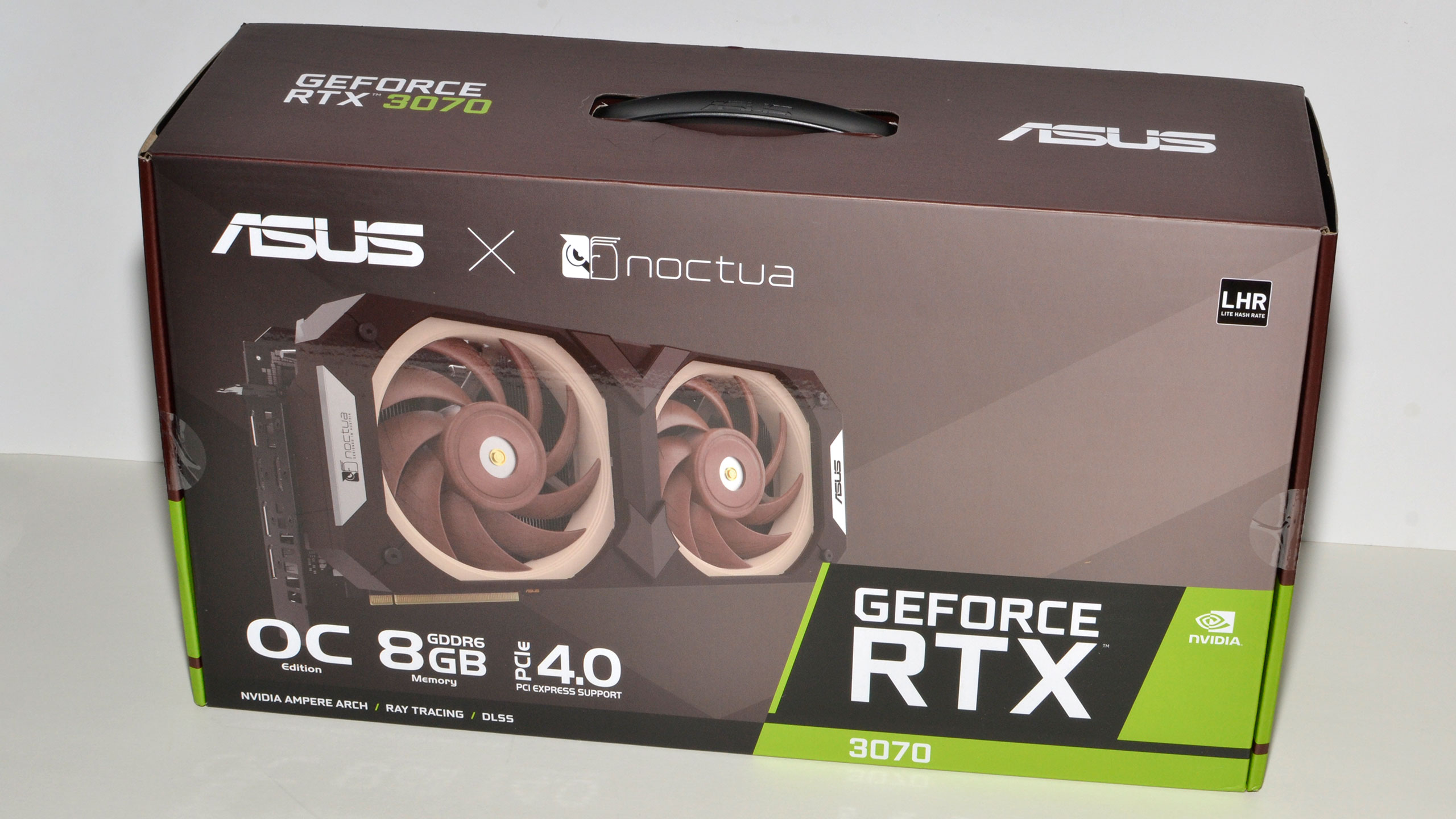
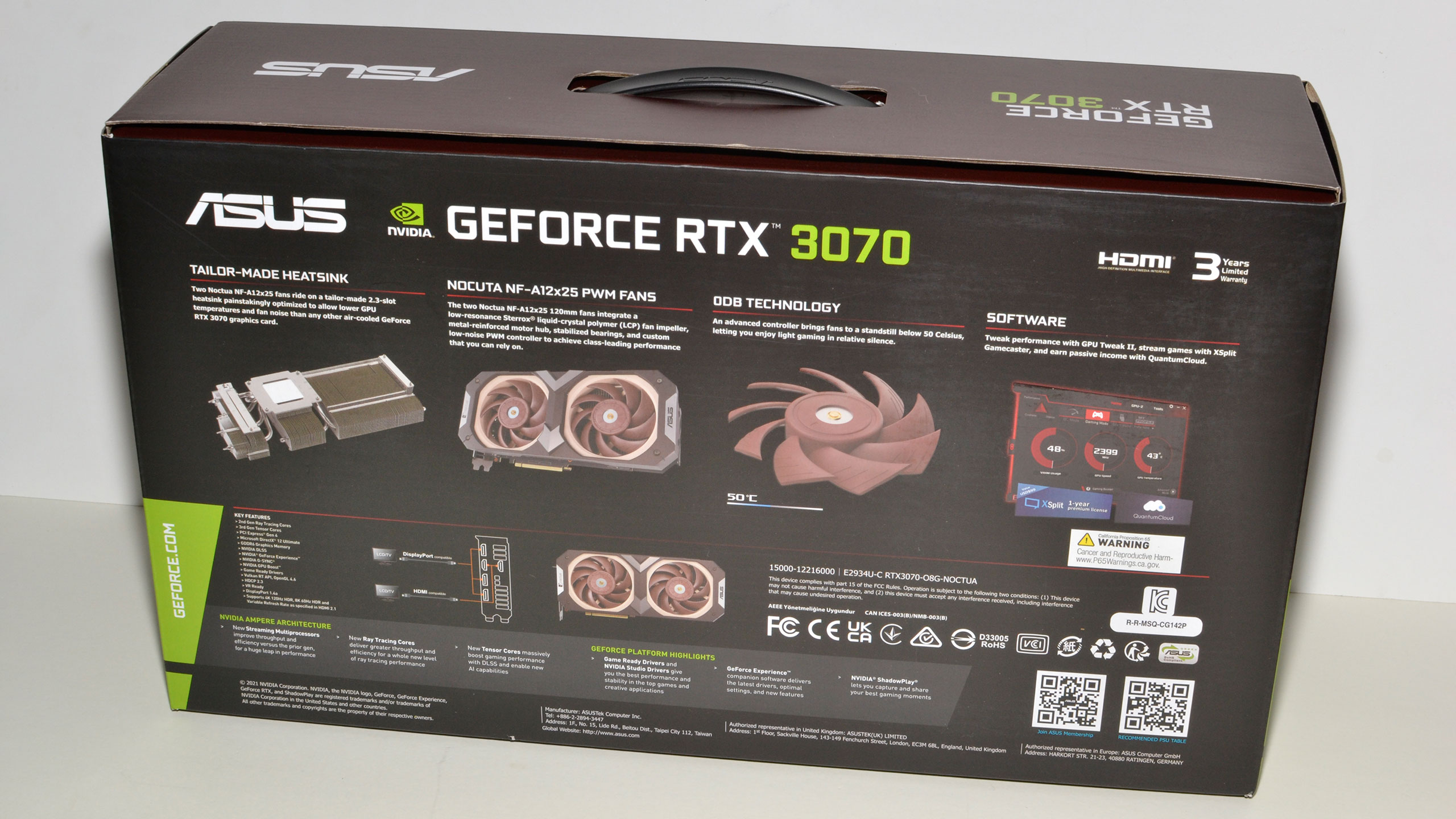
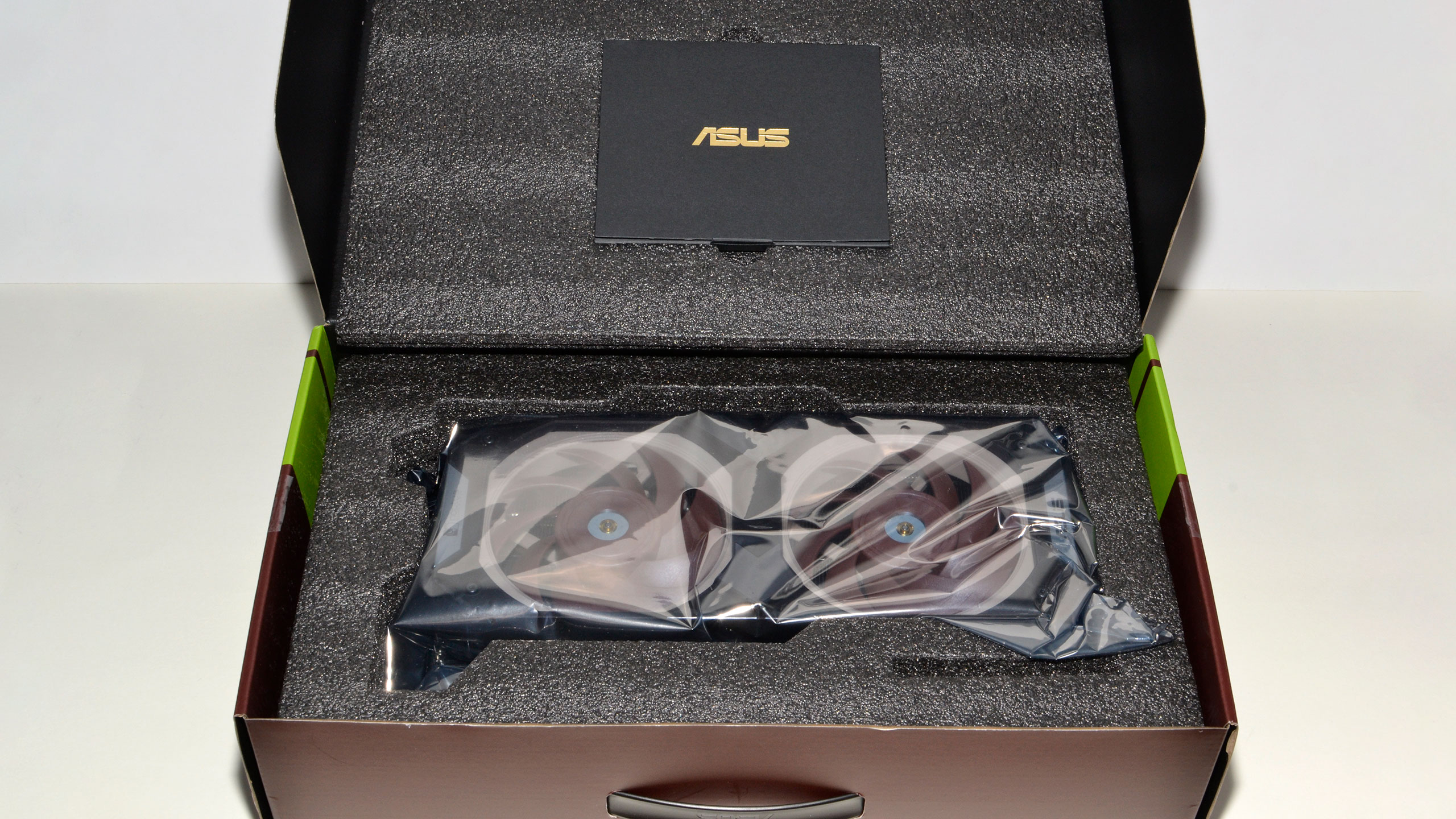
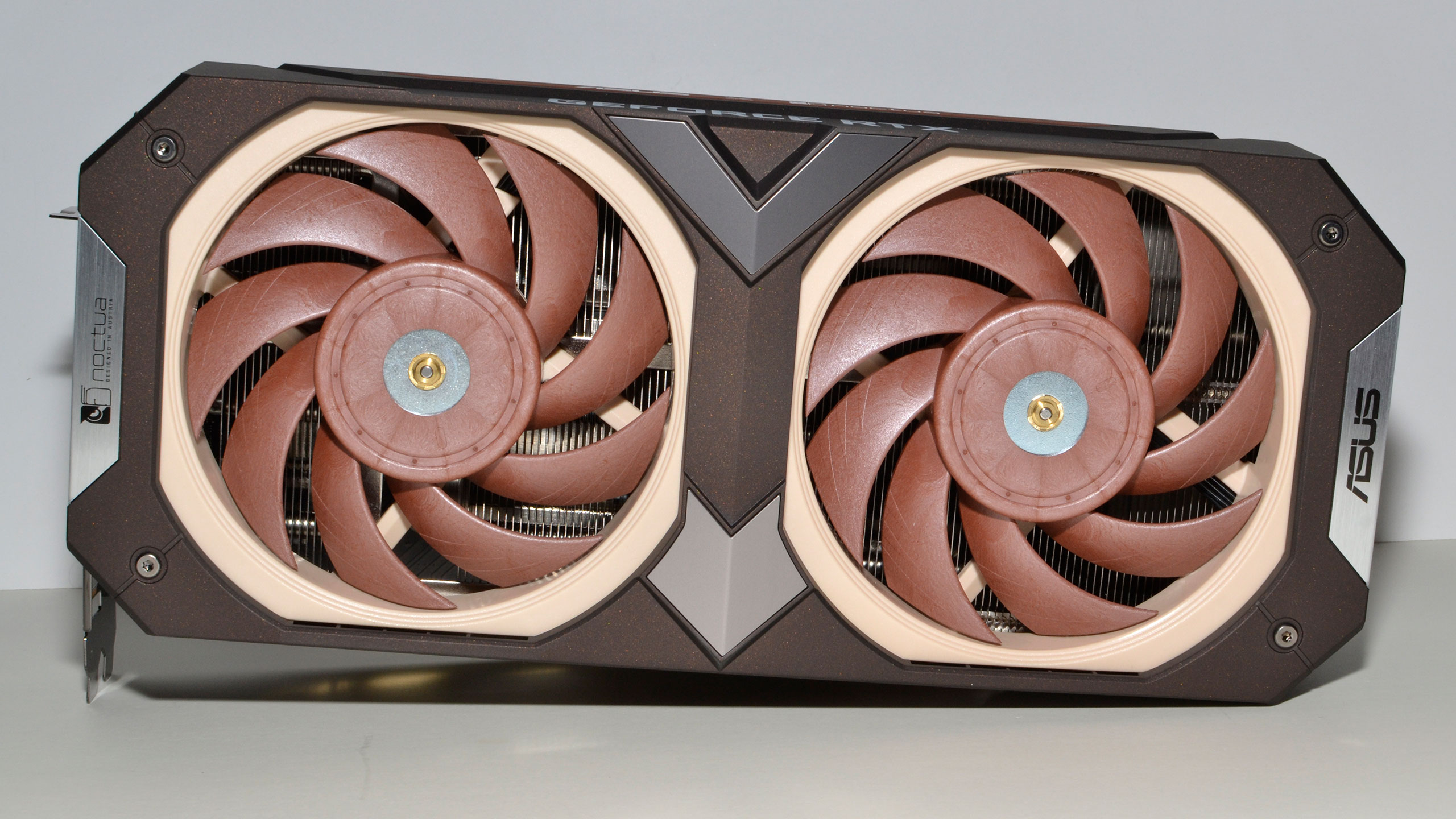
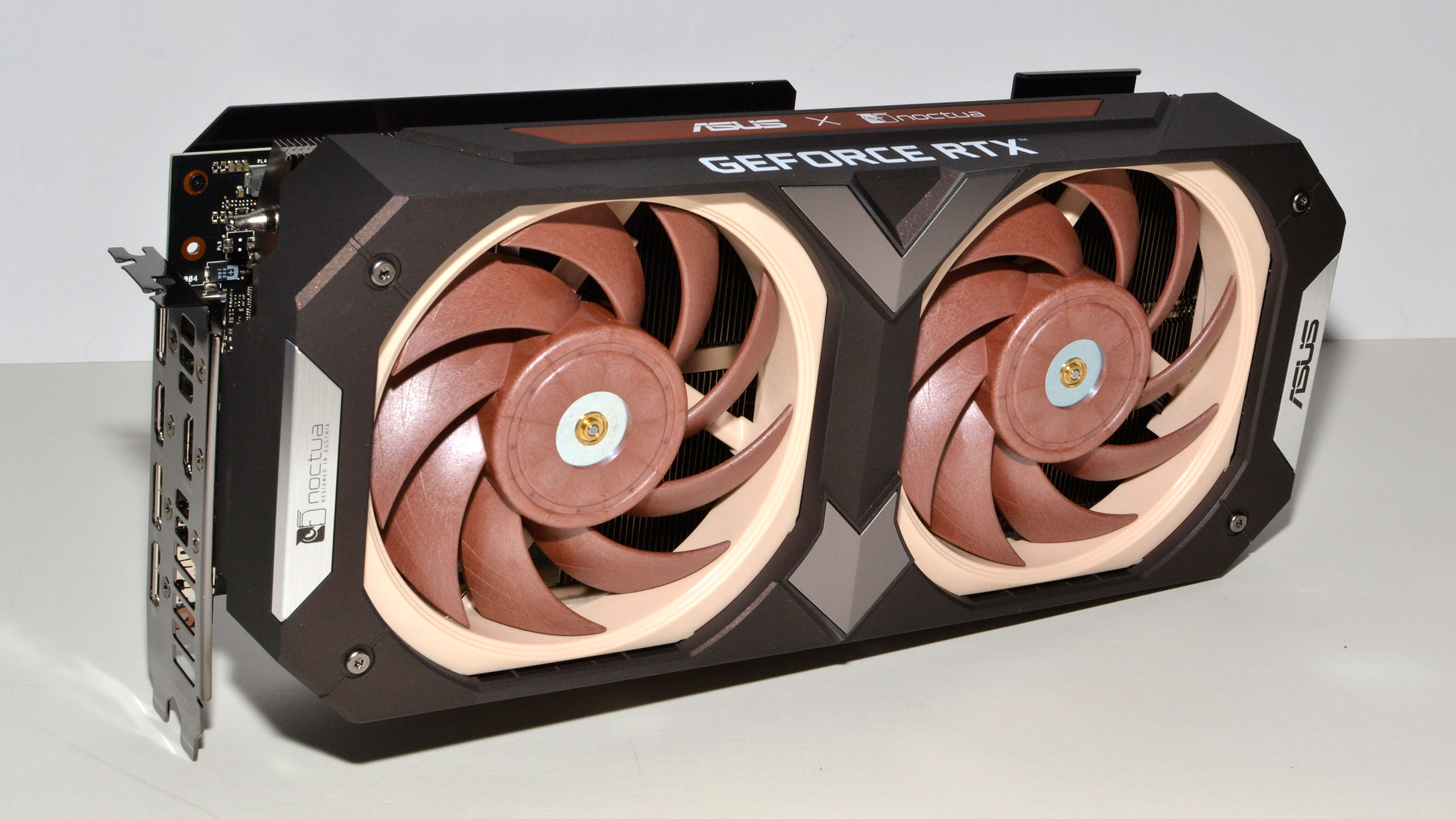
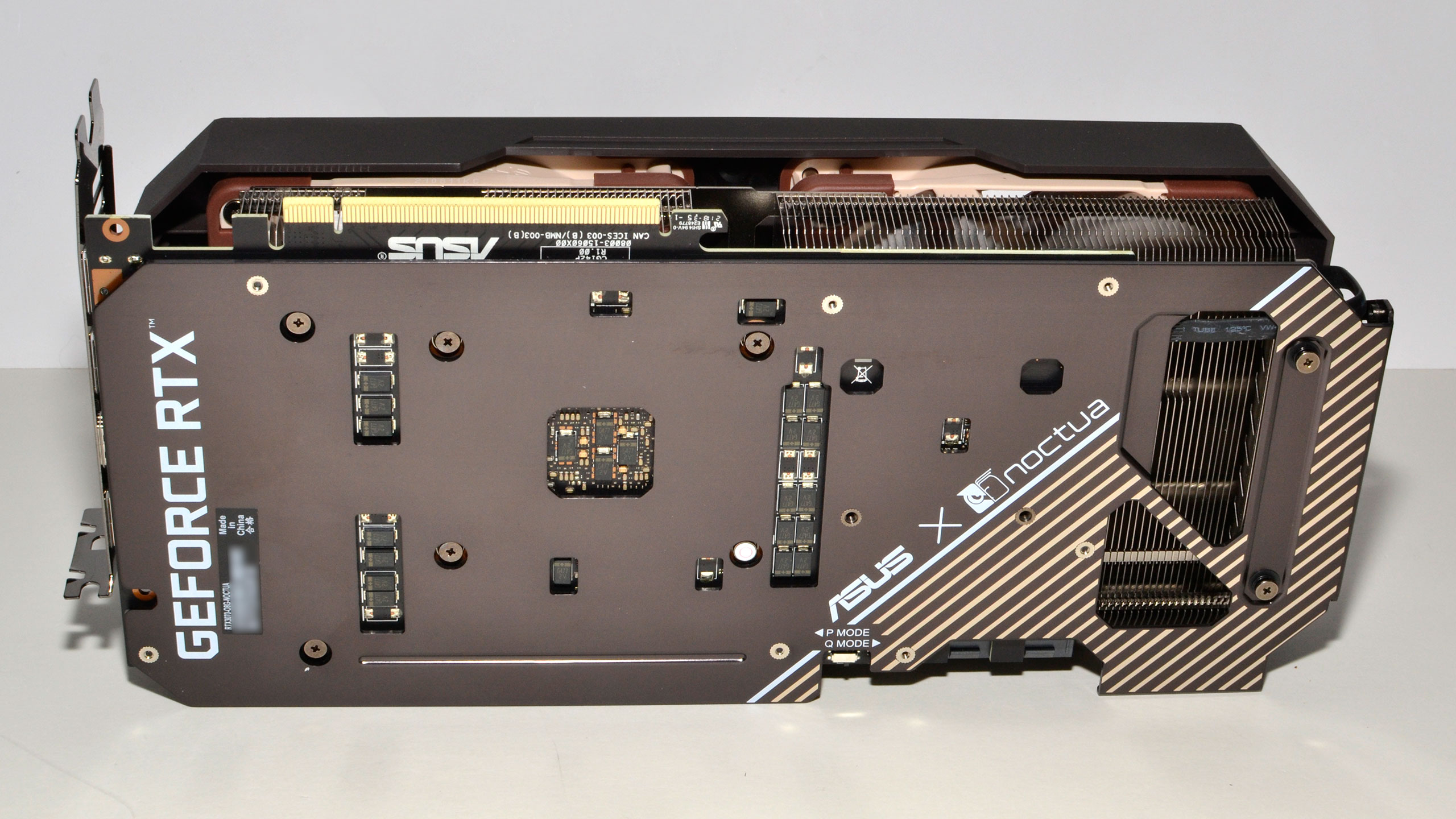
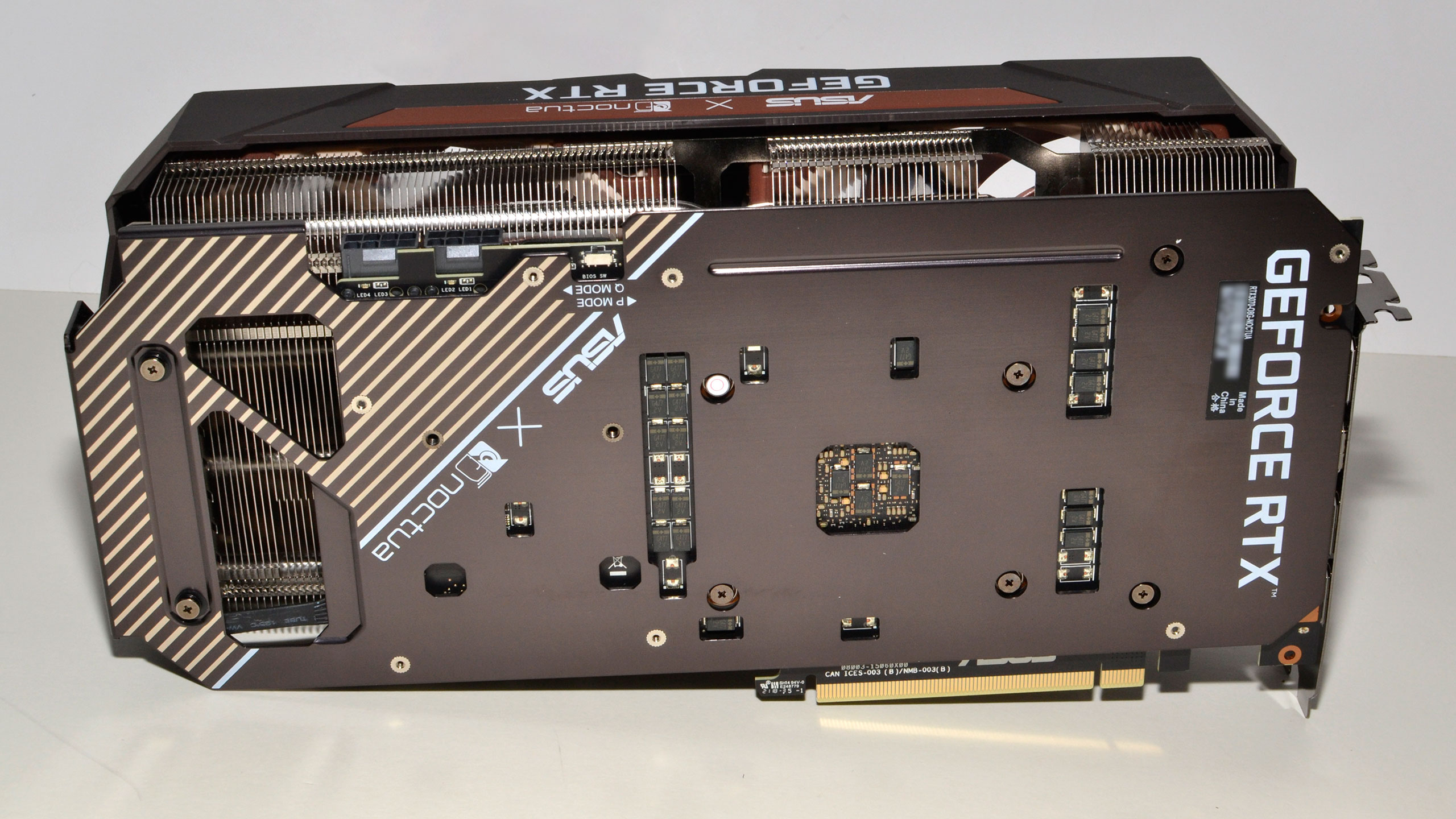
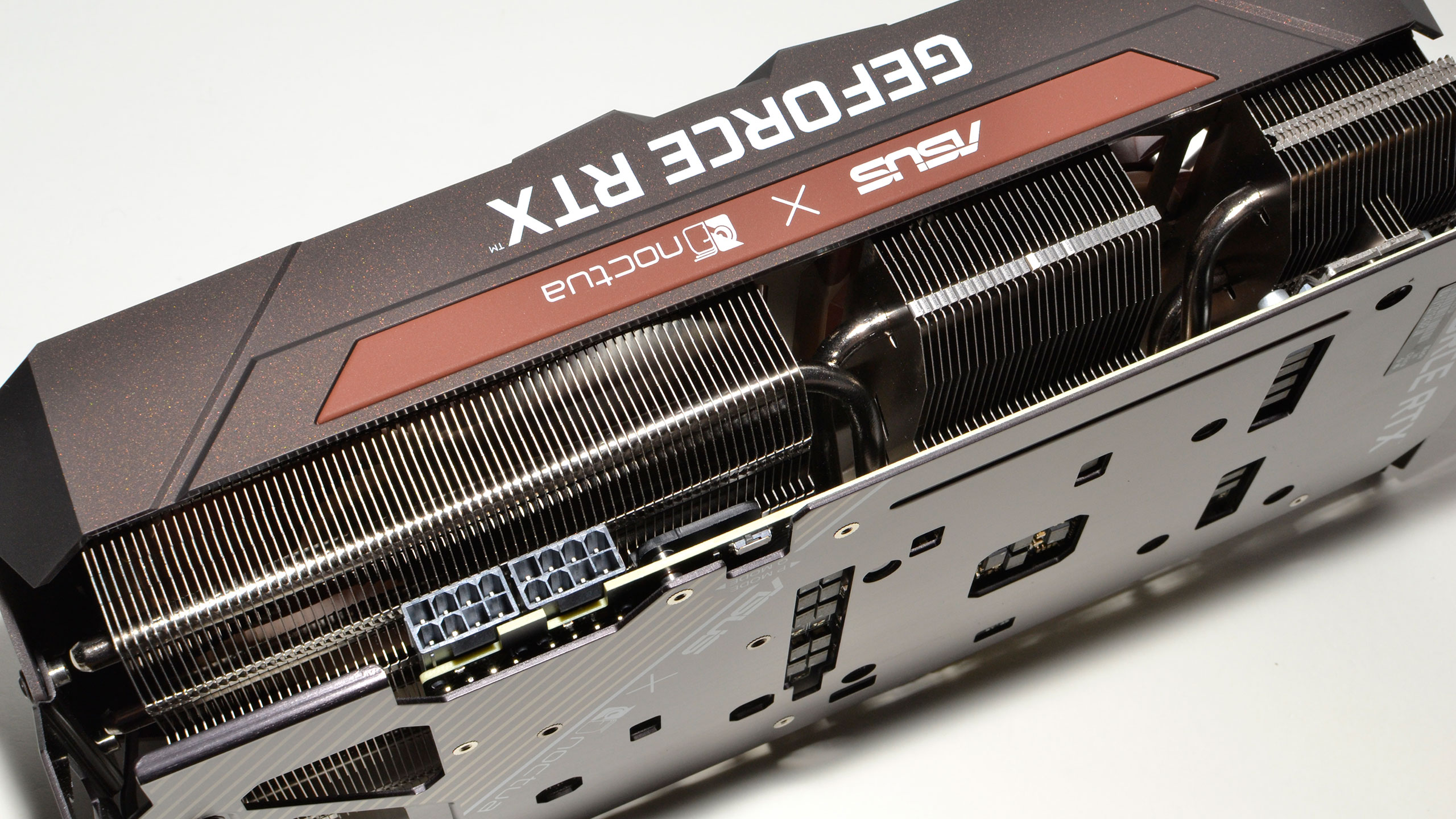
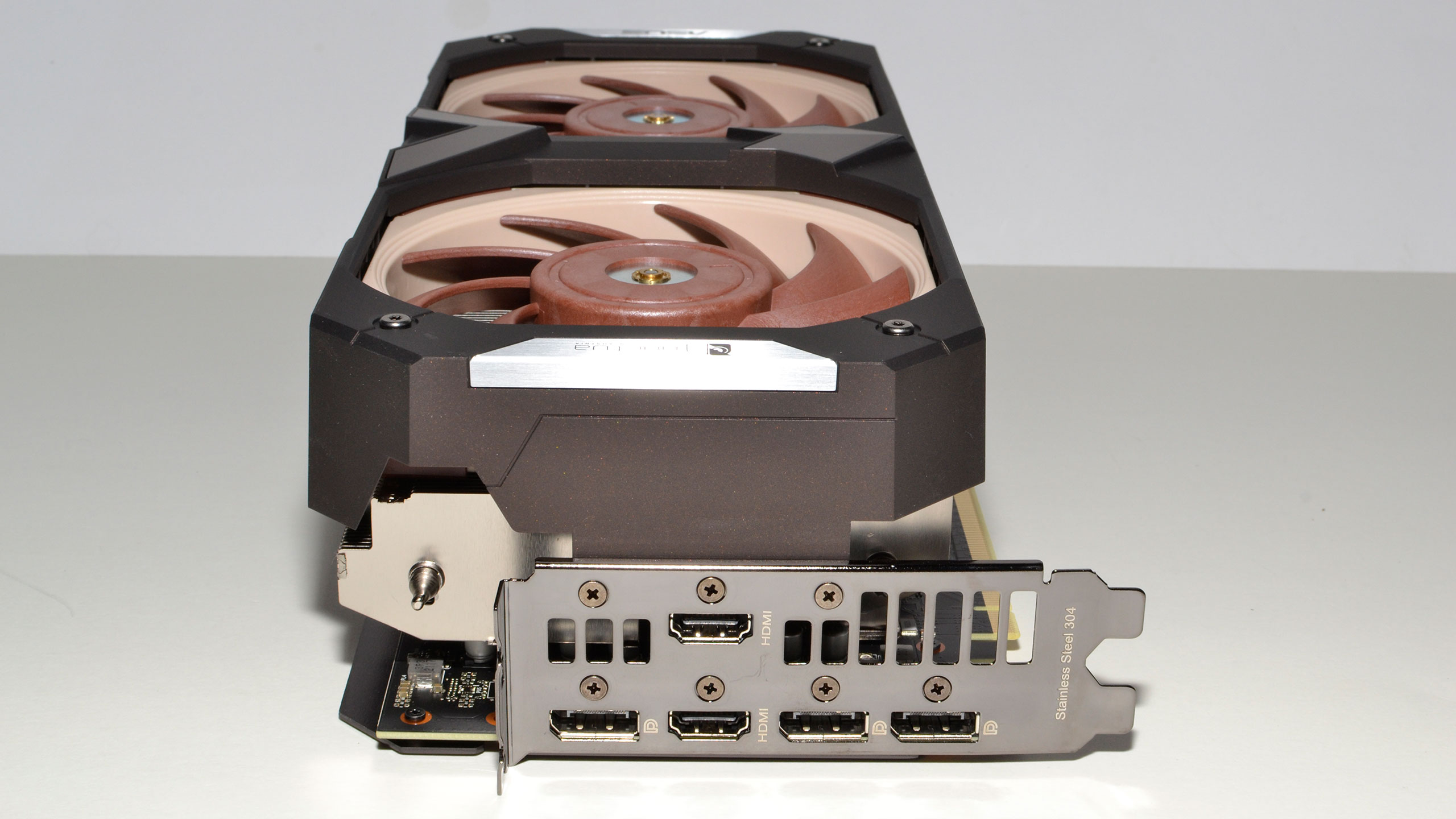
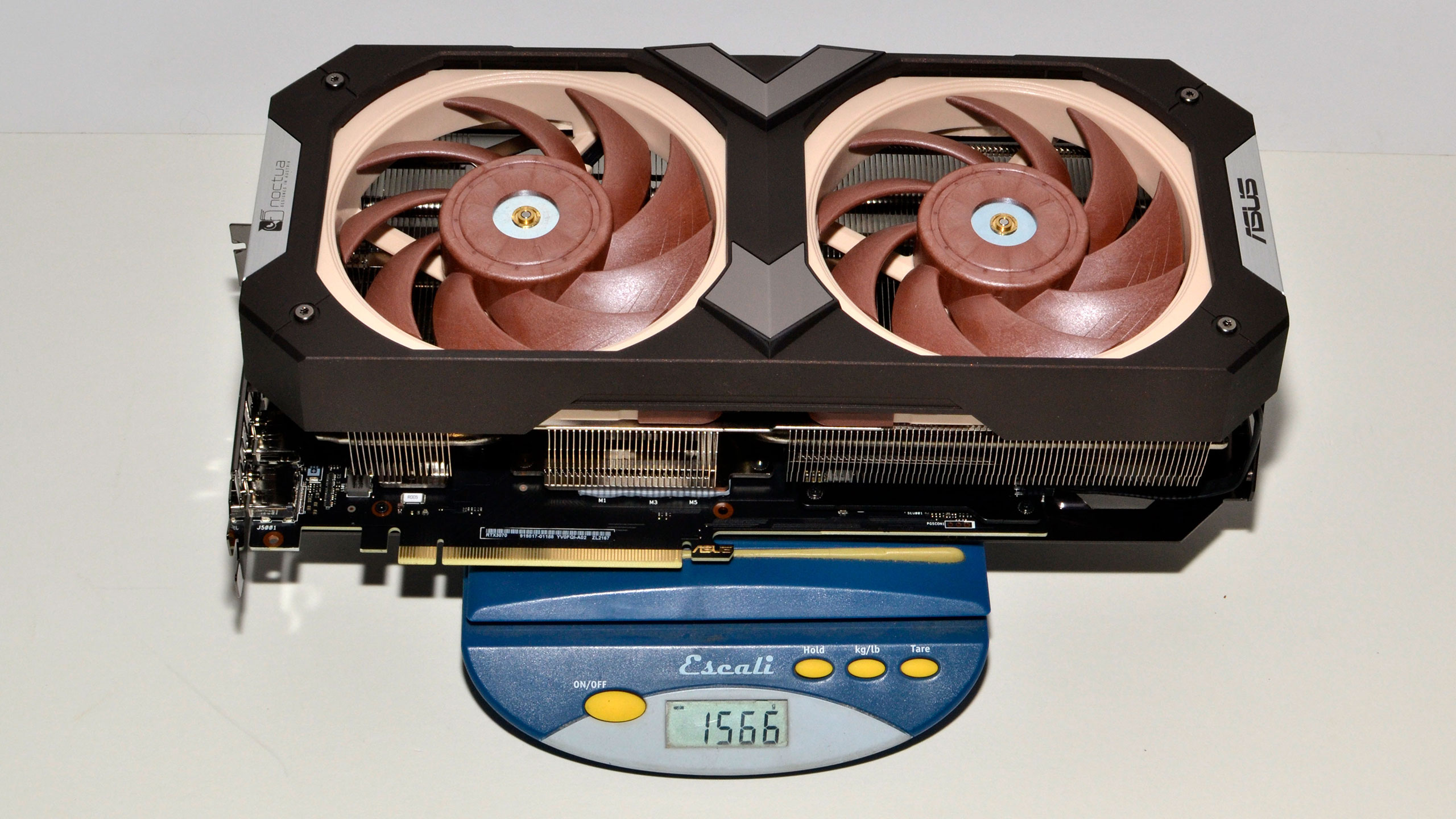
I've seen some cards that flirt with a 4-slot design in various ways — Gigabyte did some Aorus 3.5- to 4-slot width cards, and Colorful had the "hybrid" 4-fan card that used more than the traditional 3-slots with its RTX 3080 Ti. But this is the first true 4-slot GPU I've ever tested. I tried to take some comparison pictures with the Noctua model posted next to the other 3070 cards, but the pictures just don't do it justice. In person, the Noctua takes up a lot of space. Putting it in my test PC with a standard mid-tower ATX case, there's not much room for anything else.
Of course, the real stars of the show are the Noctua fans. They're standard 120mm Noctua designs, measuring 25mm thick and with a sufficiently large shroud to accommodate them. Despite the size, the fans don't necessarily move huge quantities of air, as they're relatively low RPM models. Asus didn't shrink the heatsink portion of the card to make room for the fans, however, which is how it ended up with the quadruple slot width — it's basically a 2.5-slot card and heatsink design paired with fans that take up an additional 1.5-slots of thickness.
Besides being the traditional tan and brown associated with Noctua fans, note also that there's absolutely no RGB lighting on Asus' Noctua card. Presumably, that's because one of Noctua's driving principles is that you shouldn't notice the fans. They're there to do a job, not to draw attention through flashing lights or other gimmicks. That means you won't have to worry about deciding what color of lighting goes best with brown, and you also don't need to install Asus' Aura Sync software, at least not for the graphics card.
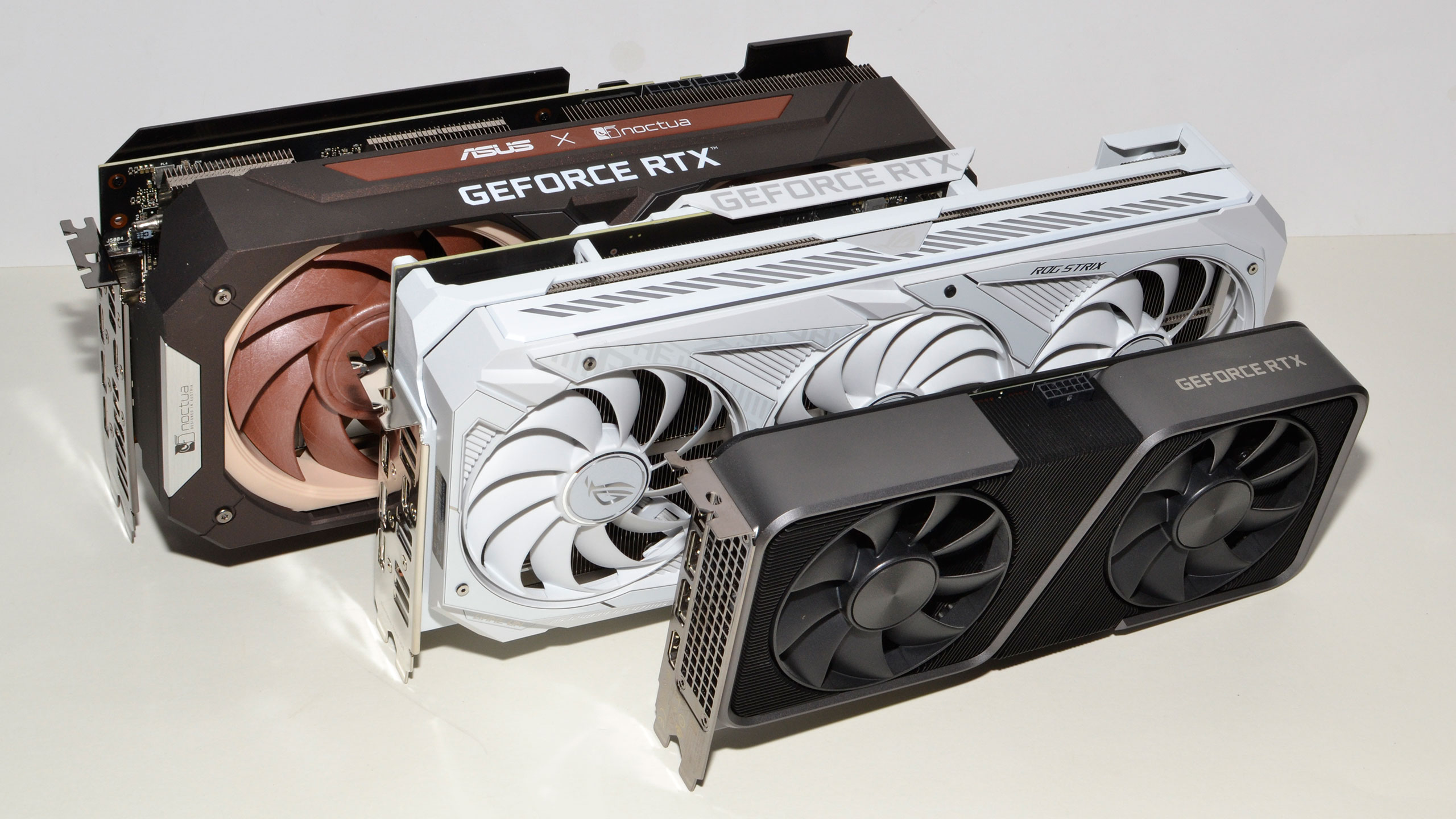
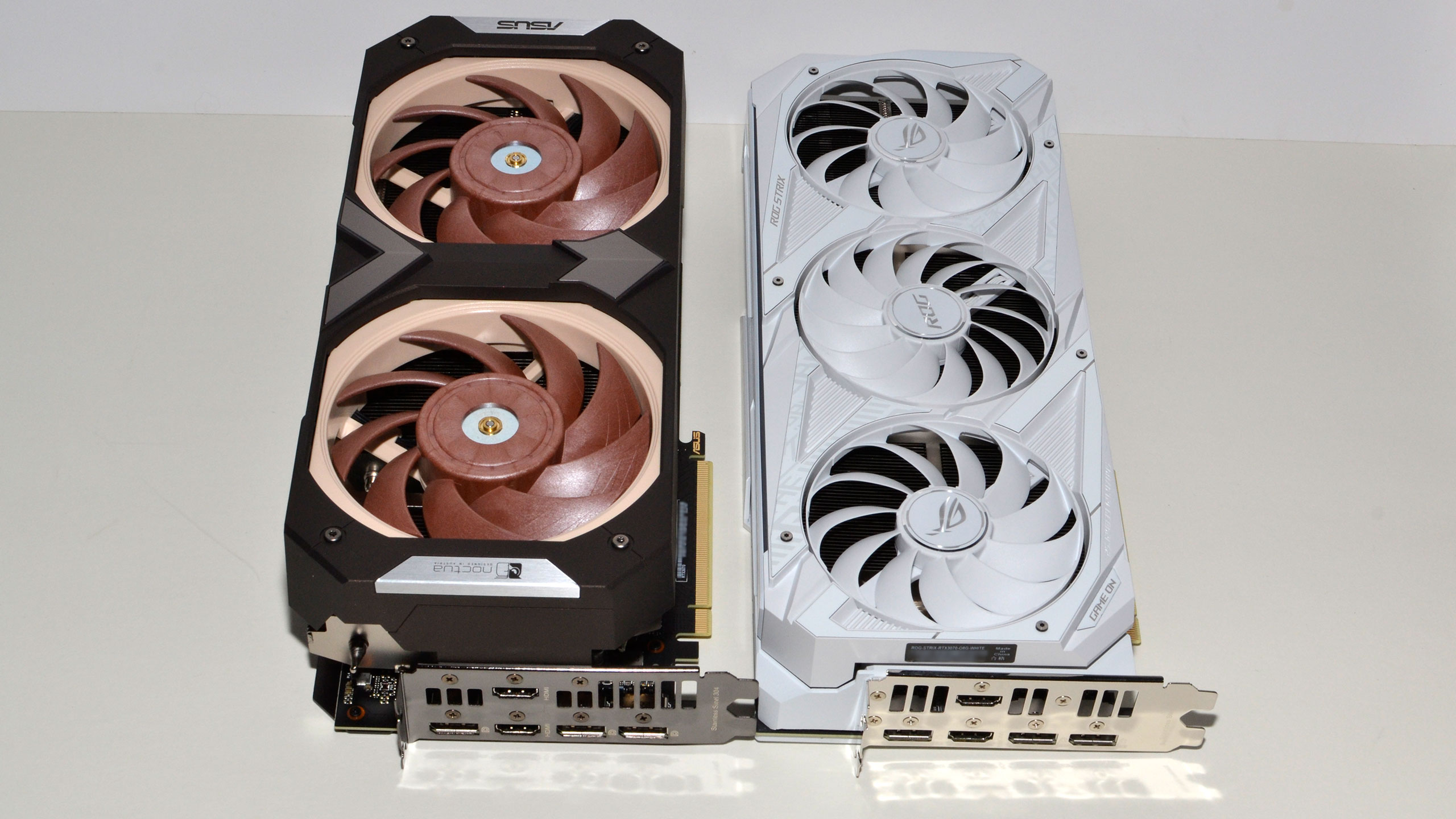
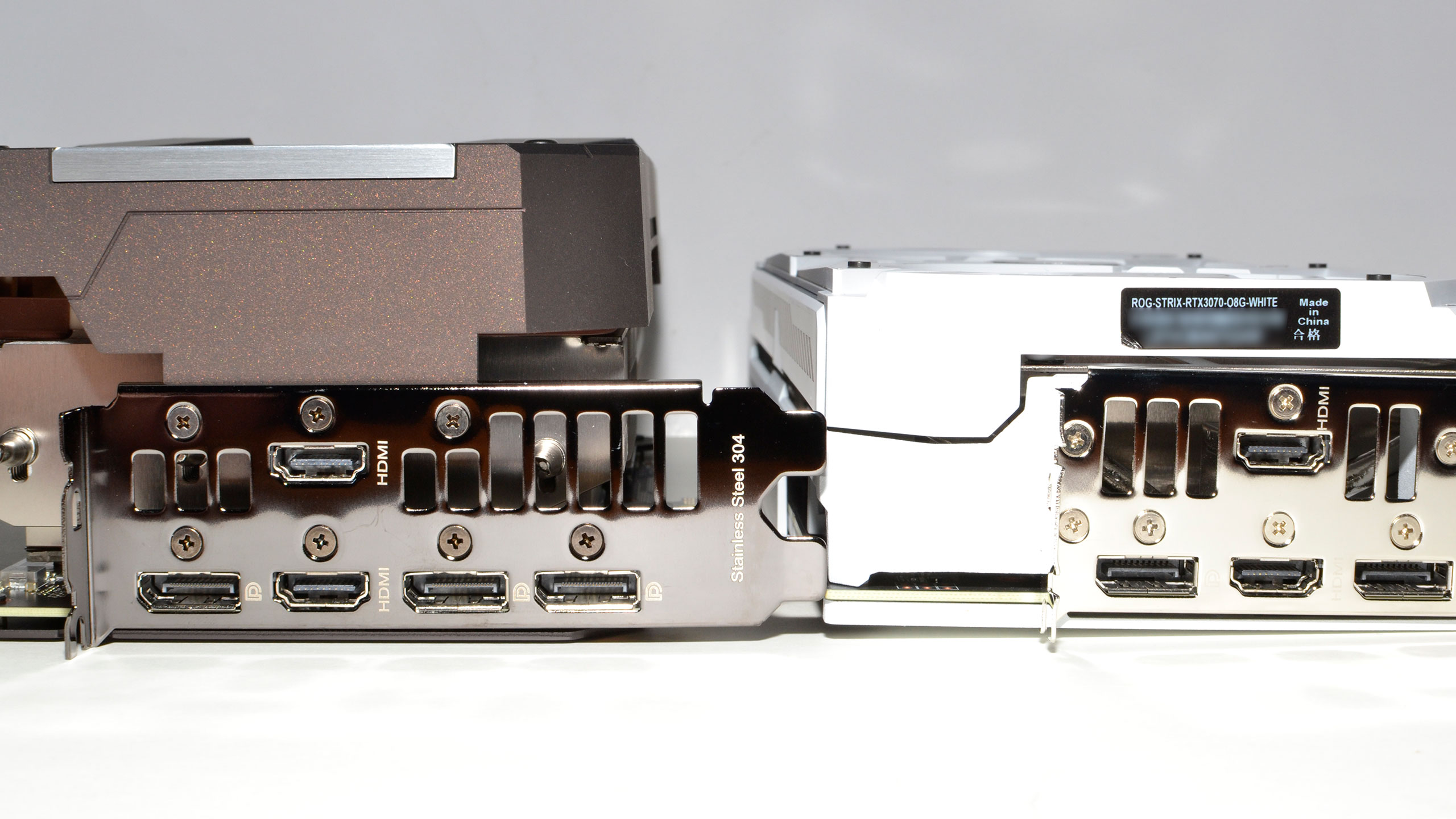
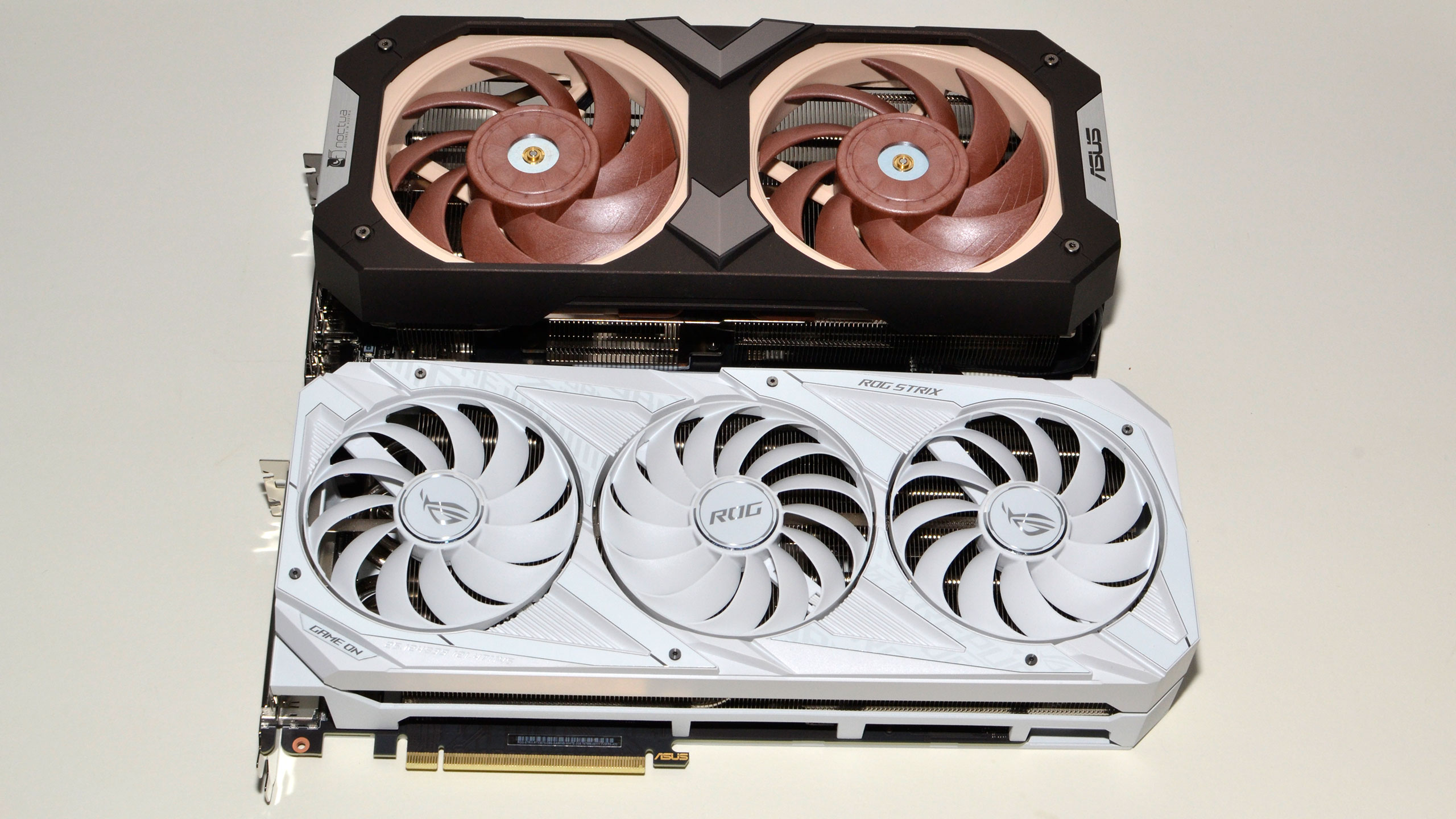
Like other Asus cards, the Noctua comes with a switch that allows you to select "Performance" or "Quiet" mode, both of which slightly alter the GPU's power target and clocks. Installing GPU Tweak III can accomplish the same thing, and opens the door to a third "OC Mode" that bumps up the power limit and increases the boost clock by 30MHz. We used OC mode for all of our performance tests (on both Asus cards), but we did do a few spot checks that indicate it only adds about 1–2% more performance than the default mode of operation.
It would be interesting to be able to directly compare the cooling and performance of the Noctua card with the Strix card, but differences in power targets and clocks make that a bit apples and oranges. Asus bins its GPUs to find those that can reach the highest stable clocks, and they end up in the ROG Strix models. The Noctua card ends up at a slight disadvantage, with "second-tier" GPUs and reduced clocks — you can try to manually overclock the card, and likely come close to the same performance as the Strix, but there's definitely a difference in the GPUs due to binning. How would the Noctua cooler fare with the first-tier GPU? We can't say for certain, though as we'll see later, it would likely do just as well as the Strix design, if not better.
Test Setup for Asus RTX 3070 Noctua
This is likely our final GPU review using our Core i9-9900K testbed. We've got most of the parts for a Core i9-12900K upgrade, which should suffice for at least a couple years of GPU benchmarks. And we'll have to retest everything when we make the switch. We'll also be updating our test suite for 2022, but it was still the tail-end of 2021 when we wrapped up this review, so let's roll with it.
All of the RTX 3070 cards were retested with the latest (at the time of testing) Nvidia 497.09 drivers, though the 497.29 drivers came out a few days after testing was completed. It's worth noting here that none of the other RTX 30-series GPUs were retested in the past two months, and at least one game (Assassin's Creed Valhalla) appears to have benefited from recent driver and/or game updates.
We currently test third-party cards with our 13-game test suite, running at 4K, 1440p, and 1080p at ultra (or equivalent) settings. We'll focus primarily on how the Asus RTX 3070 Noctua fares against other 3070 cards, though we'll have representatives of the rest of the current AMD and Nvidia GPUs in the charts as well. Each test setting gets run multiple times, to ensure the consistency of our results.
Nvidia's RTX 3070 currently ranks as one of the most popular RTX 30-series GPUs, according to the Steam Hardware Survey. Grains of salt and all that, but only the RTX 3060 for laptops ranks higher in the API data, by 0.02%. The Asus 3070 Noctua model does implement Nvidia's LHR (lite hash rate) mining limiter, which drops Ethereum mining performance down to around 42 MH/s after tuning, but for regular gaming, the newer spins of the RTX 3070 should perform just as well as the older variants. Note also that the Strix White card is a non-LHR card and can do around 60 MH/s at mining, if that's what you're after — it's effectively been discontinued and replaced by a V2 LHR variant now.
Gaming Performance on the Asus RTX 3070 Noctua
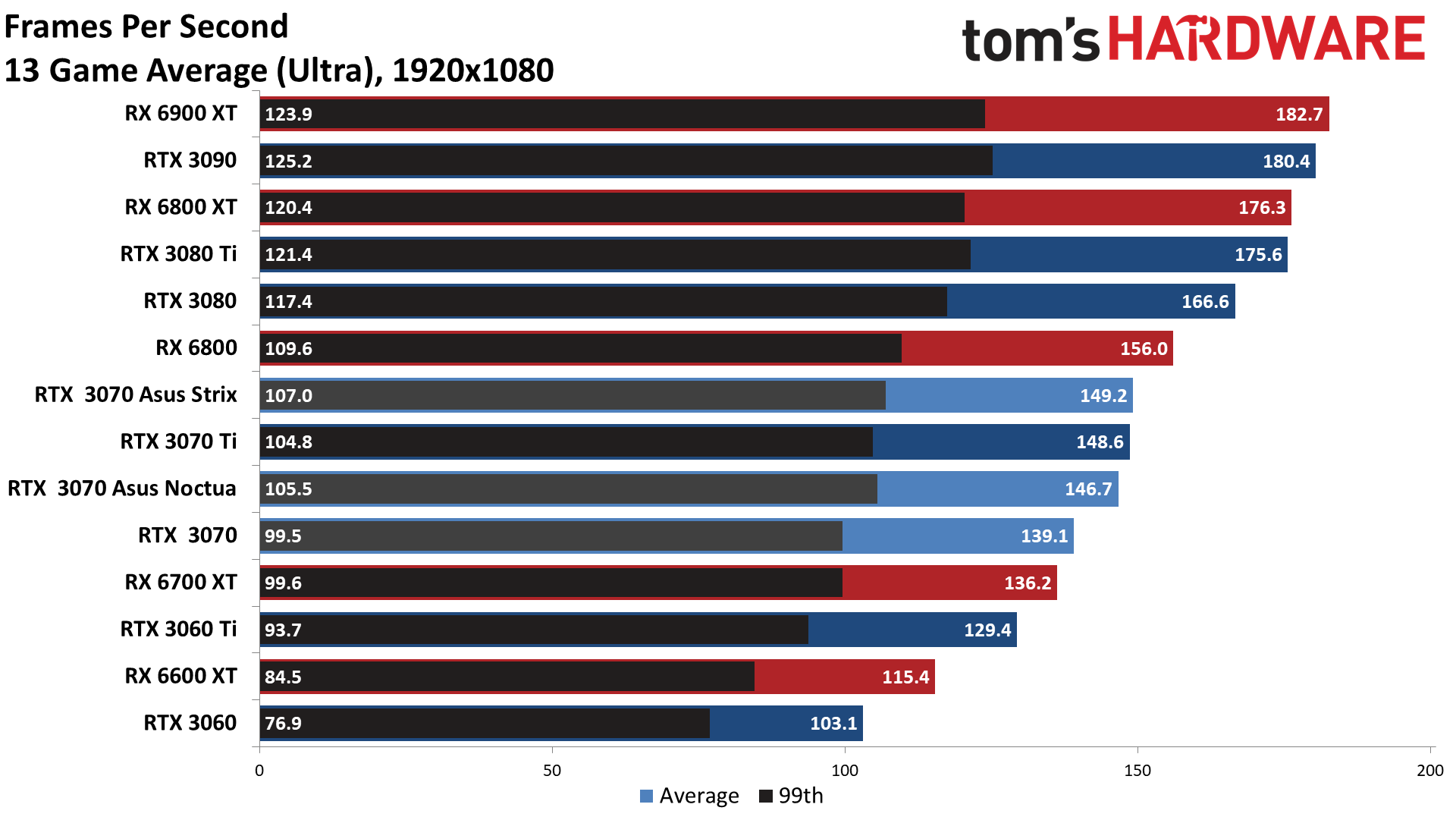
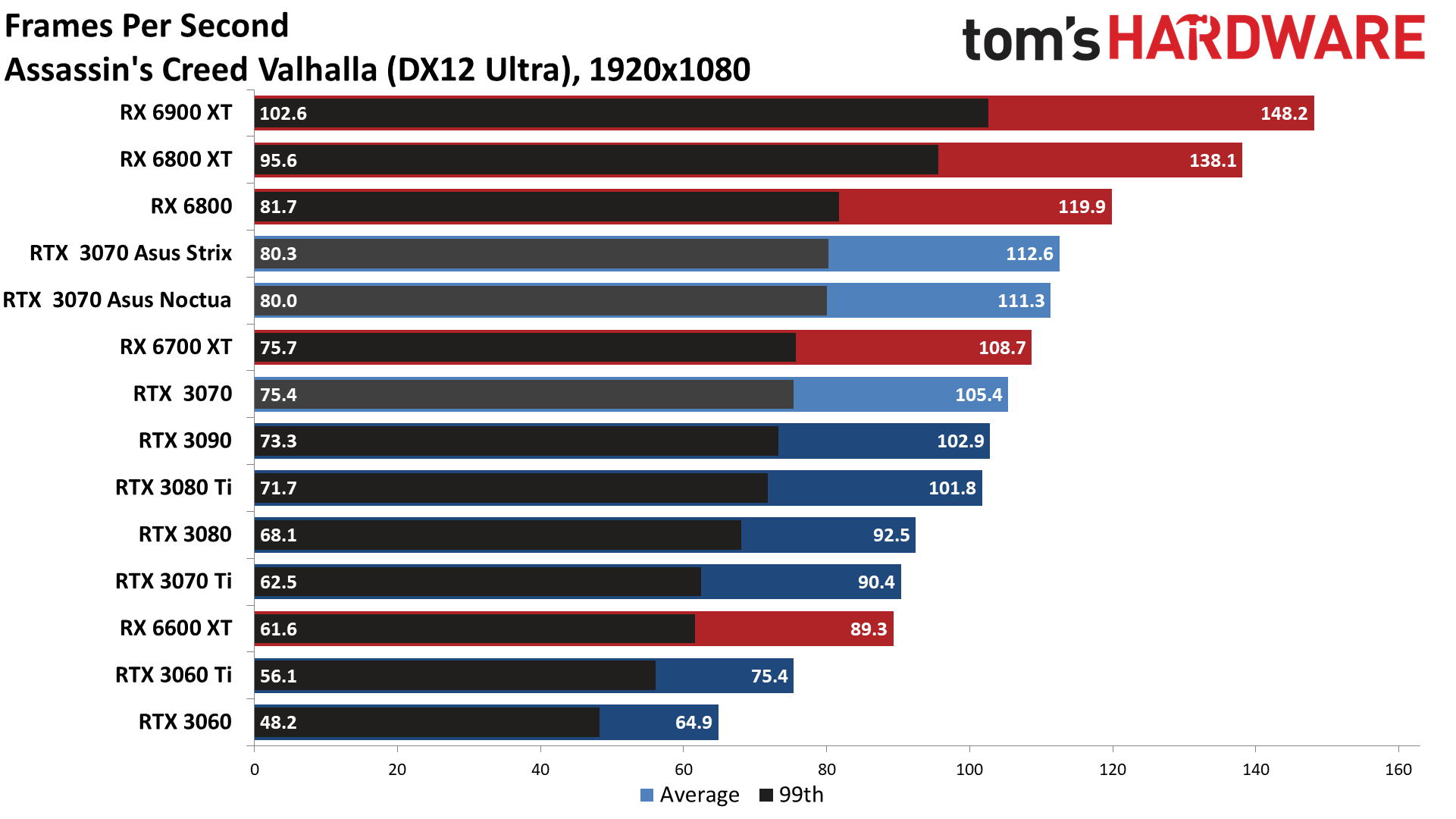
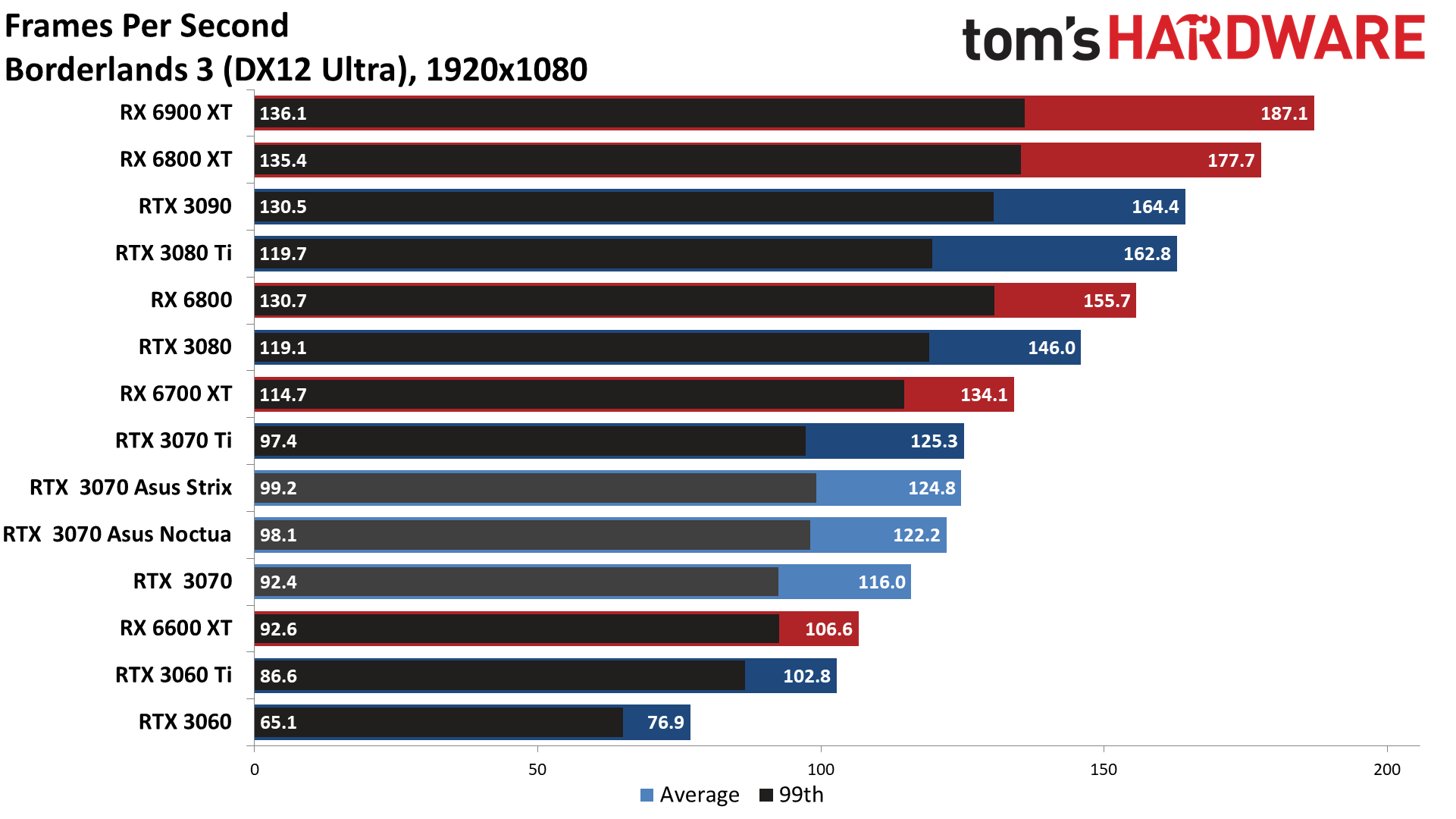
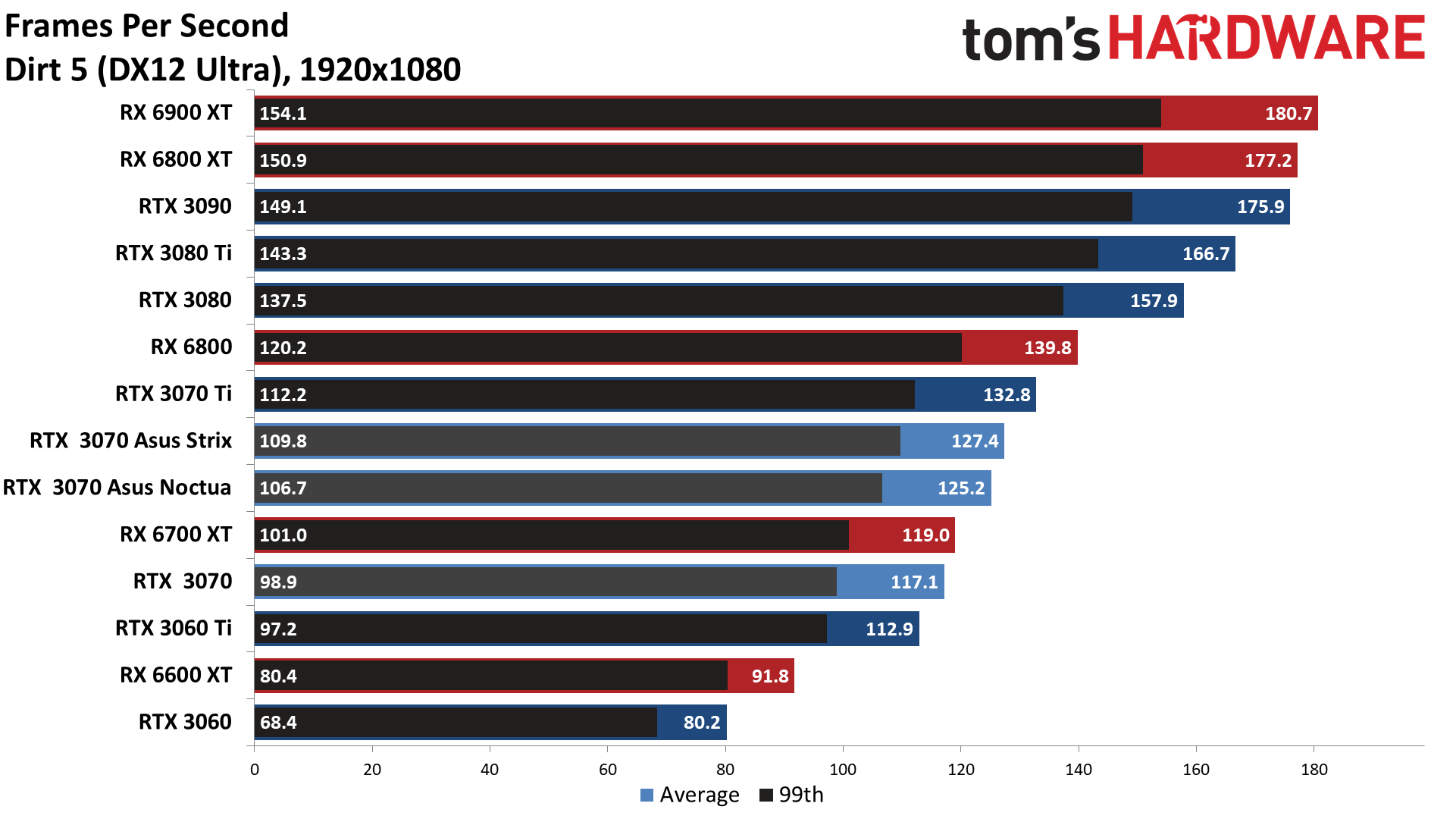
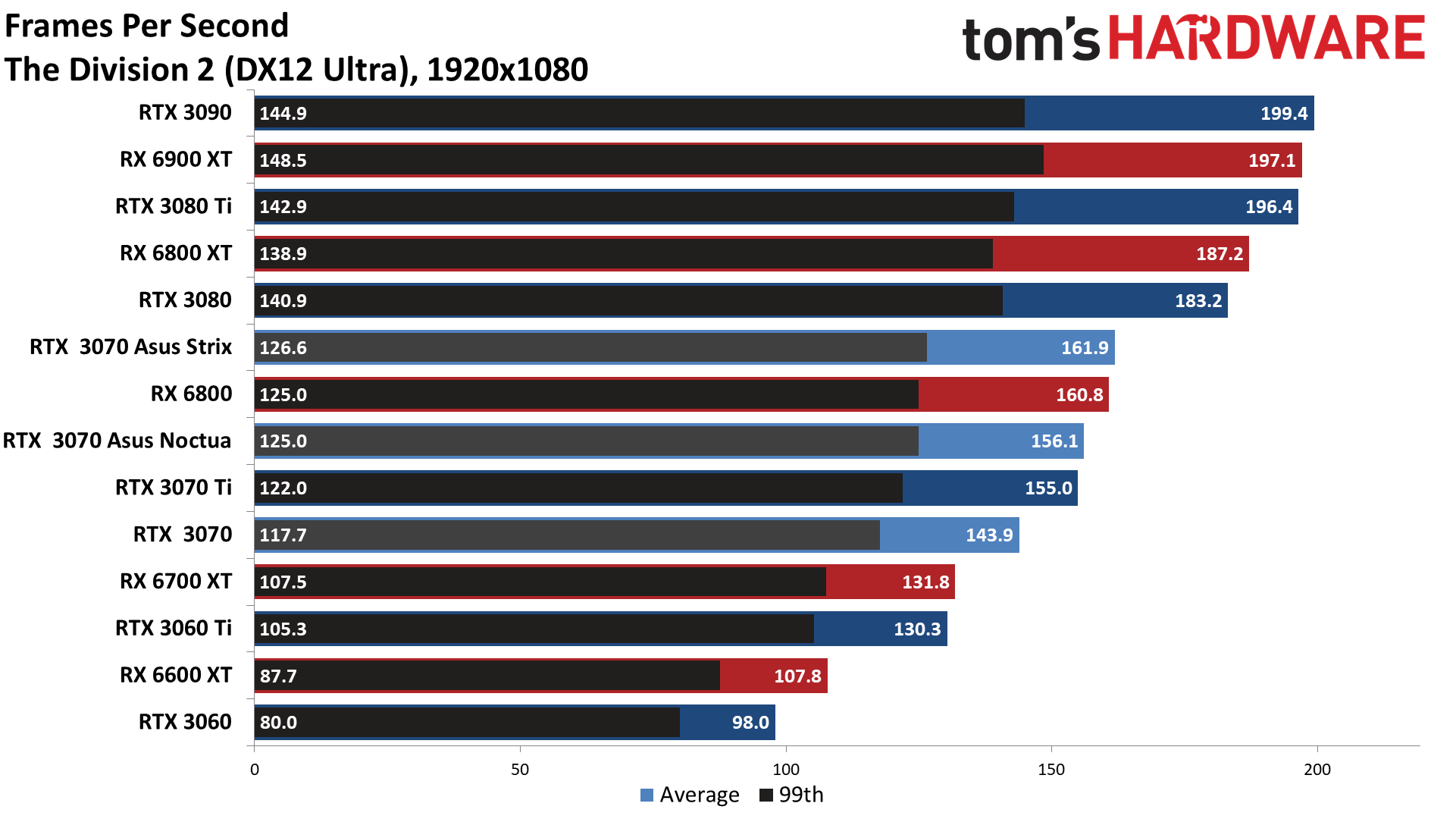
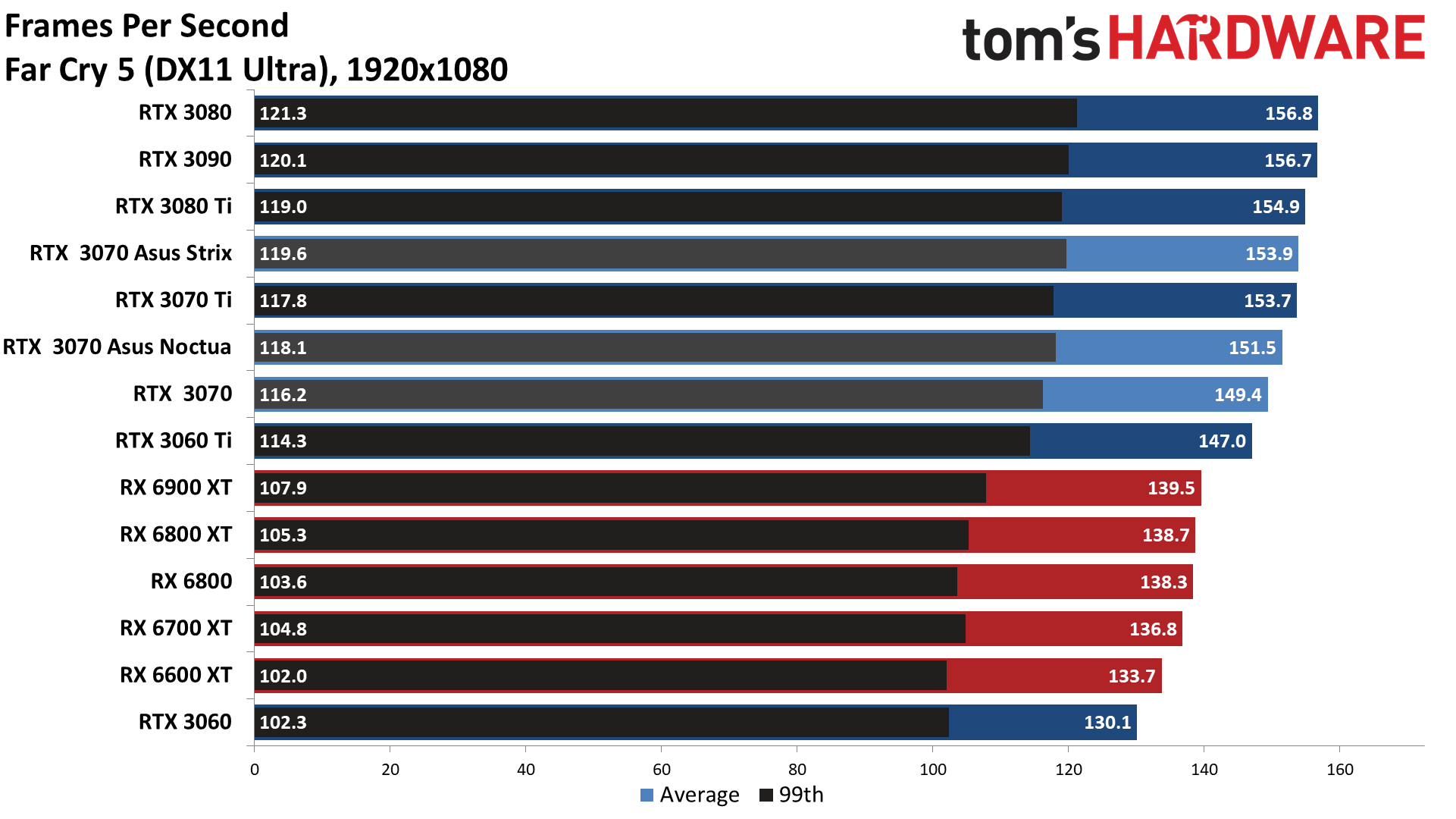
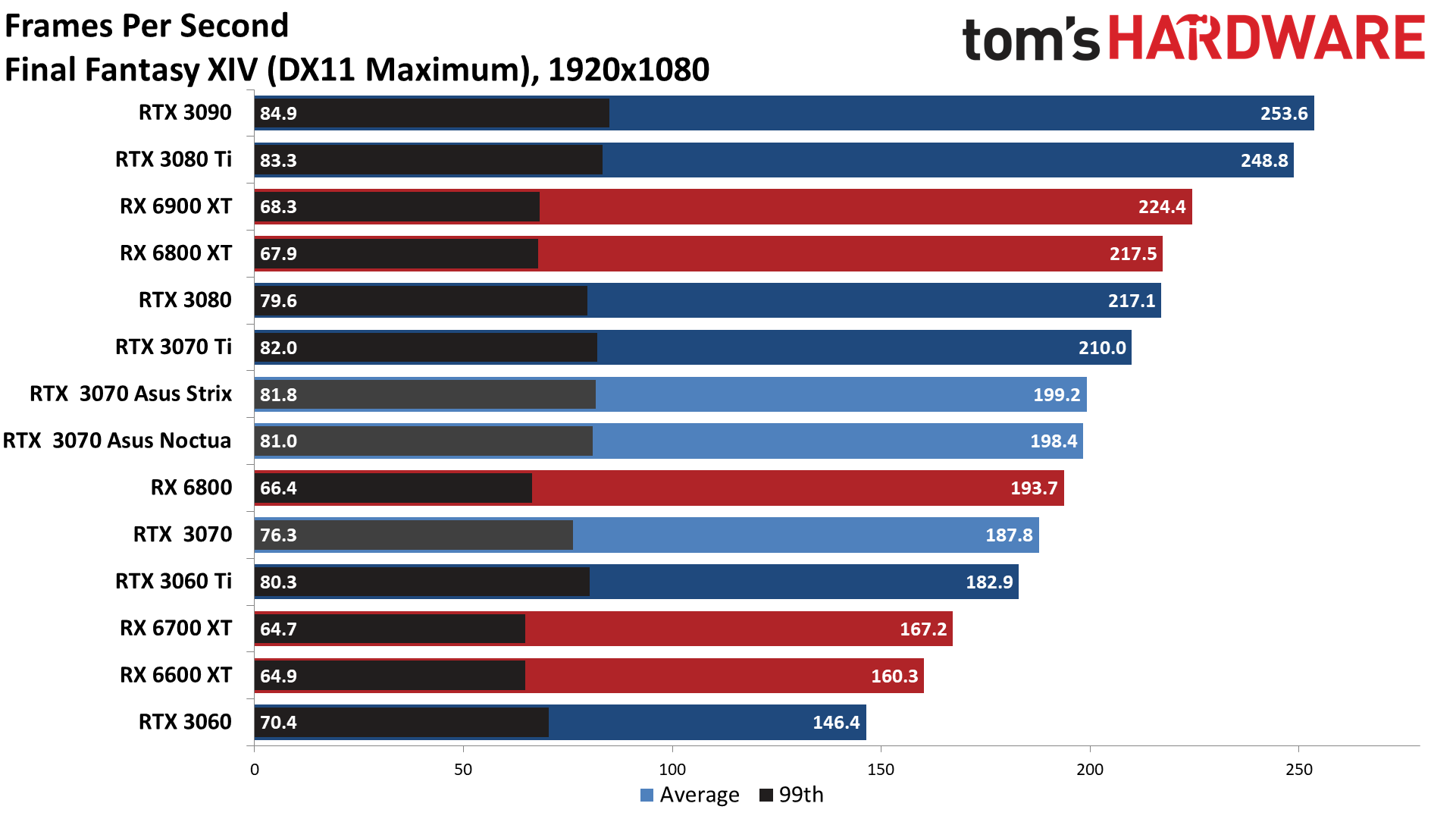
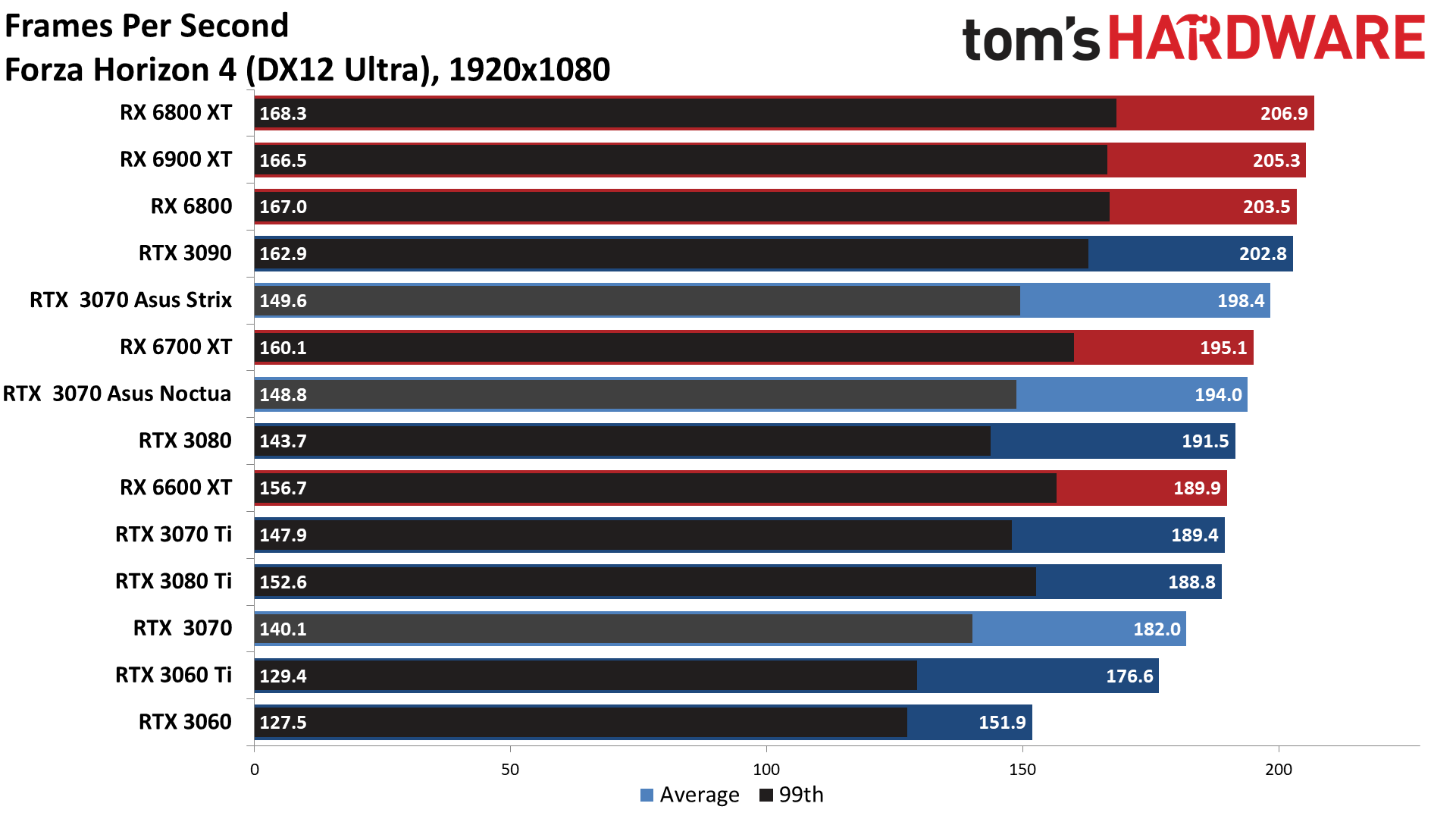
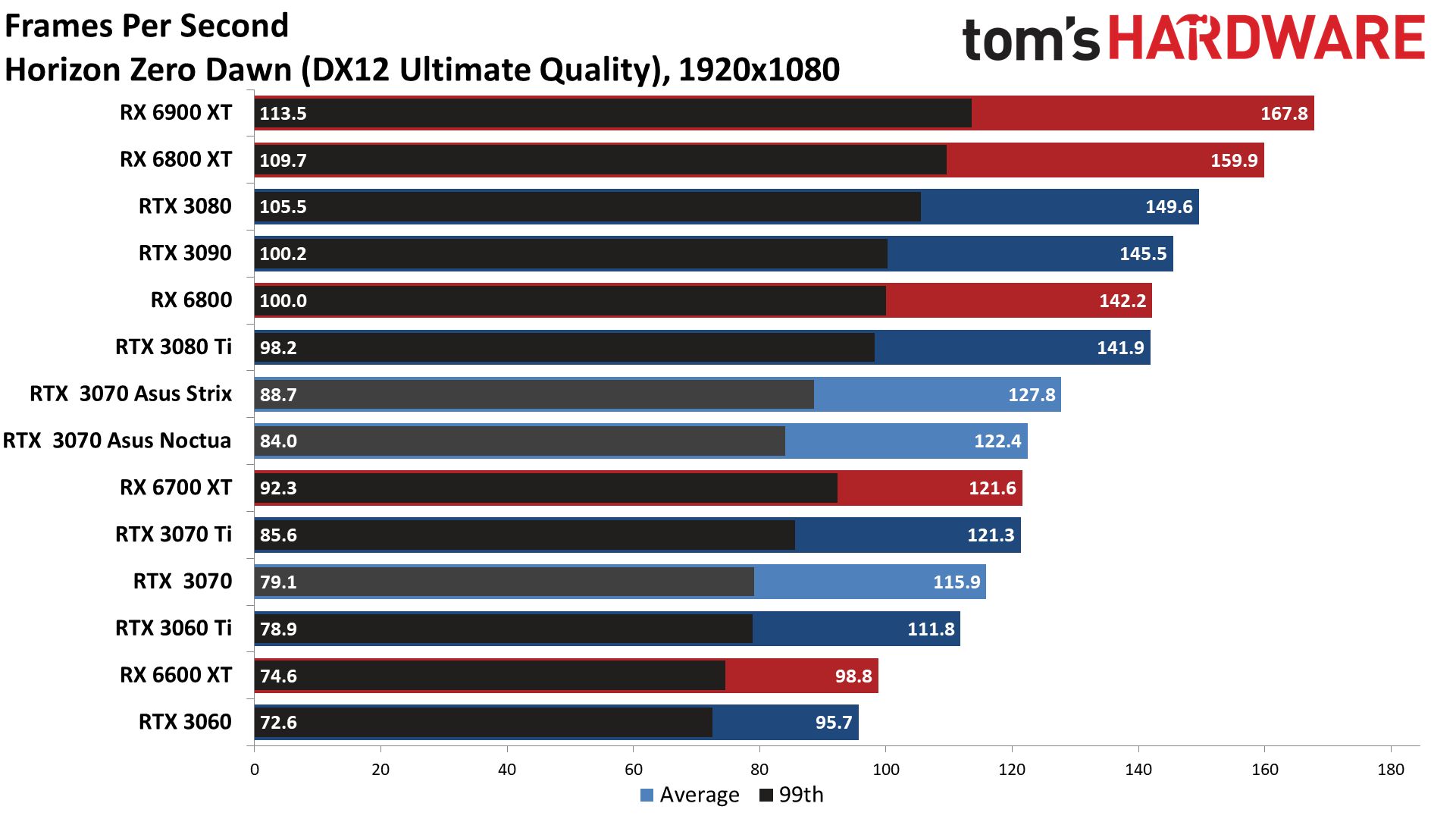
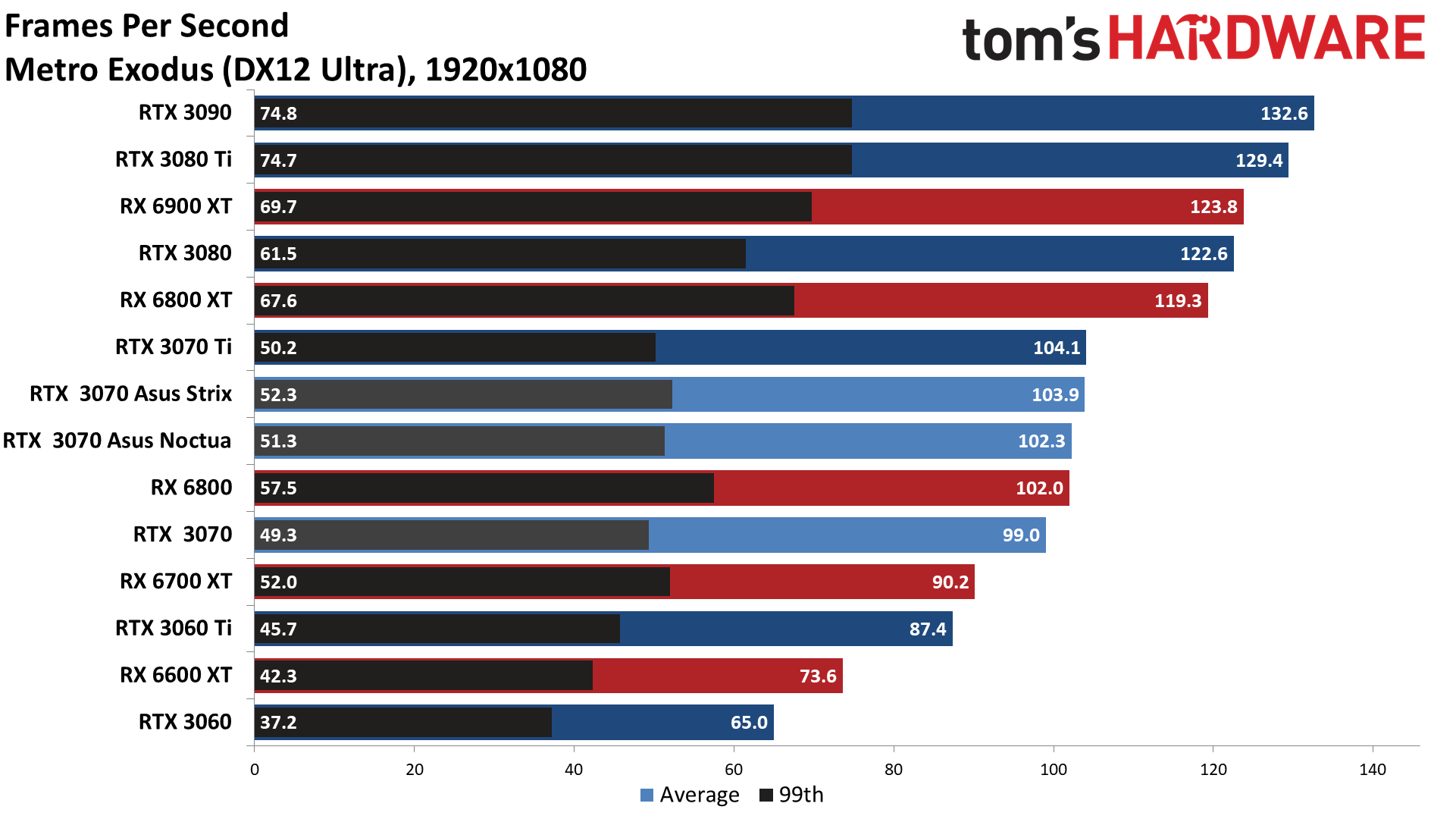
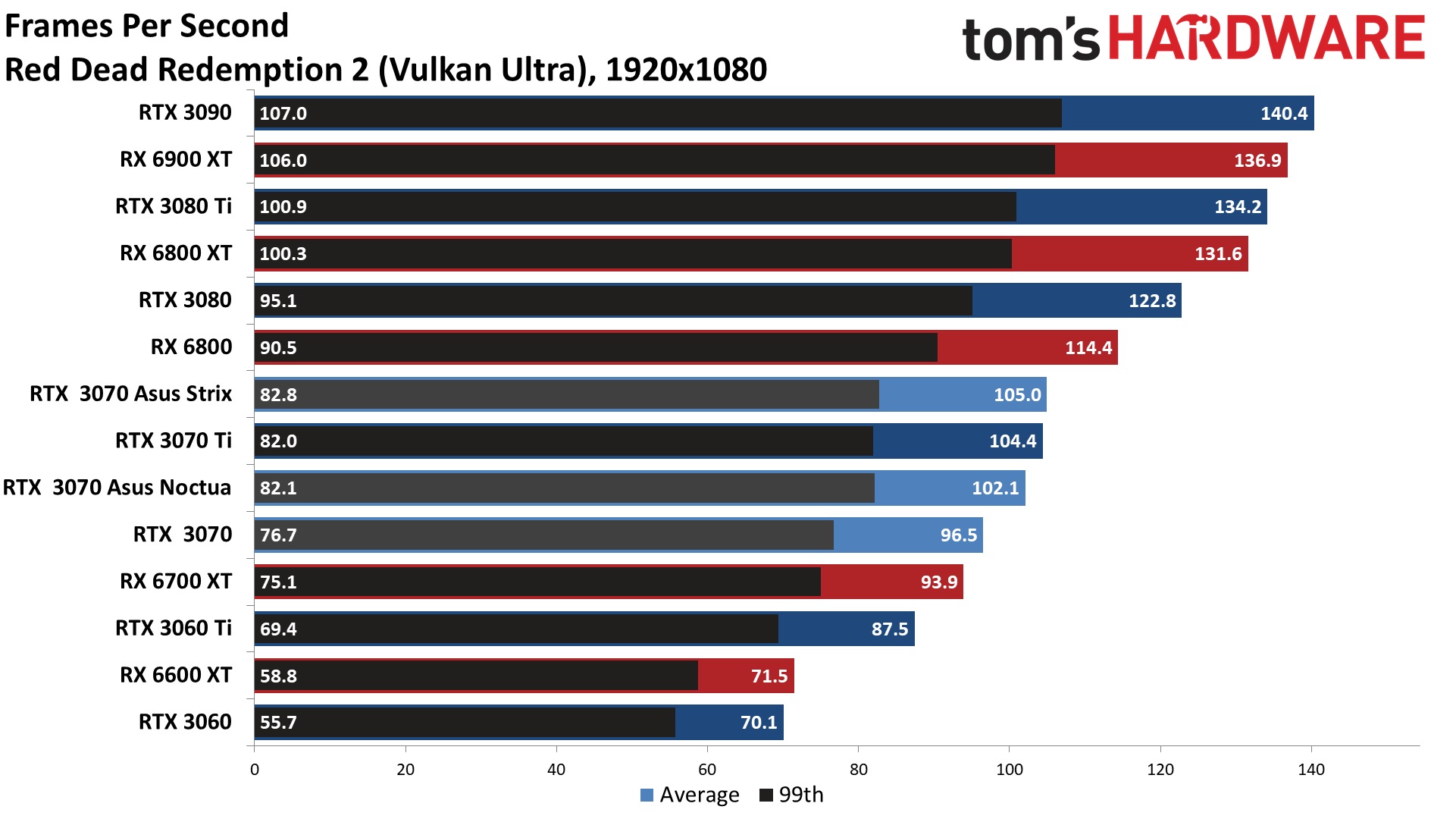
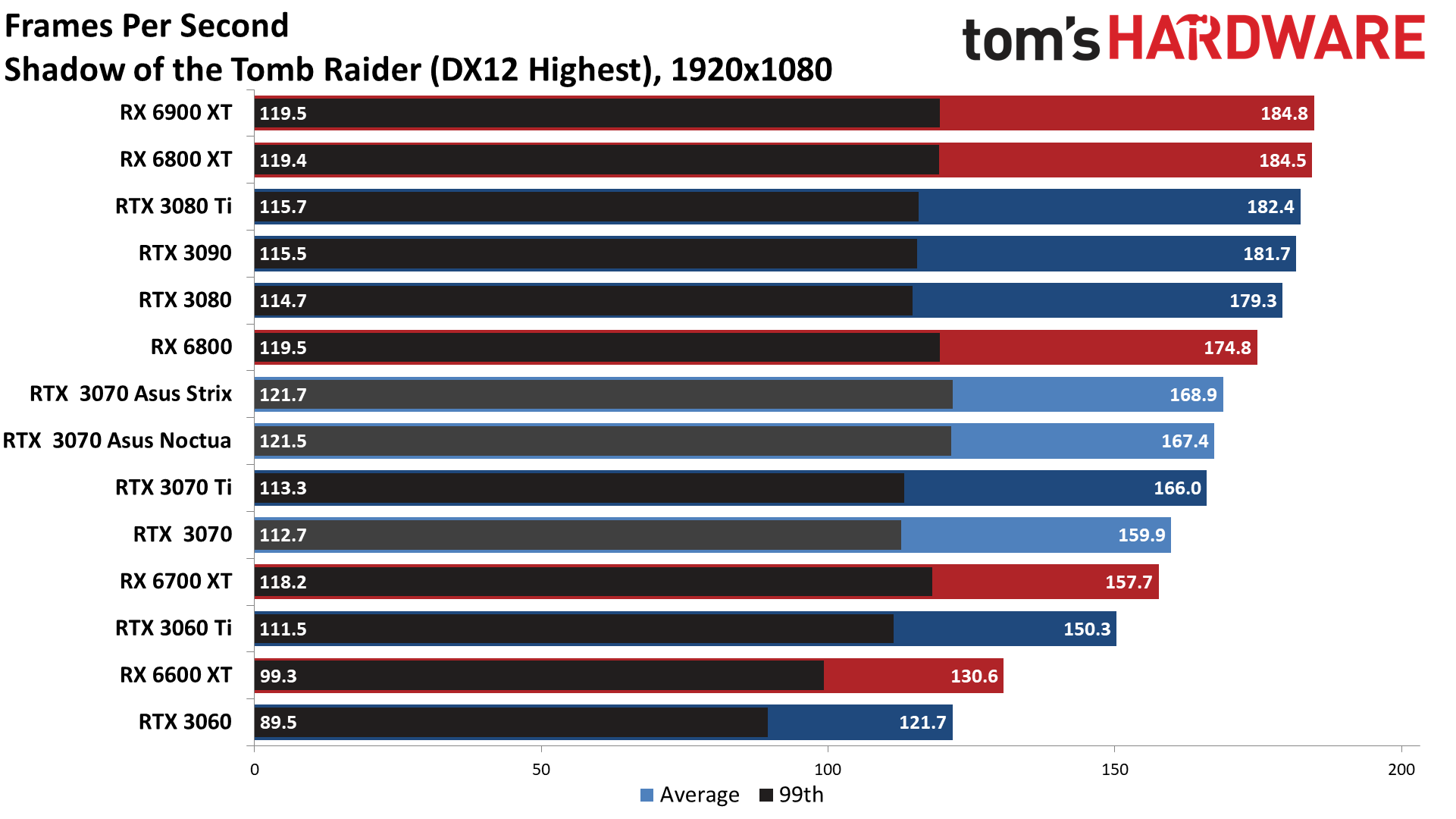
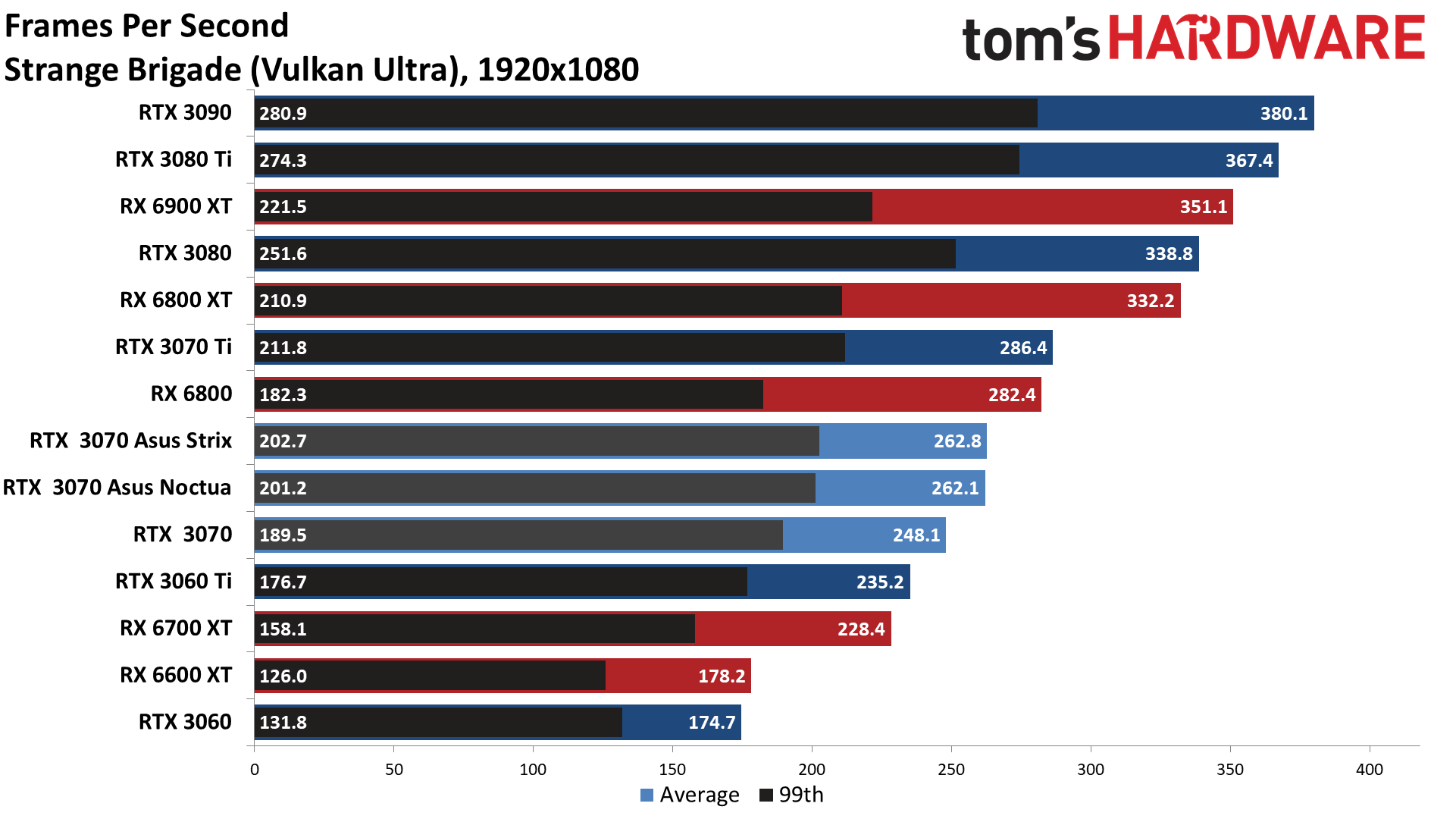
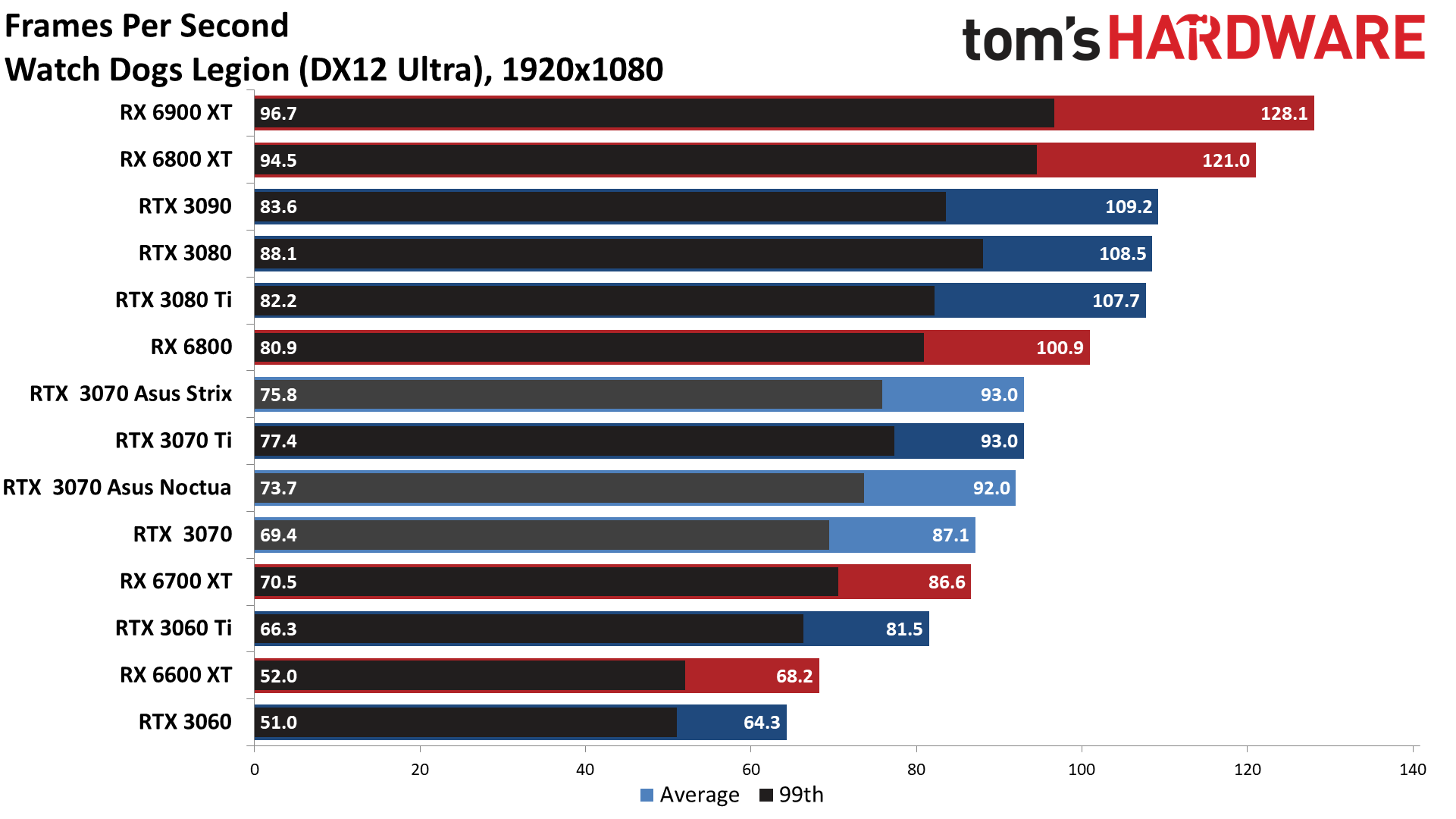
The combination of a huge cooler and large fans plus a decent factory overclock means the Asus RTX 3070 Noctua should easily eclipse the reference 3070 Founders Edition in our test suite. It does, with an overall advantage of 5.4% at 1080p ultra. The Strix RTX 3070 meanwhile comes in just a touch ahead of the Noctua model, leading by 1.8% overall — not something you'd notice in normal gaming, but the higher boost clocks do make a minor difference.
Looking at the full suite of individual results, the Noctua leads the reference card by anywhere from 1.4% (Far Cry 5) to 8.5% (The Division 2), which is basically expected behavior. A few of the games in our suite tend to hit CPU bottlenecks at 1080p, though even at higher resolutions we'll see fairly similar results.
One thing we don't really see is the impact of only having 8GB of memory. The Noctua card was still about 7% faster than AMD's RX 6700 XT, and the margins will grow at higher resolutions where AMD's Infinity Cache isn't able to help quite as much. However, there are also games that can start to exceed the 8GB VRAM and will actually favor AMD's card.
Get Tom's Hardware's best news and in-depth reviews, straight to your inbox.
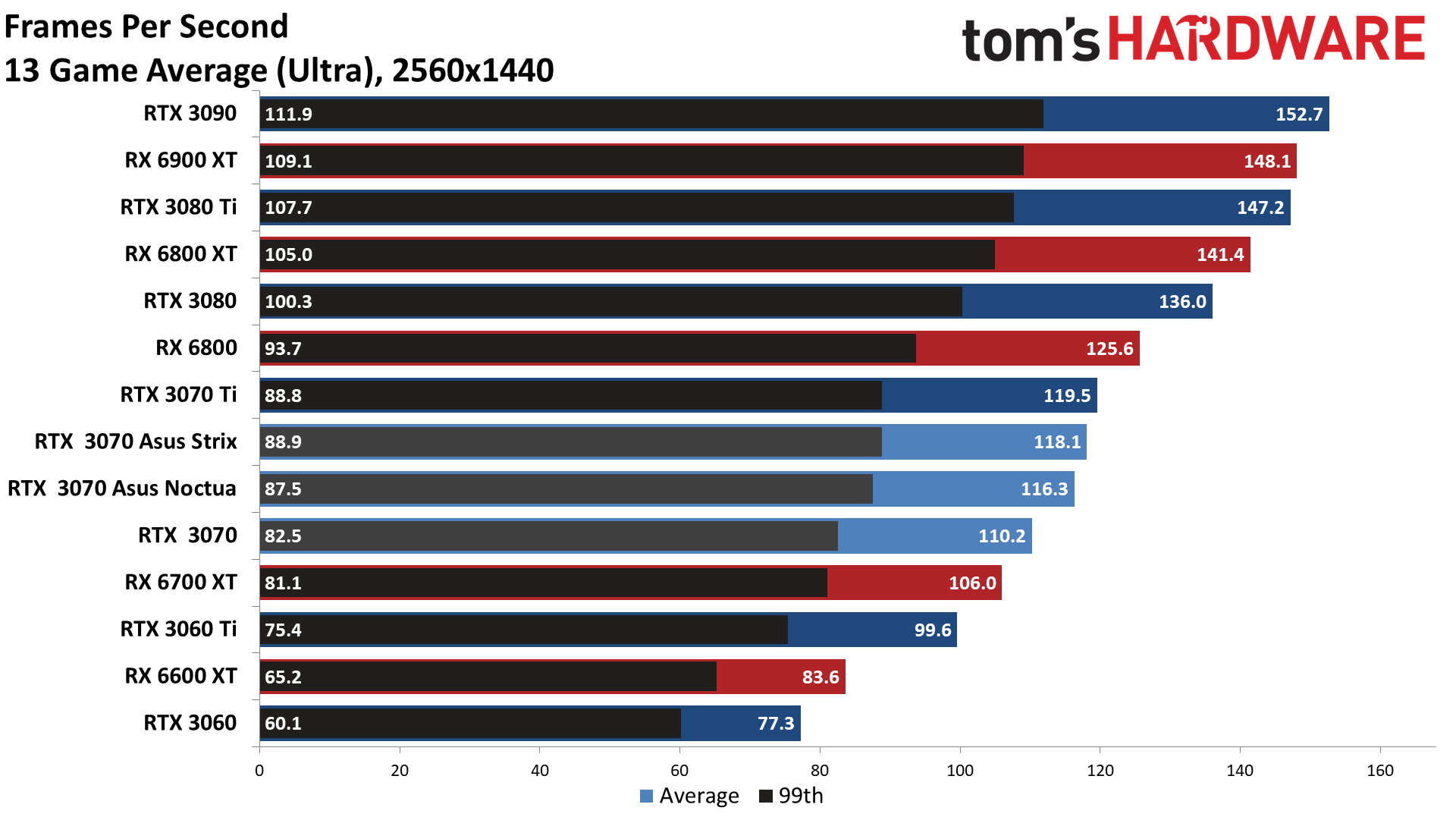
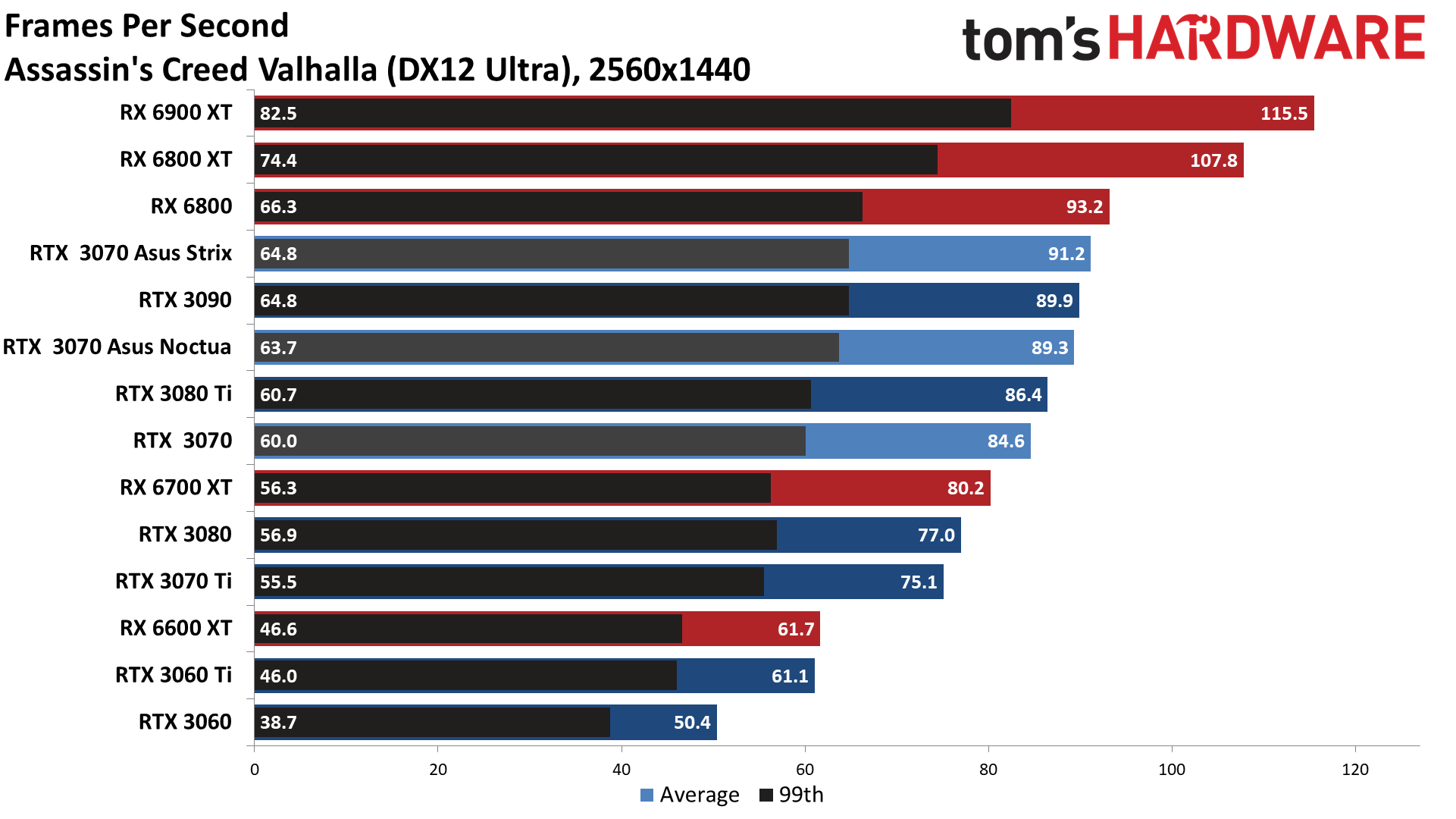
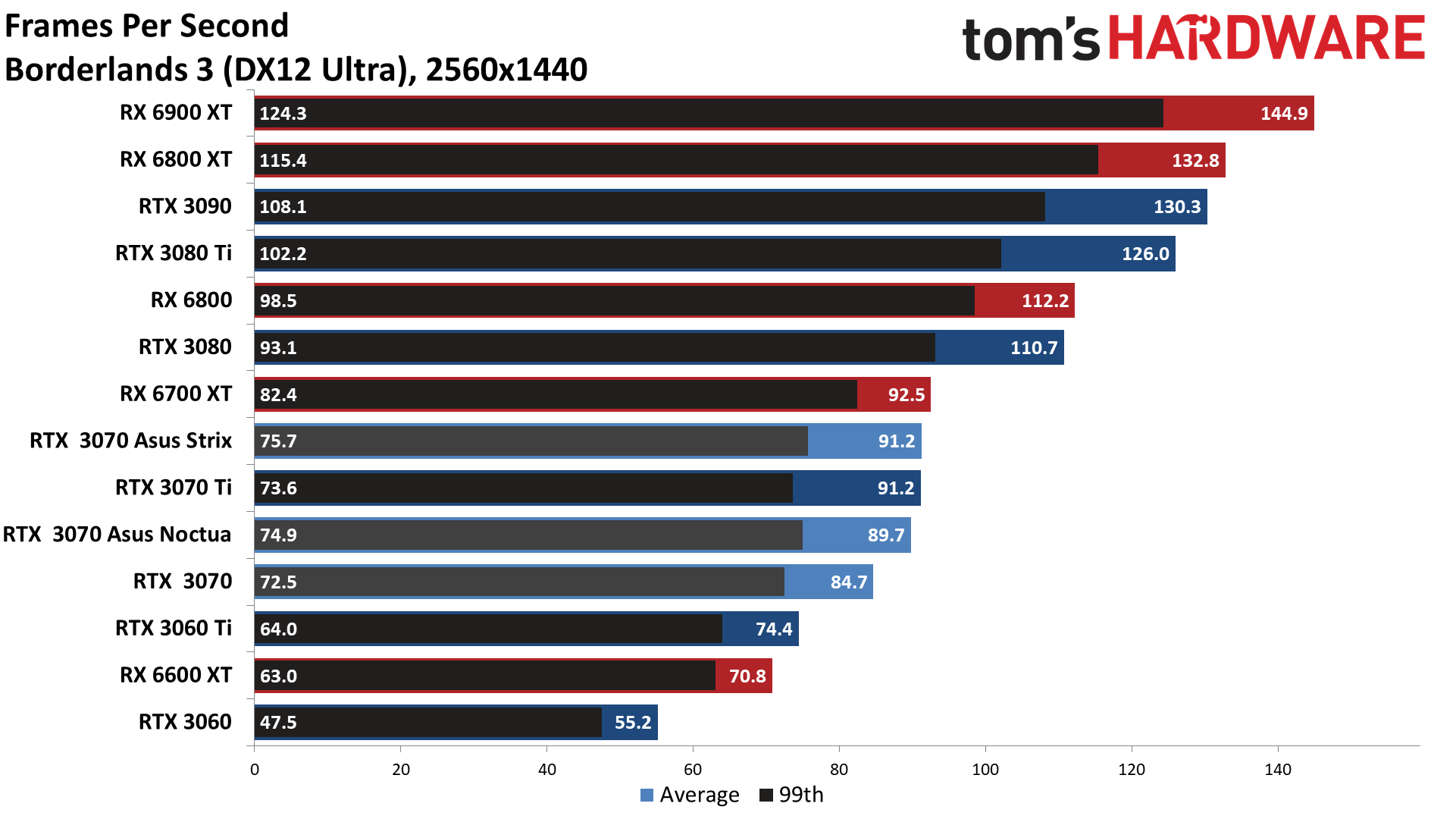
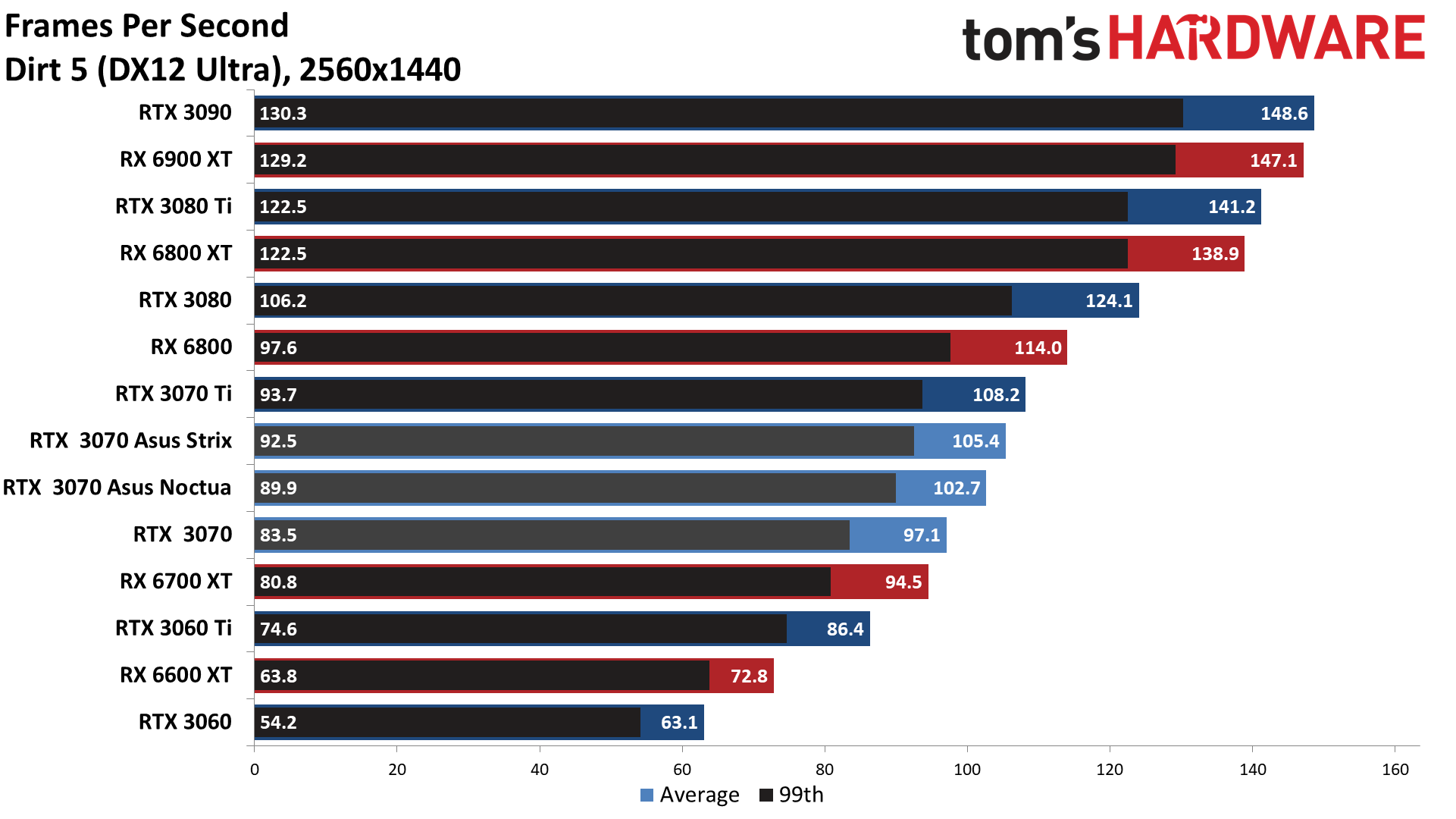
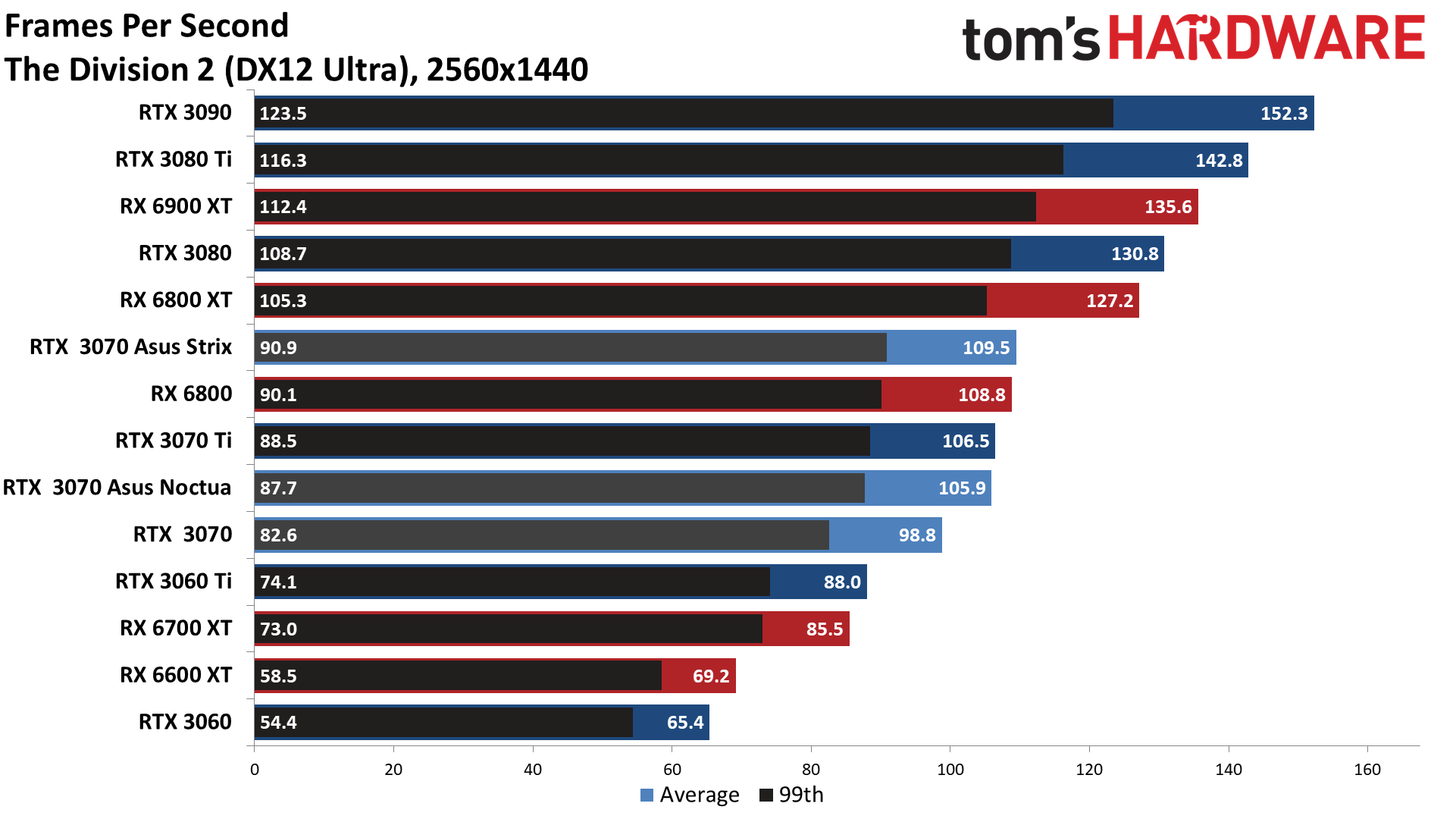
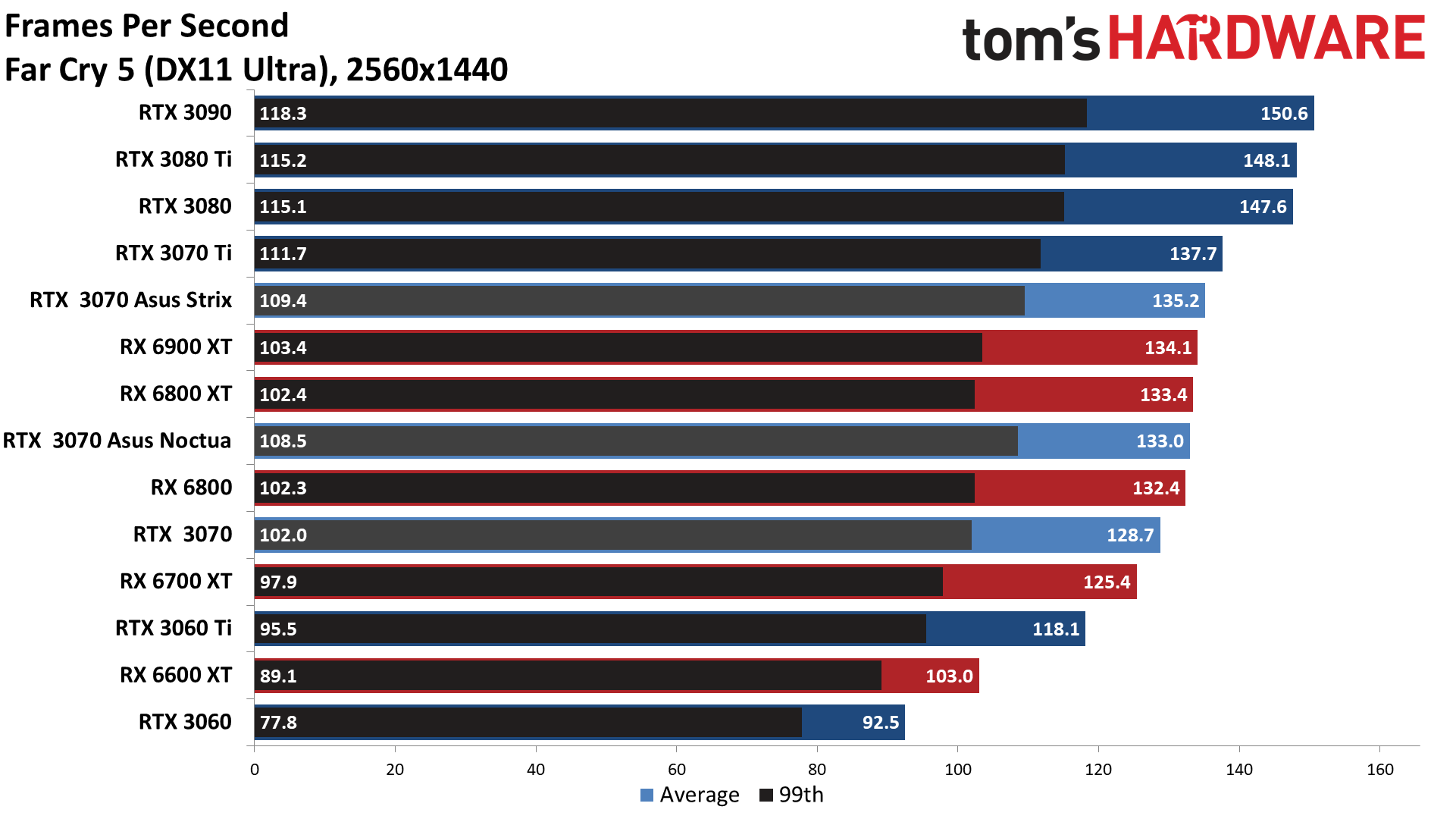
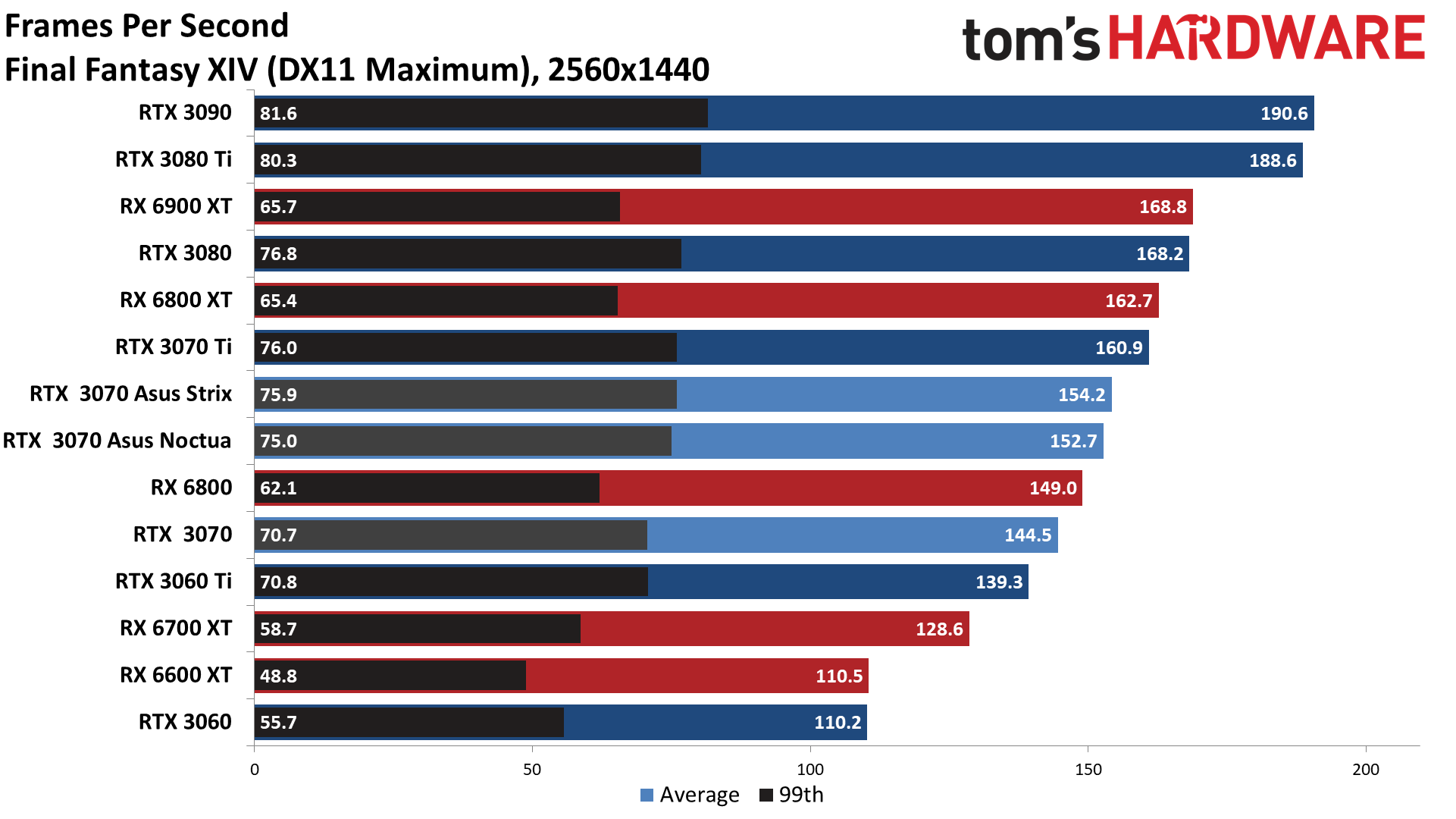

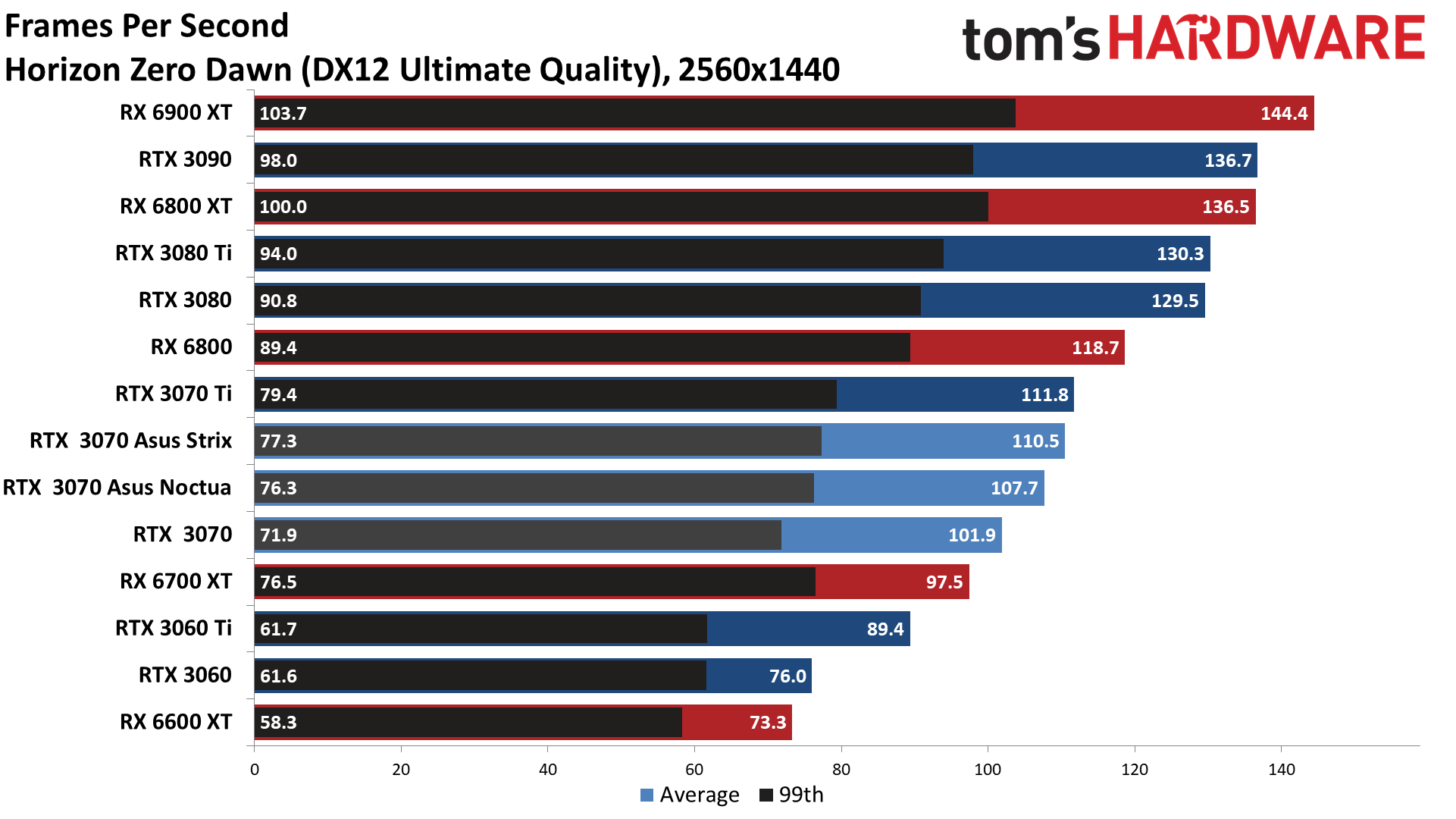
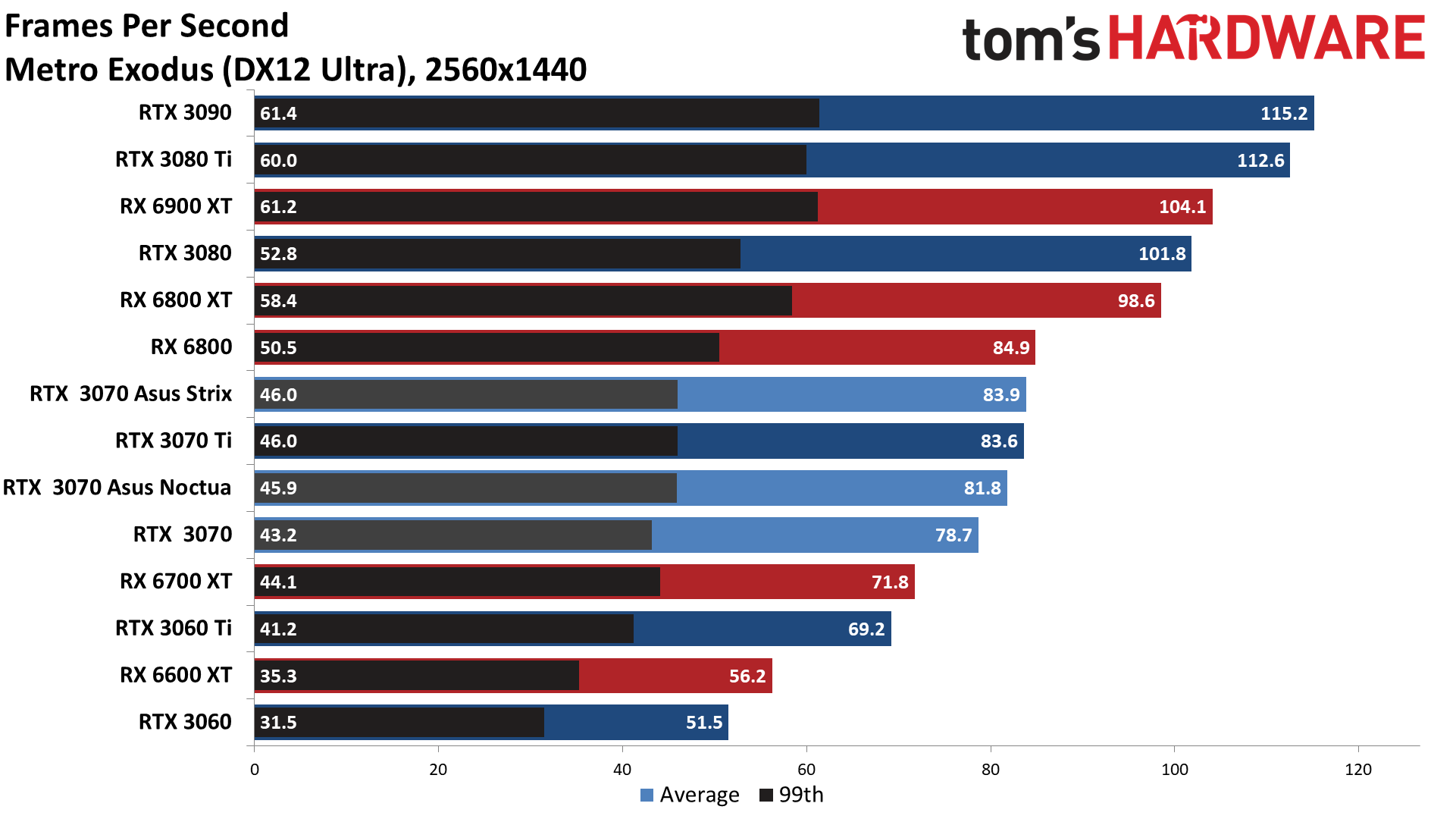
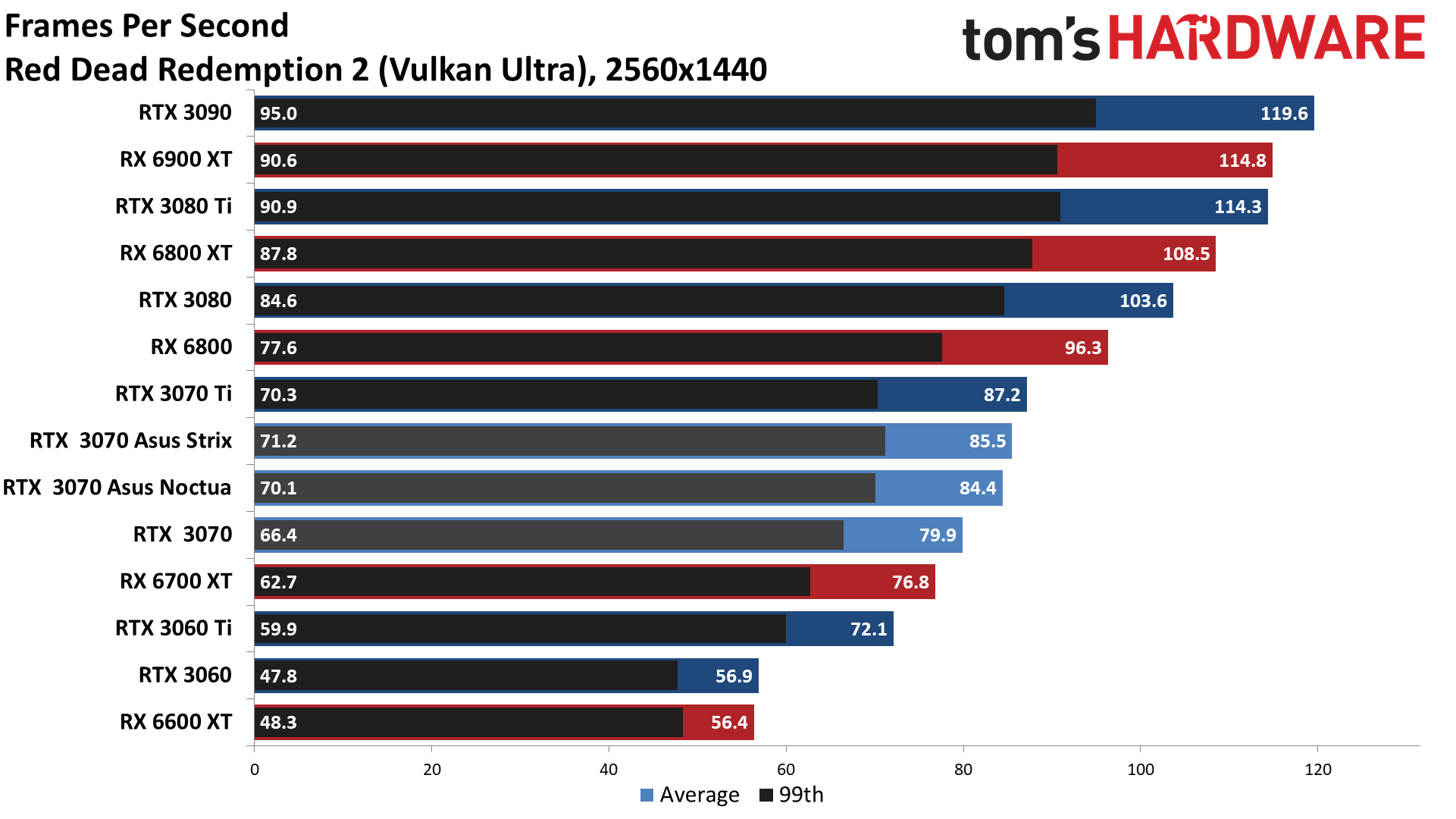
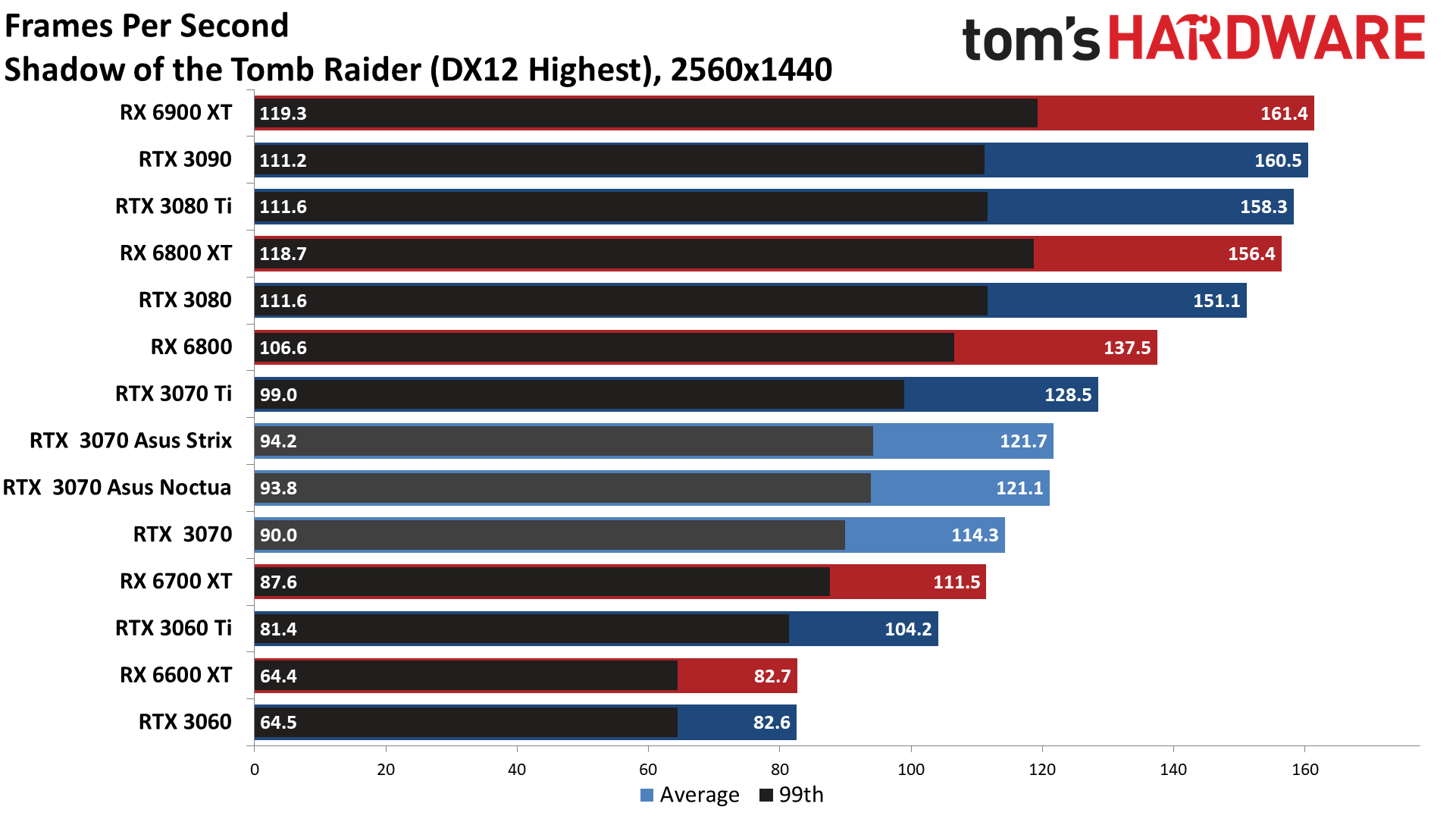
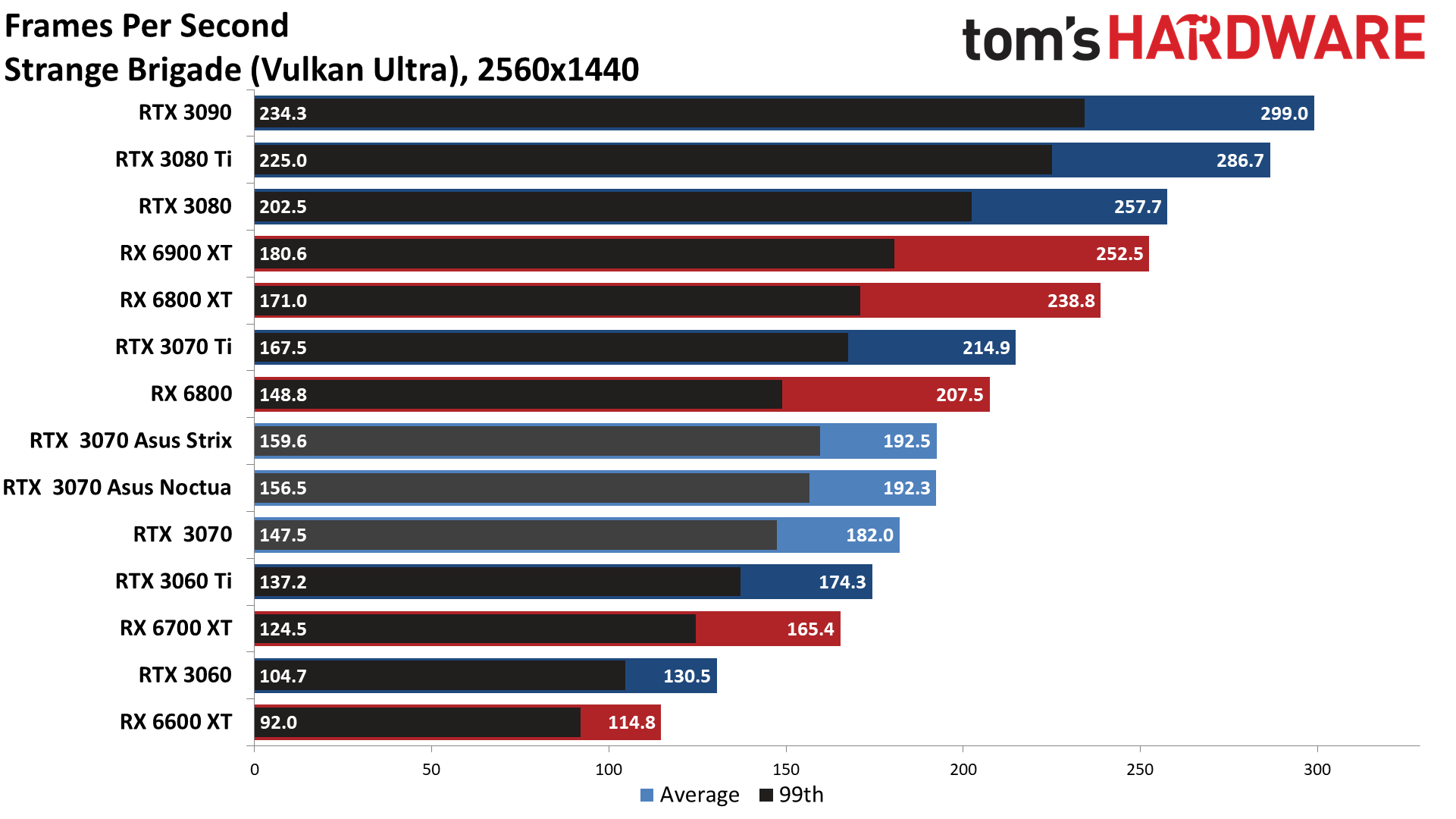
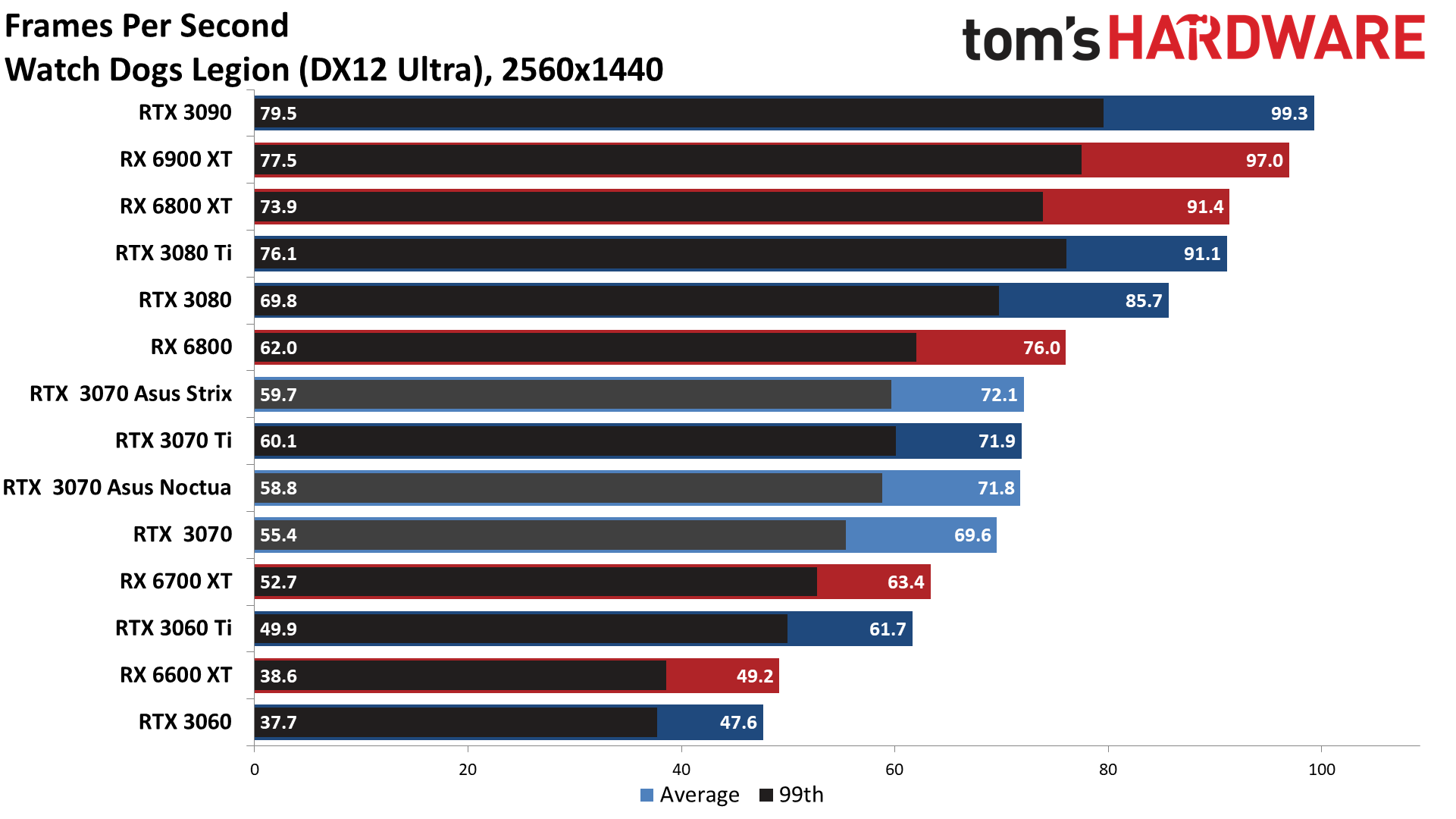
Moving up to 1440p ultra, the Noctua card again led the 3070 Founders Edition by an average of 5.4% across our test suite and trailed the Strix by 1.6%. The lead over the RX 6700 XT grew to 10% here, with Borderlands 3 and Forza Horizon 4 being the only two games that gave the 6700 XT a slight advantage.
1440p remains the sweet spot for most graphics cards, offering the potential of high framerates and reasonably priced monitors that can run at similarly high refresh rates. The 3070 Noctua averaged 111 fps across our test suite at that resolution, with a range of 72 fps (Watch Dogs Legion) to 192 fps (Strange Brigade). It should pair nicely with a variable refresh rate 1440p monitor.

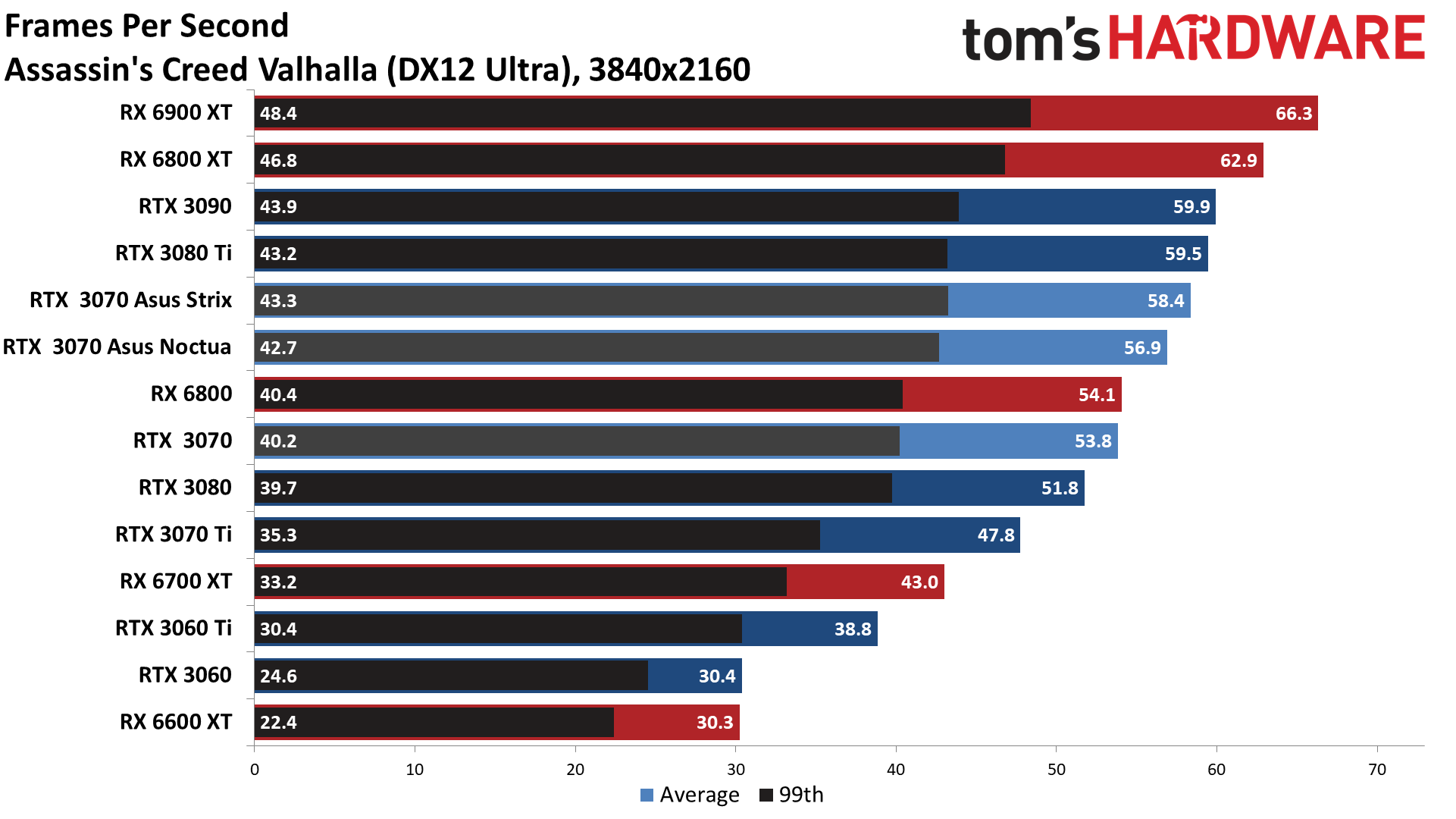
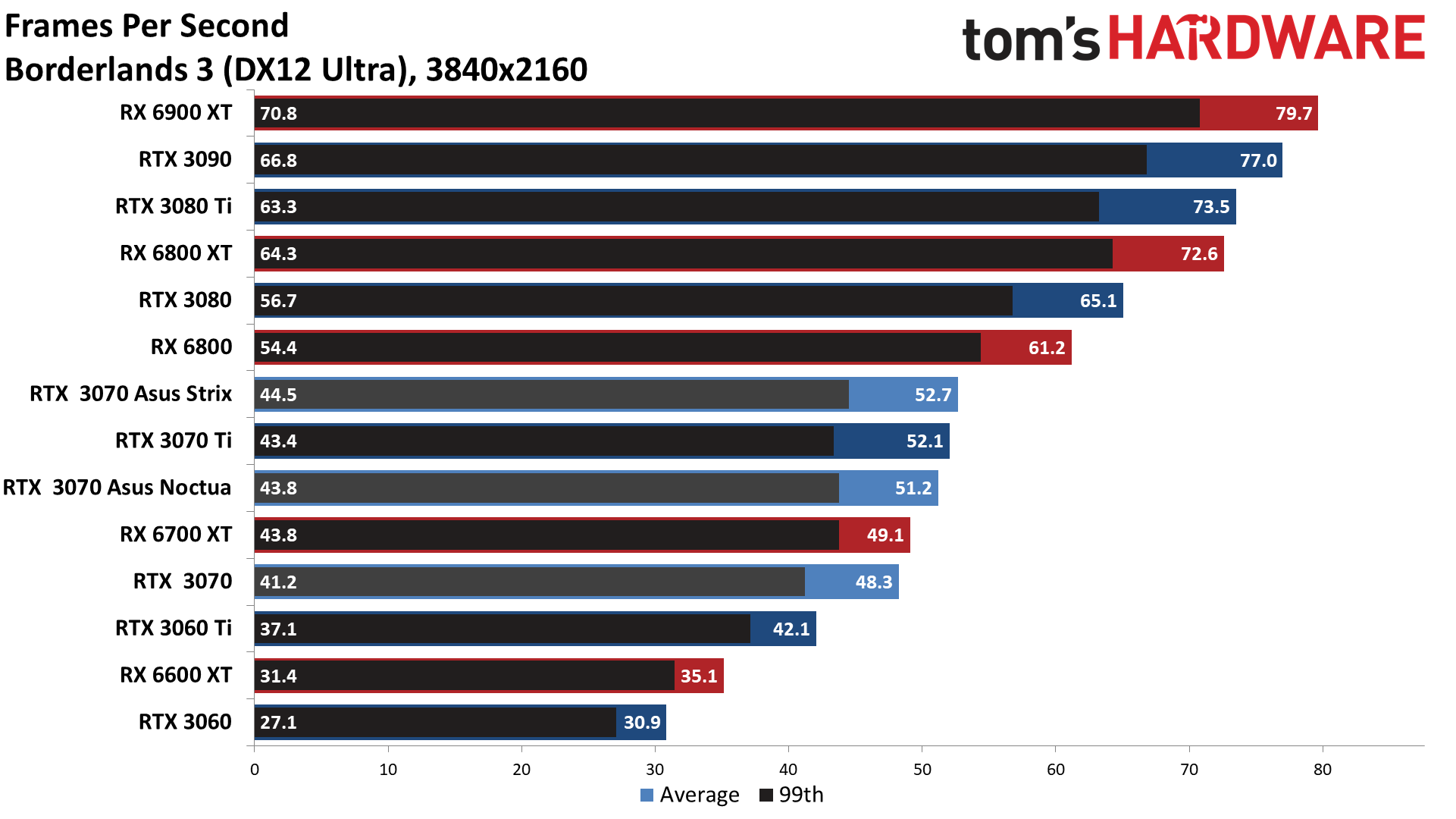
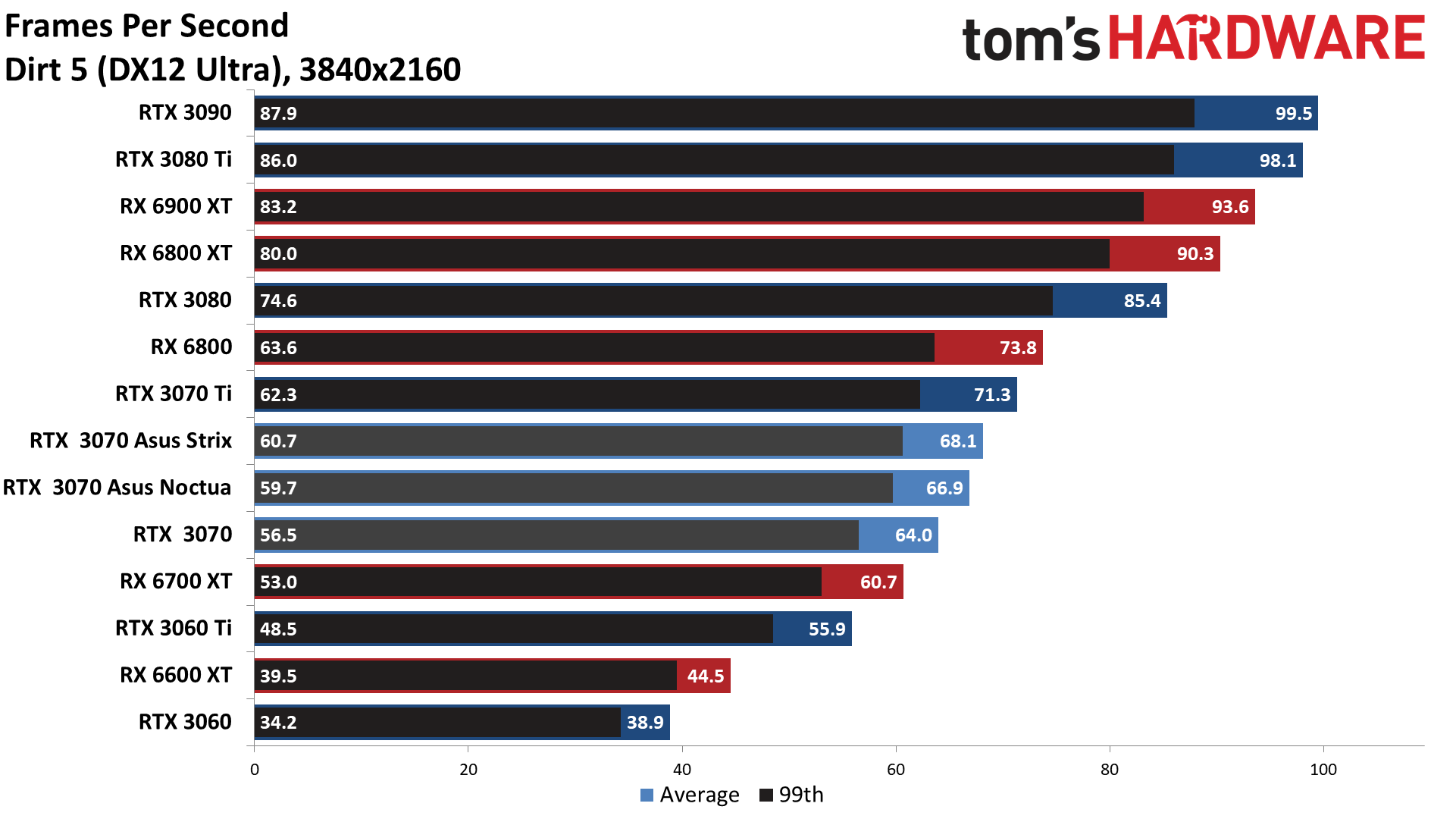
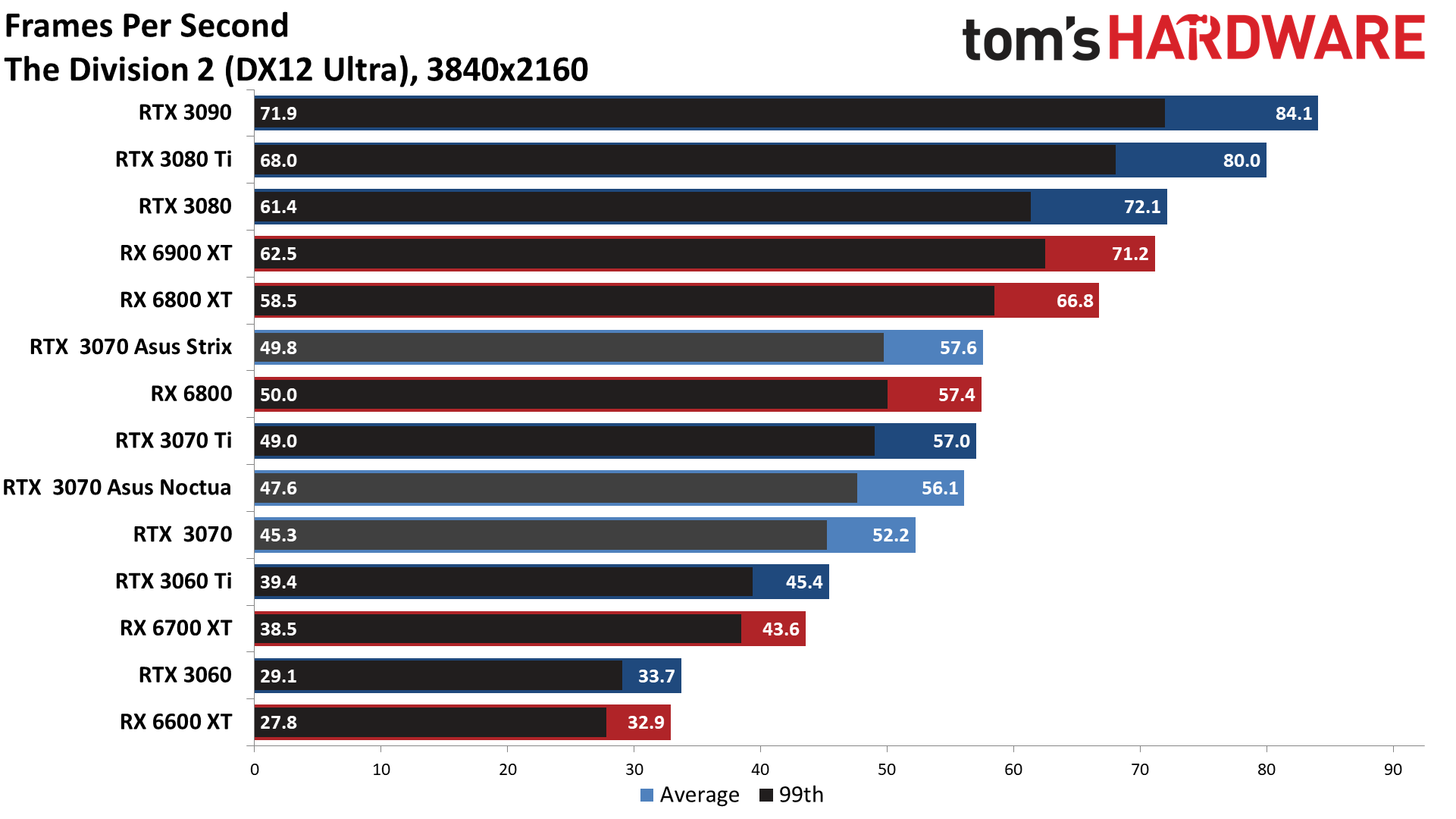
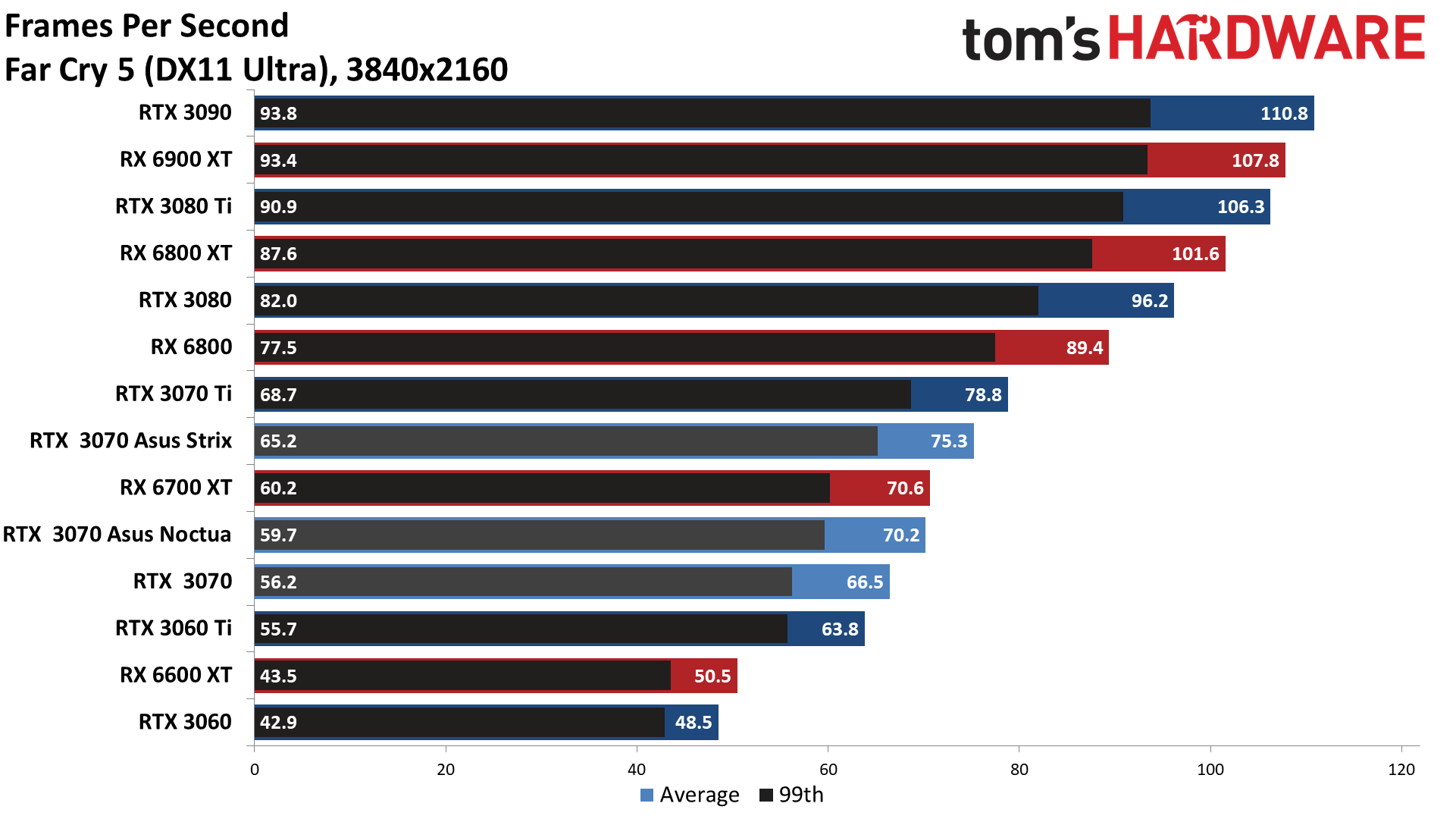
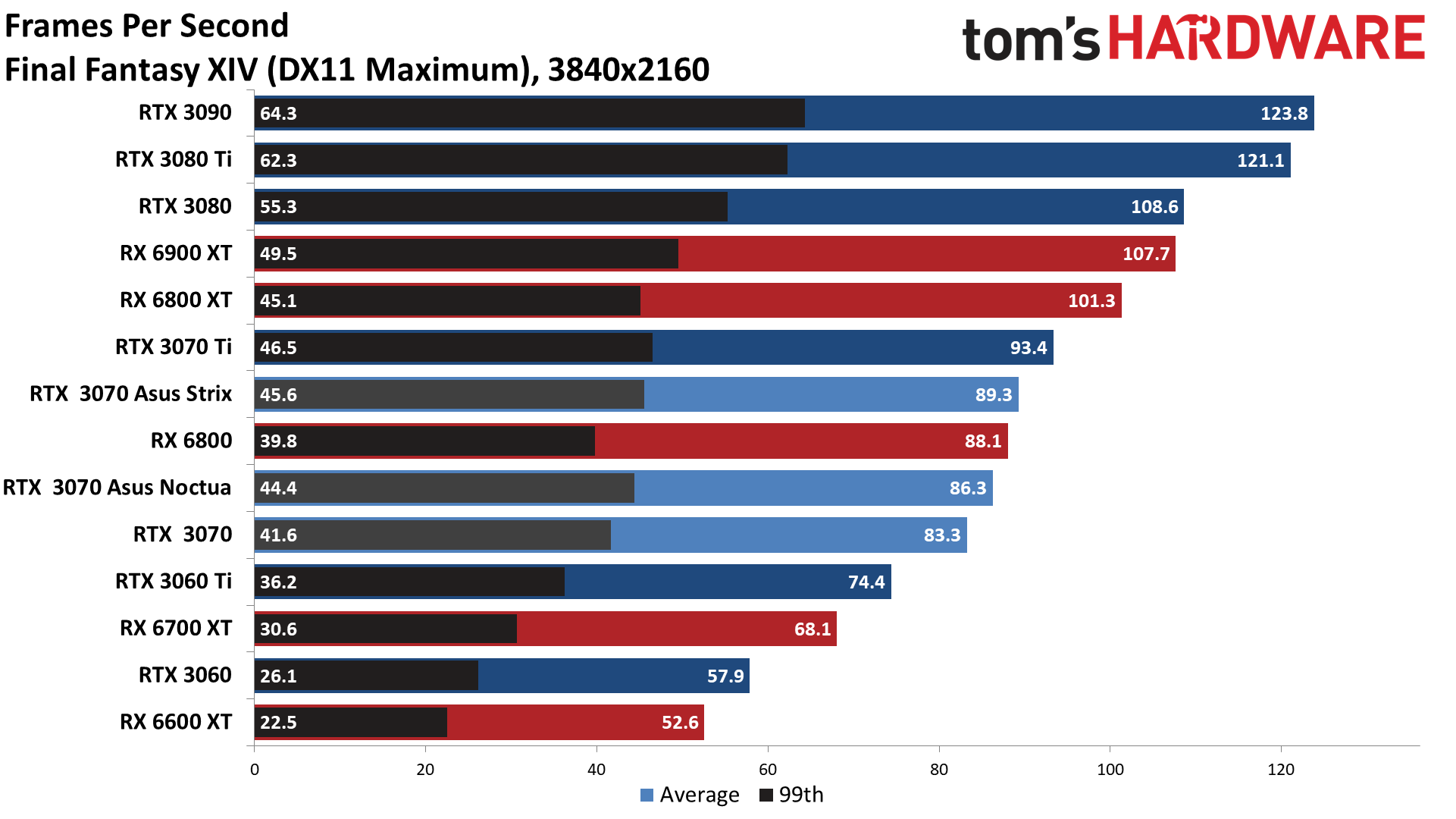
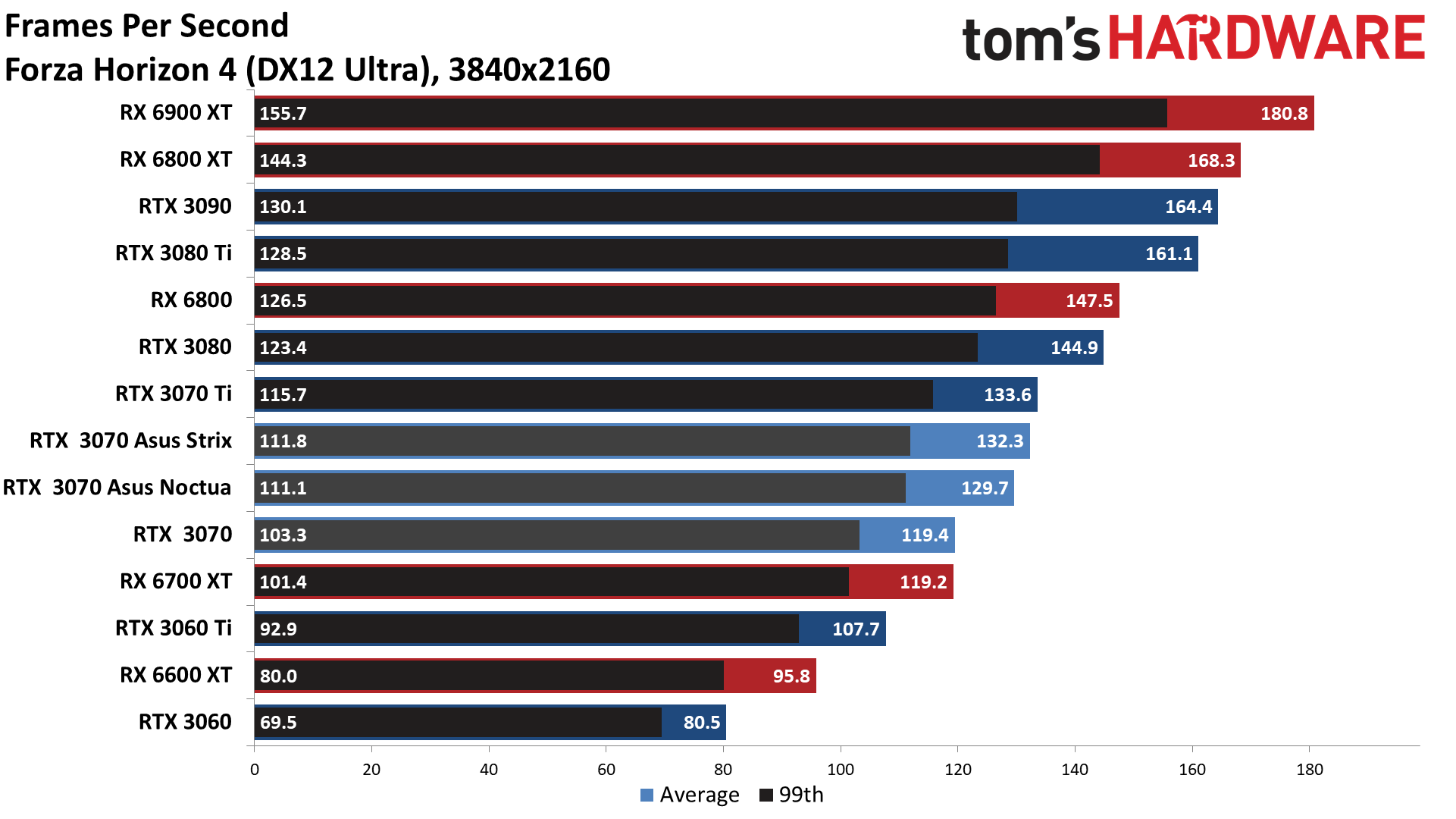
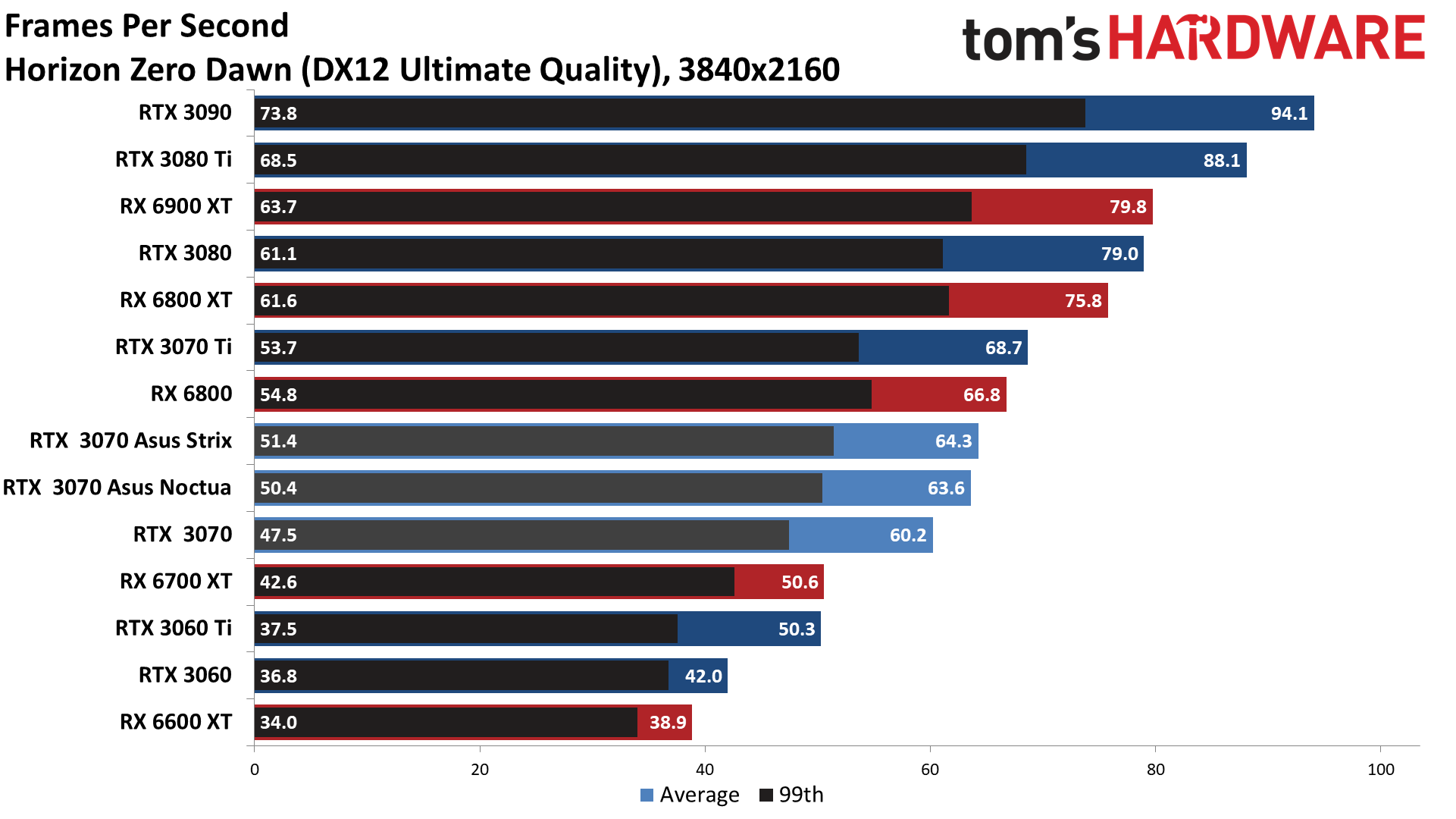
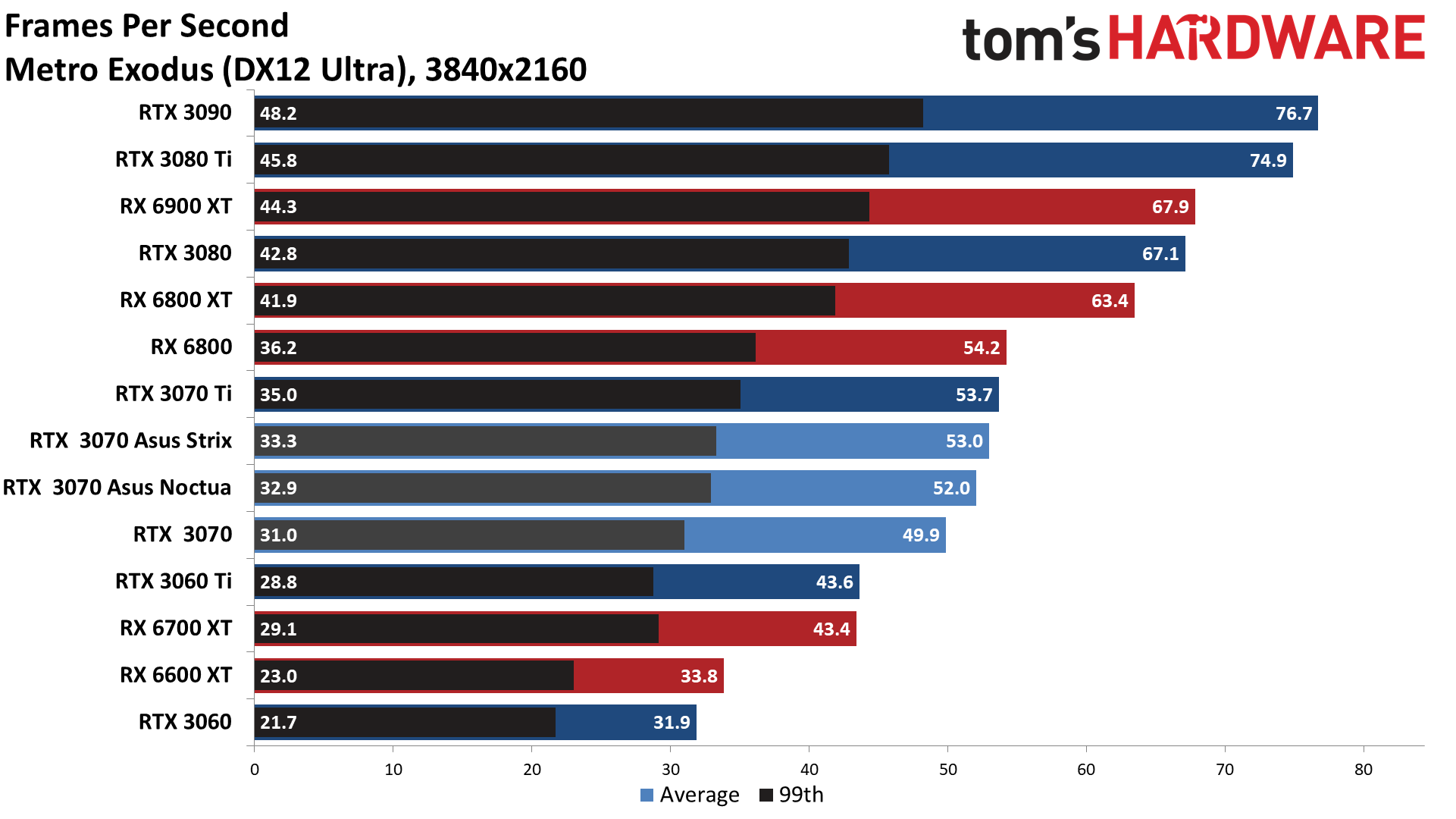
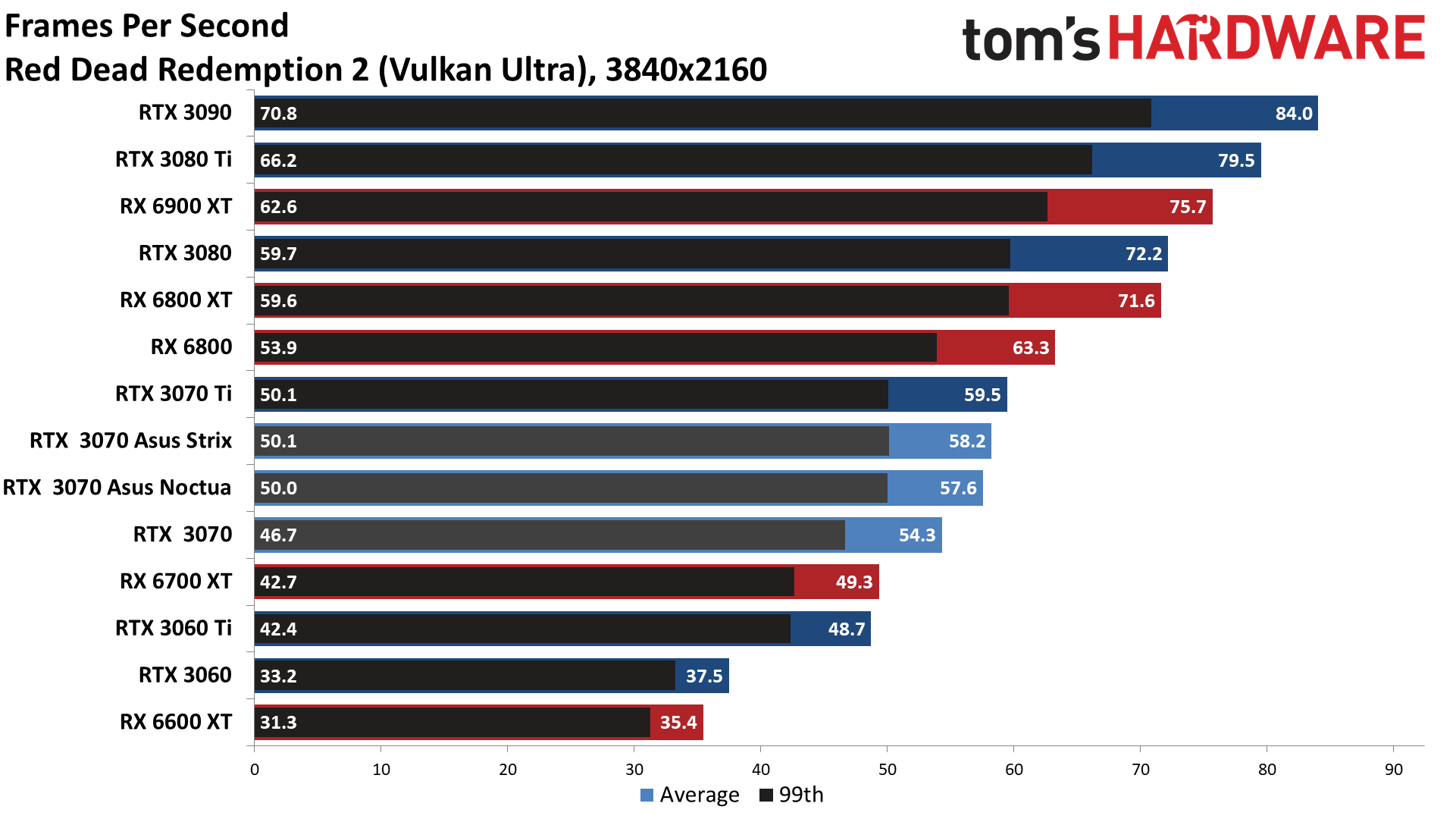
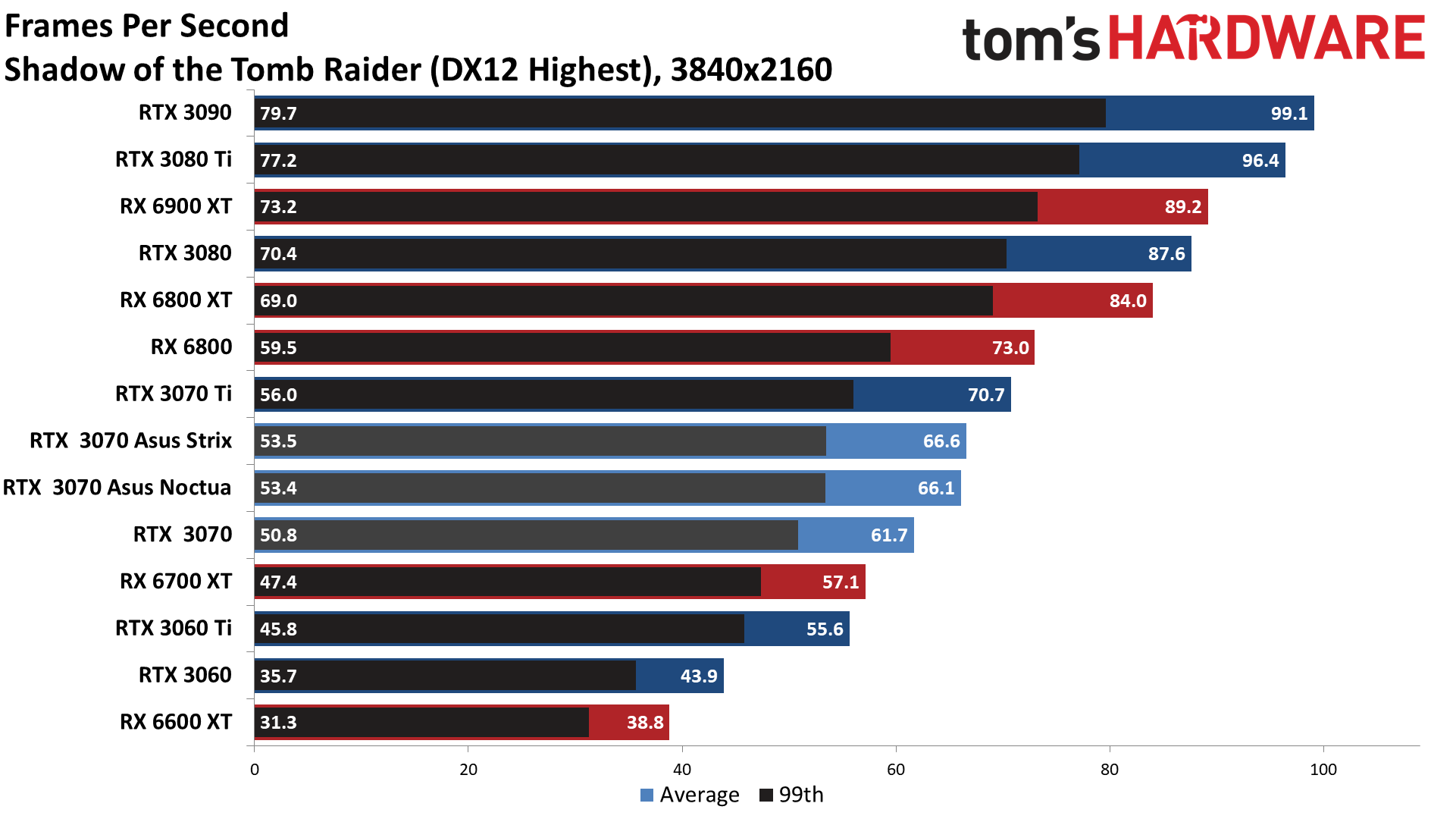
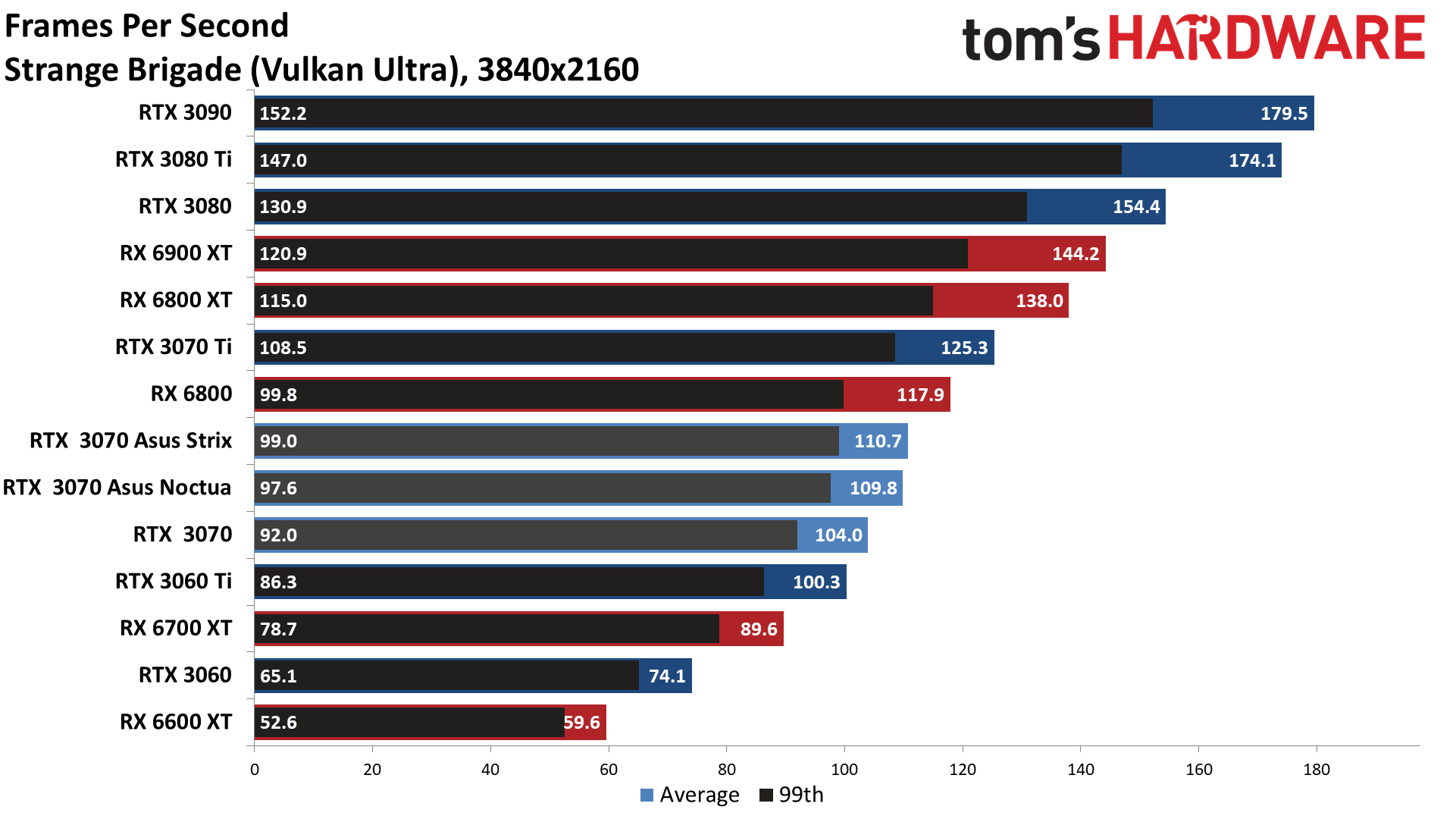
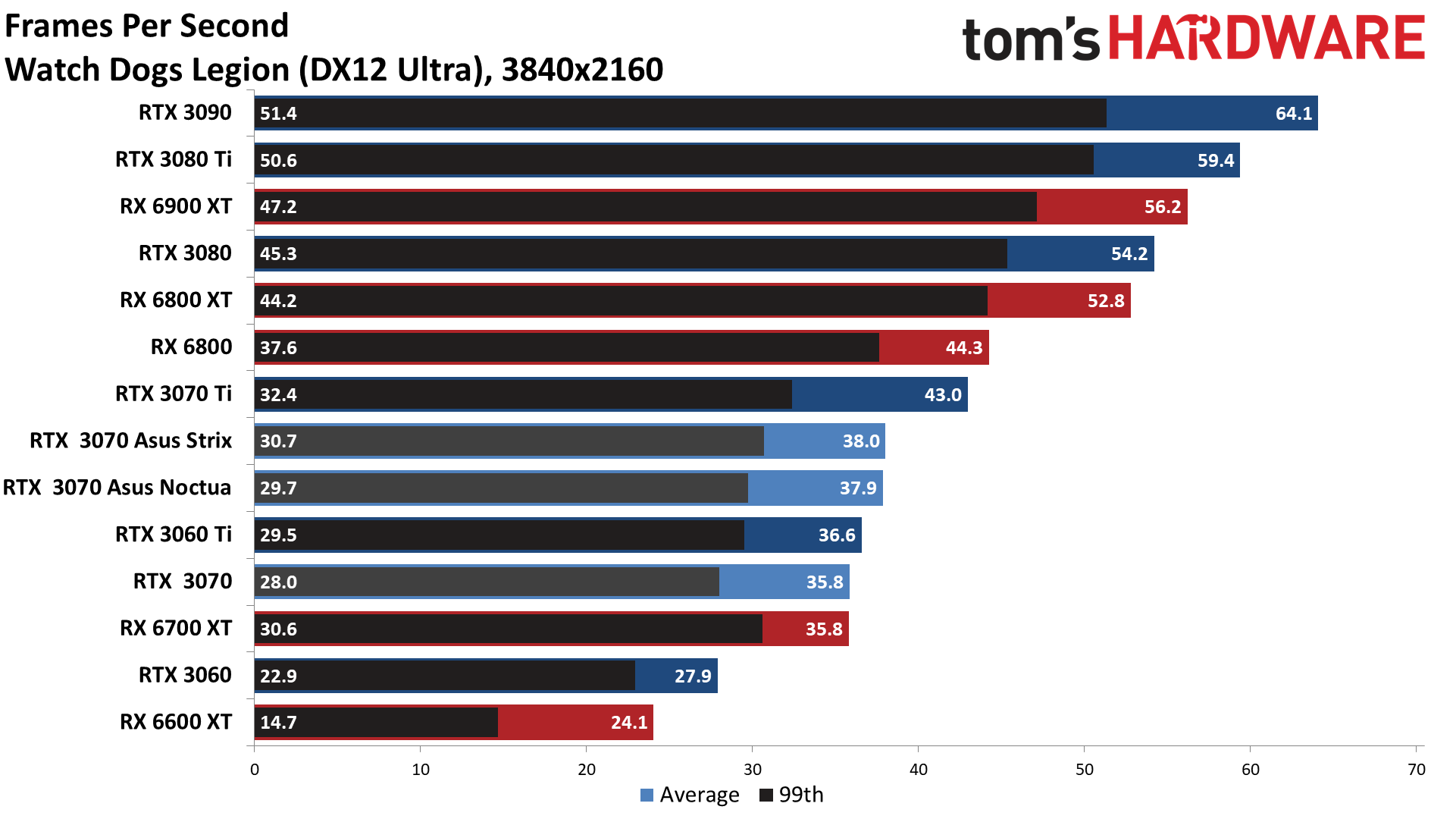
4K ultra remains playable in all of the games from our test suite, but there are a few newer releases — like Battlefield 2042 and Halo Infinite — where 8GB at max settings becomes a serious problem. Tweaking and tuning the settings will help quite a bit, but long-term we expect more games to start pushing beyond 8GB VRAM use in the coming years, thanks in part to the latest consoles also sporting more memory.
Watch Dogs Legion again comes in as the lowest-performing game in our suite, averaging just 38 fps at 4K ultra, and that's without turning on the DirectX Raytracing (DXR) reflections, which would drop performance well below 30 fps. But then, DLSS in Quality or even Performance modes could be used to more than make up that deficit.
Overall, though, the RTX 3070 continues to perform admirably, and the Asus 3070 Noctua improves on the baseline level of performance thanks to its relatively high factory overclocks. In fact, it's interesting that compared to the 3070 Ti Founders Edition, the factory overclock sometimes puts the 3070 Noctua slightly ahead of the normally higher-performing 3070 Ti. 4K likes the increased bandwidth that the GDDR6X memory of the 3070 Ti offers, but the 1080p and 1440p results are quite close. Naturally, a factory overclocked 3070 Ti would change the picture a bit.
Power, Clocks, Temperatures, Fan Speed, and Noise on the Asus RTX 3070 Noctua
Besides gaming performance, we also test power consumption using in-line monitoring tools and Powenetics software. We log power, clock speeds, temperatures, and fan speeds while looping the Metro Exodus benchmark five times at 1440p ultra settings, and we also run FurMark stress test at 1600x900 for over 10 minutes. We measure noise levels using an SPL meter placed about 10cm away from the card's fans as well, and we collect the data using the default Gaming profile as well as the OC mode enabled through Asus GPU Tweak III.
Let's start with noise levels, because that's probably one of the most important reasons to consider buying the Asus RTX 3070 Noctua card. At stock, the card shuts off the fans completely when the GPU temperature falls below 50C. It seems to immediately jump to around 60% fan speed above 50C, however, and only needs to go a bit faster in OC mode. The resulting noise levels were 36.7 dB(A) in default mode and 38.4 dB(A) in OC mode. The Strix card basically matched the Noctua in terms of noise levels (38.0 dB in default mode and 38.4 dB in OC mode), while both came in quite a bit below the 3070 Founders Edition's 43 dB peak noise levels.
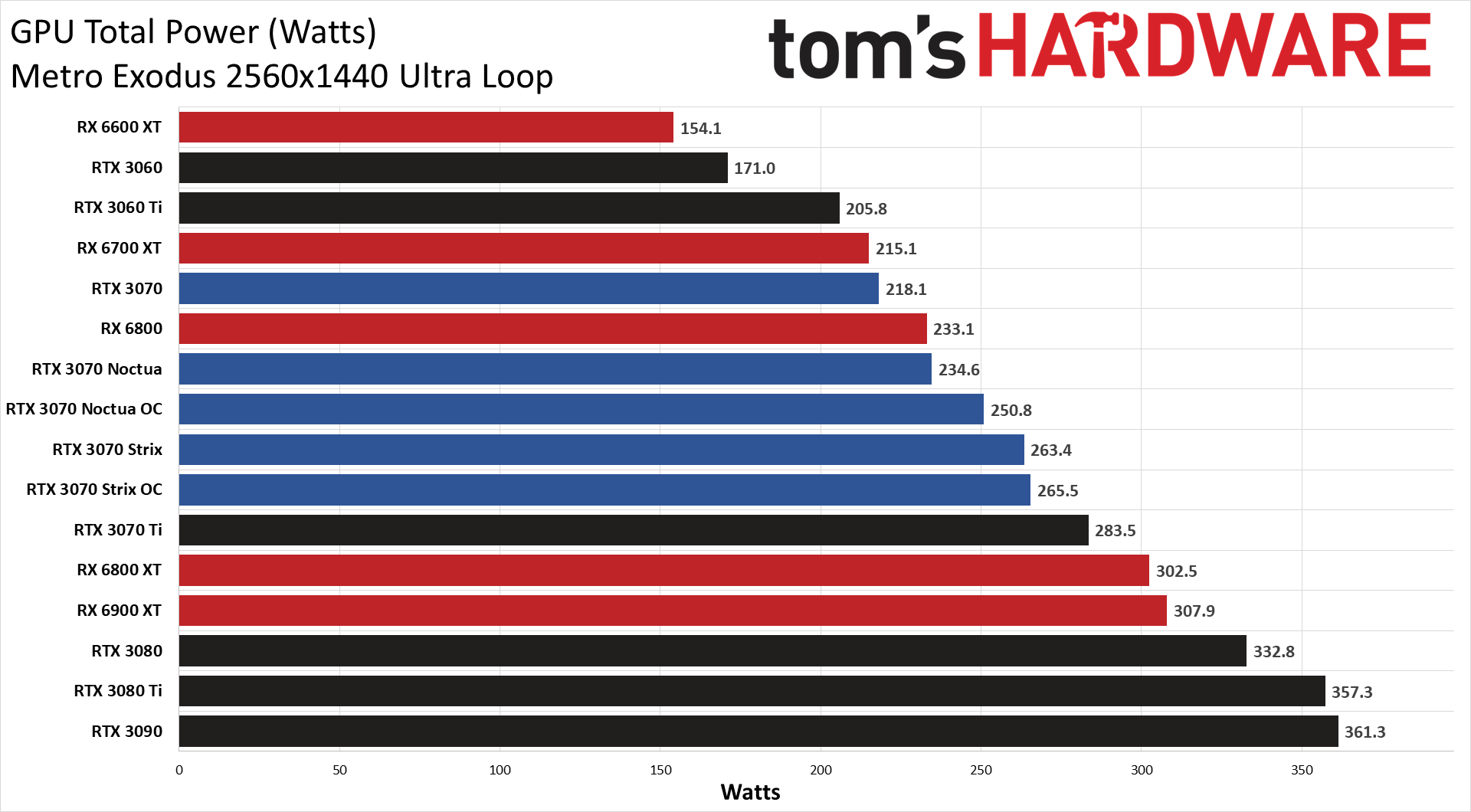
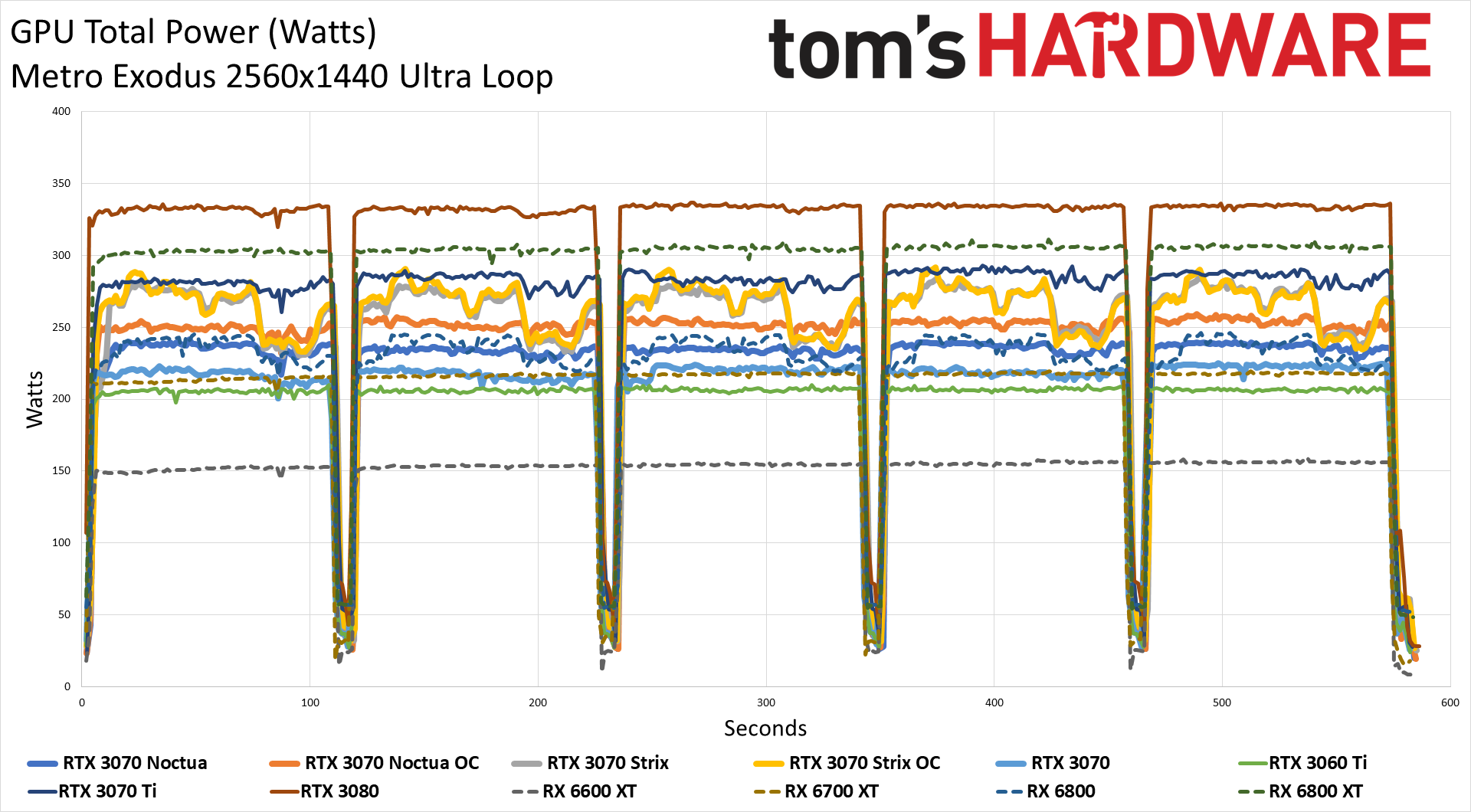
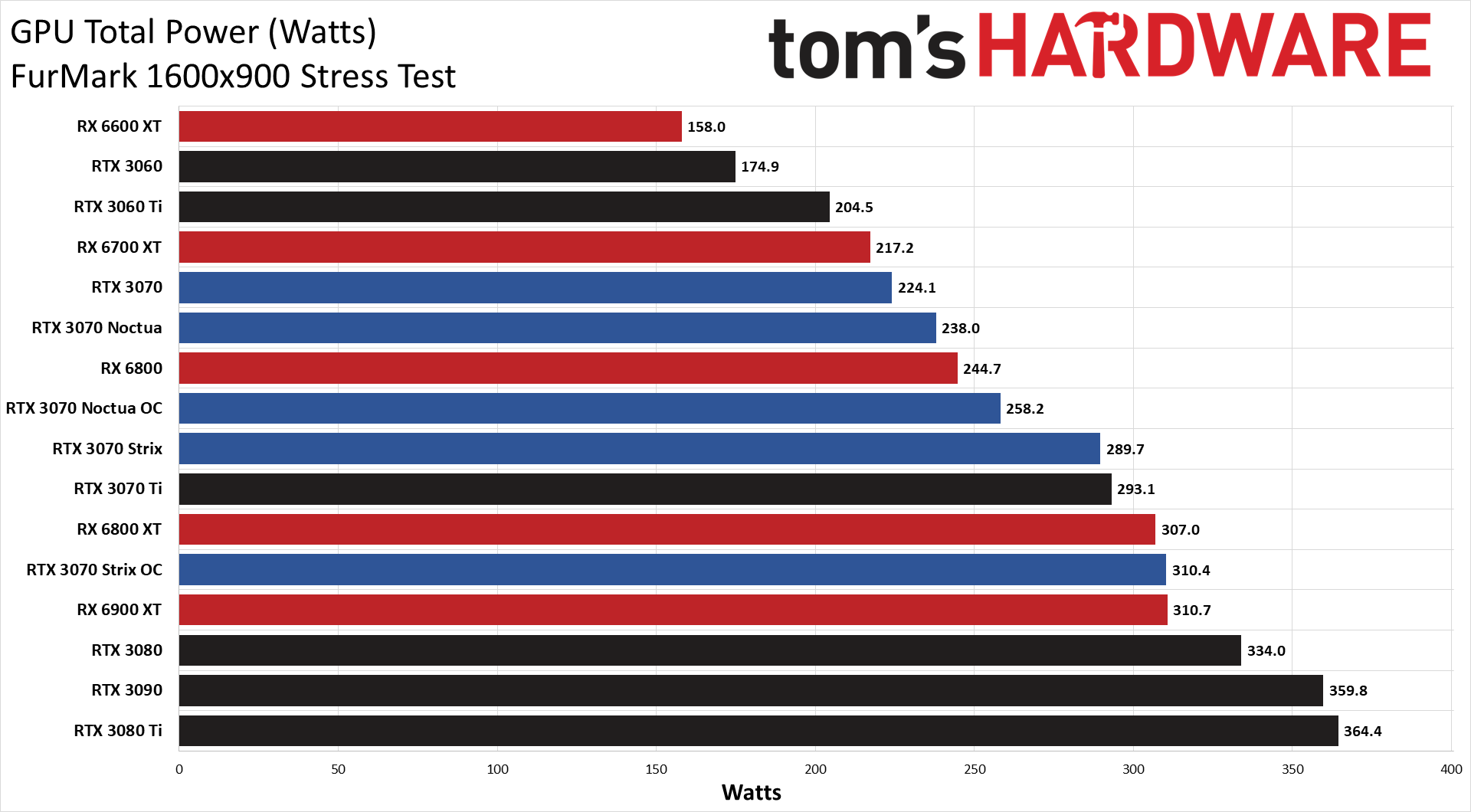

The power charts are interesting, particularly when looking at the Noctua and Strix 3070 cards compared to the 3070 Founders Edition. The Noctua only uses about 15W more power using the default profile, in both Metro and FurMark, while the OC mode bumps that up to 250W in Metro and nearly 260W in FurMark — about 30W higher than the reference design. The Strix meanwhile uses roughly the same amount of power in both the Gaming and OC modes with Metro, but uses 20W more power than the Noctua in OC mode when running FurMark.
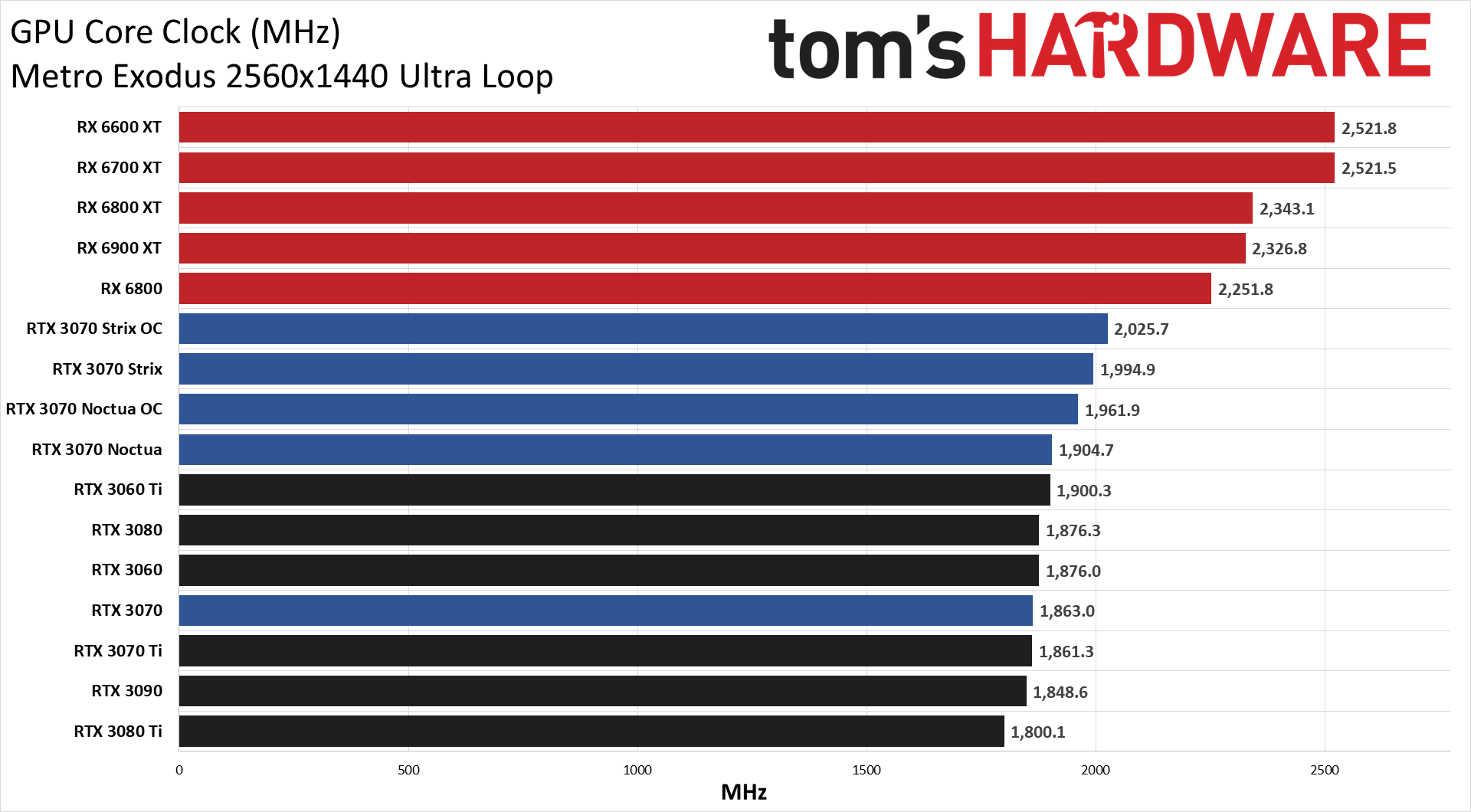
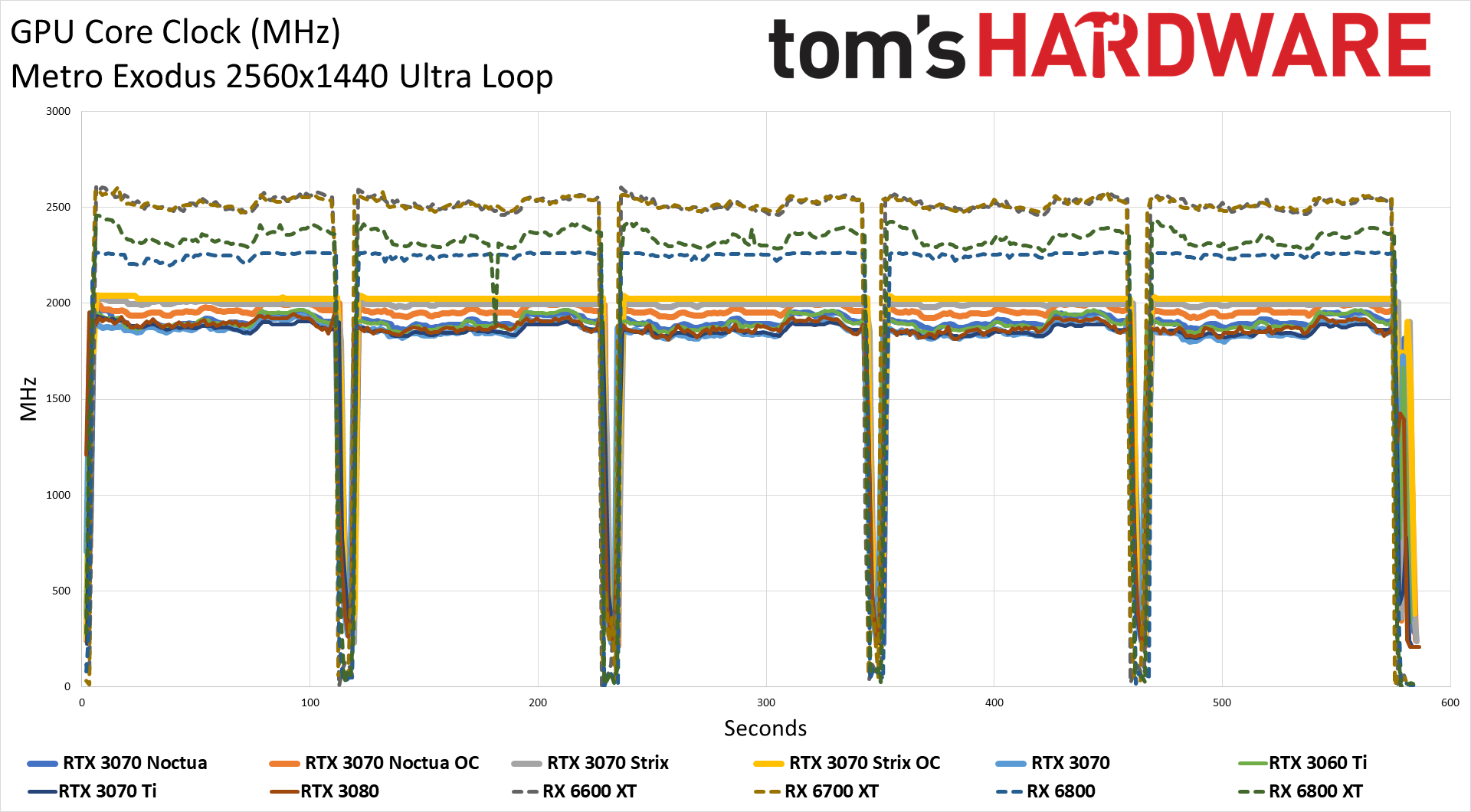
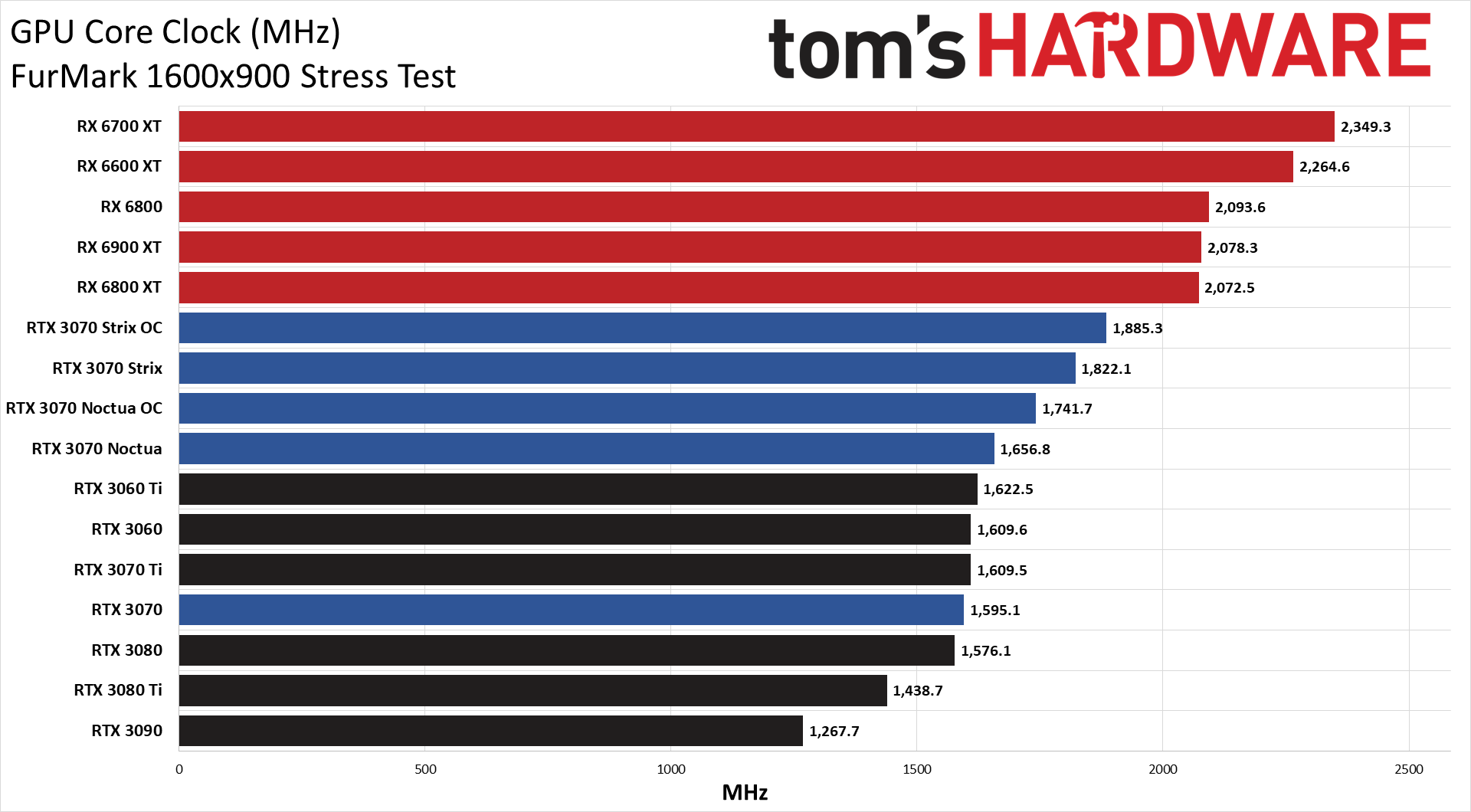
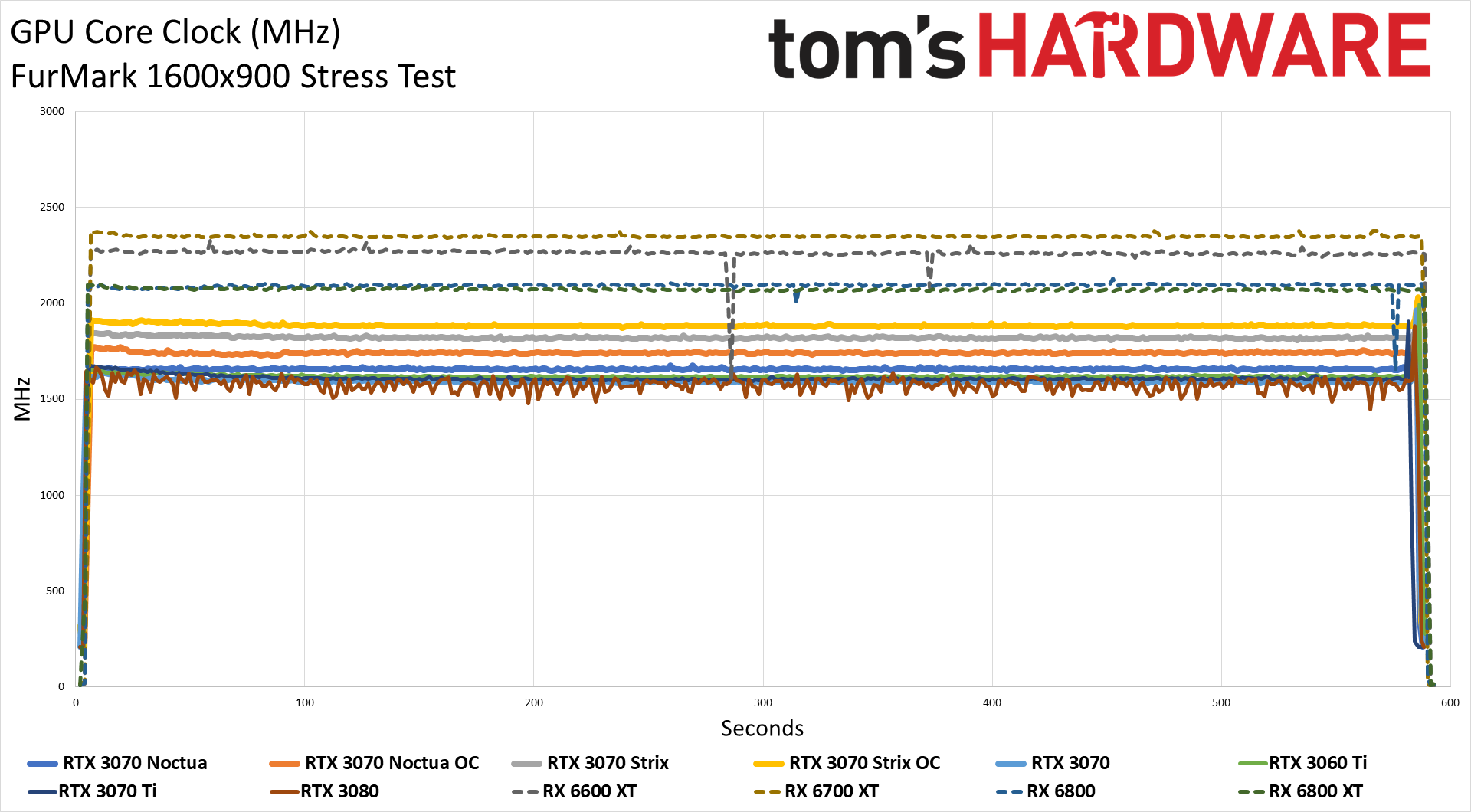
Going along with the power charts, the clock speed charts follow a similar pattern. OC mode on the Noctua card improved average clocks by nearly 60MHz, but the Strix card was already getting close to some other limit, so it only improved by 30MHz. Even the Founders Edition 3070 clocks well above the official 1725MHz boost clock, though, meaning you're getting better performance than the guaranteed minimum pretty much regardless of which graphics card model you buy. That doesn't necessarily apply to FurMark or other similar workloads, of course, where the 3070 reference card came in just a bit below 1.6GHz while the Noctua OC mode still hits 1742MHz, and the Strix OC mode chugs along at 1885MHz.
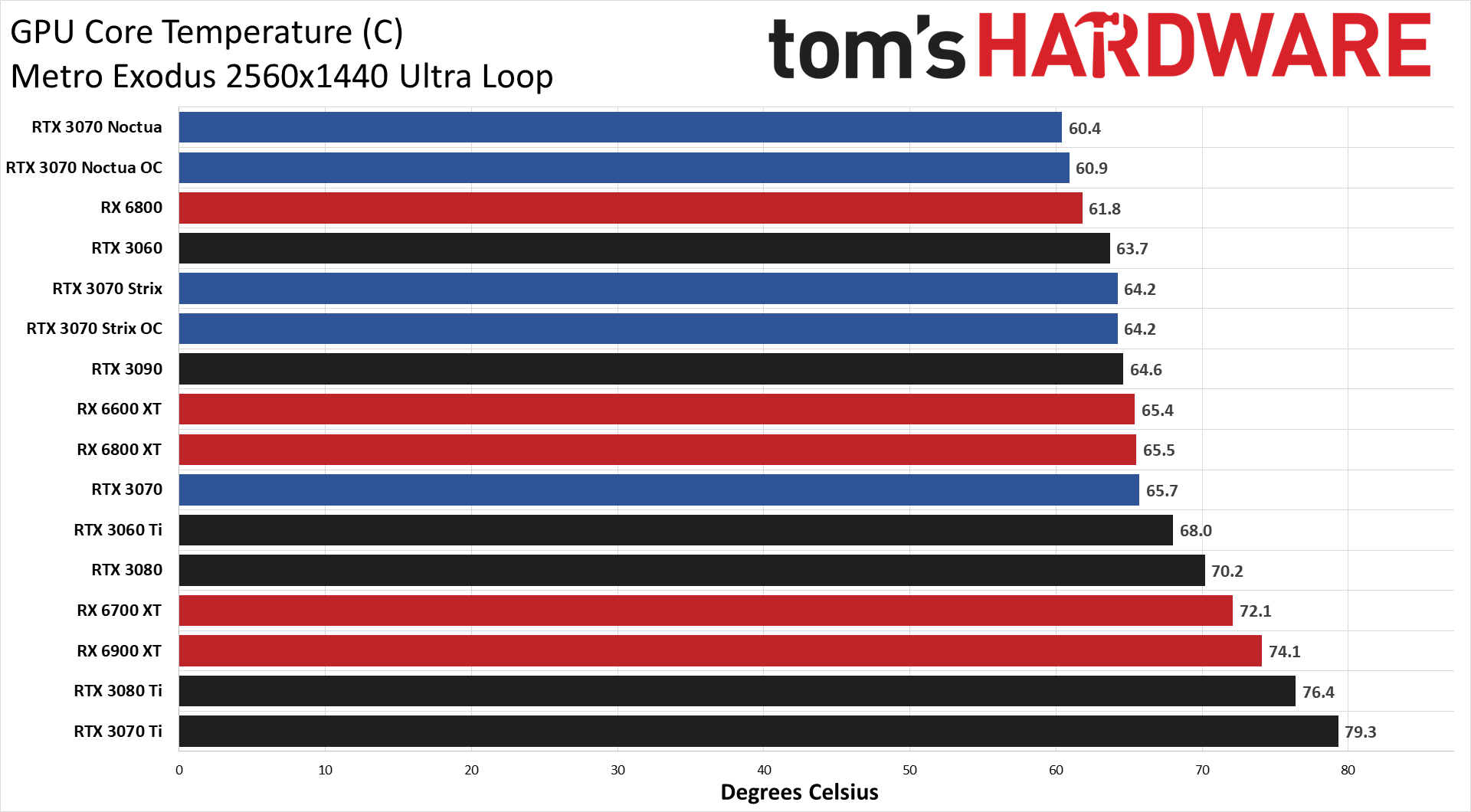
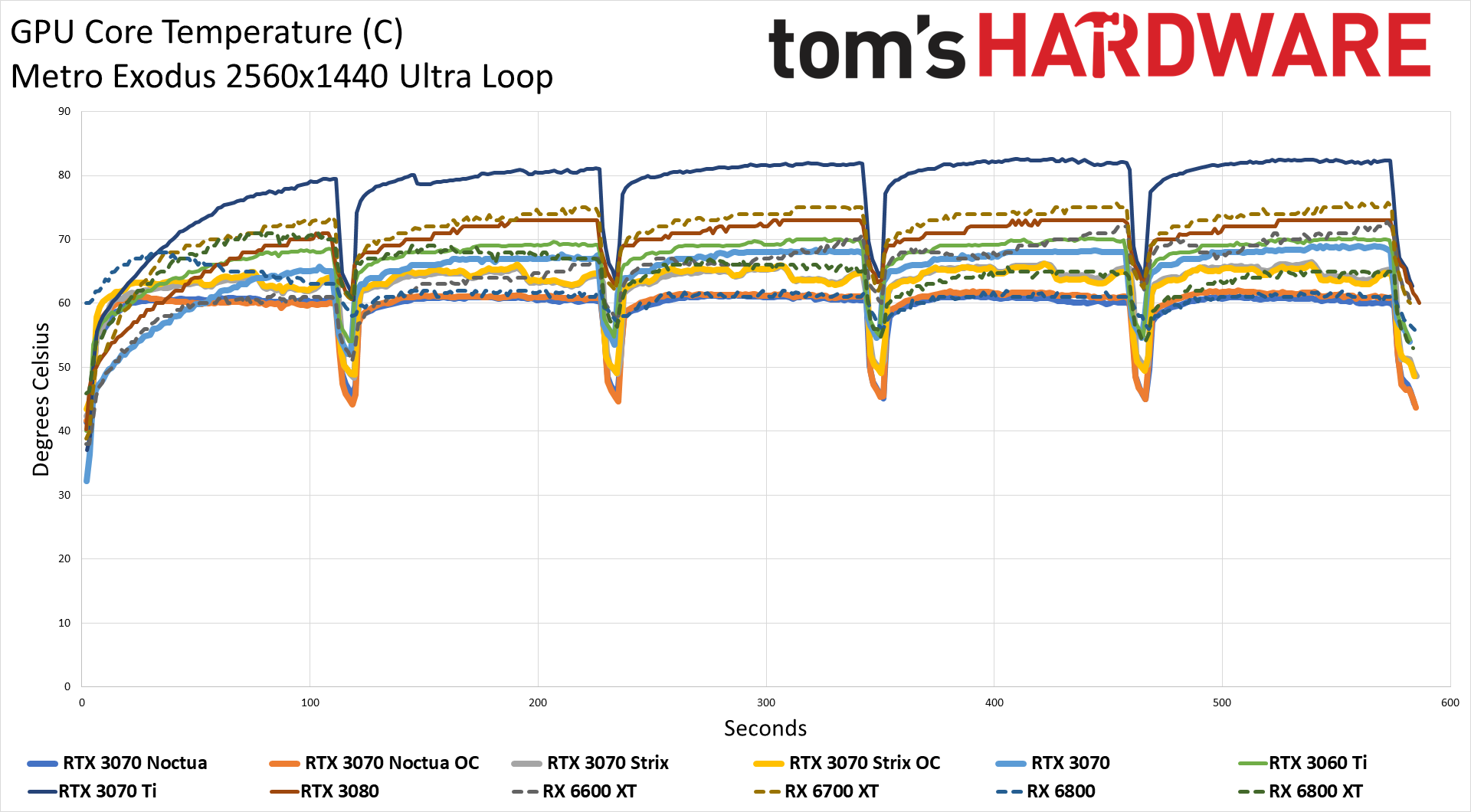
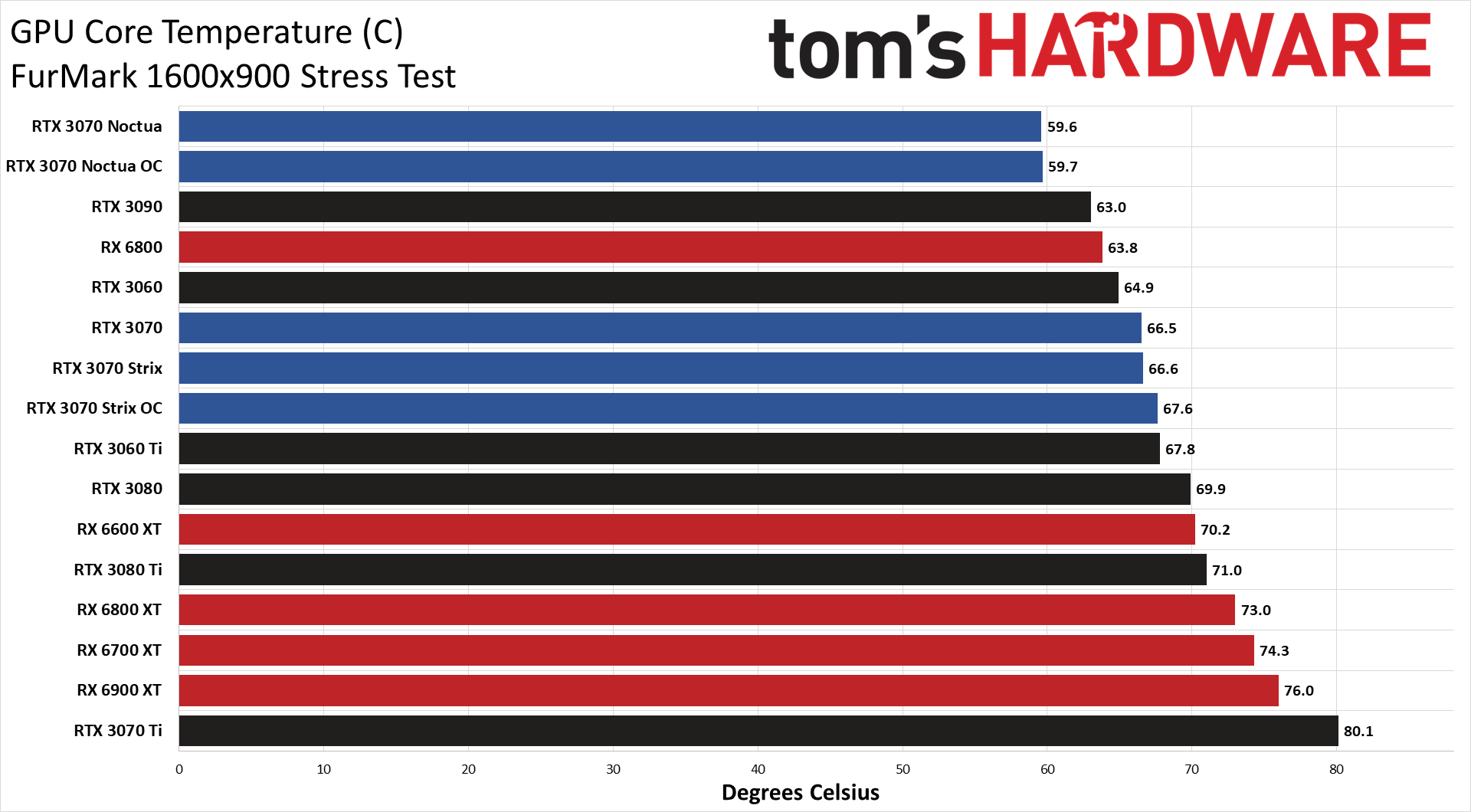
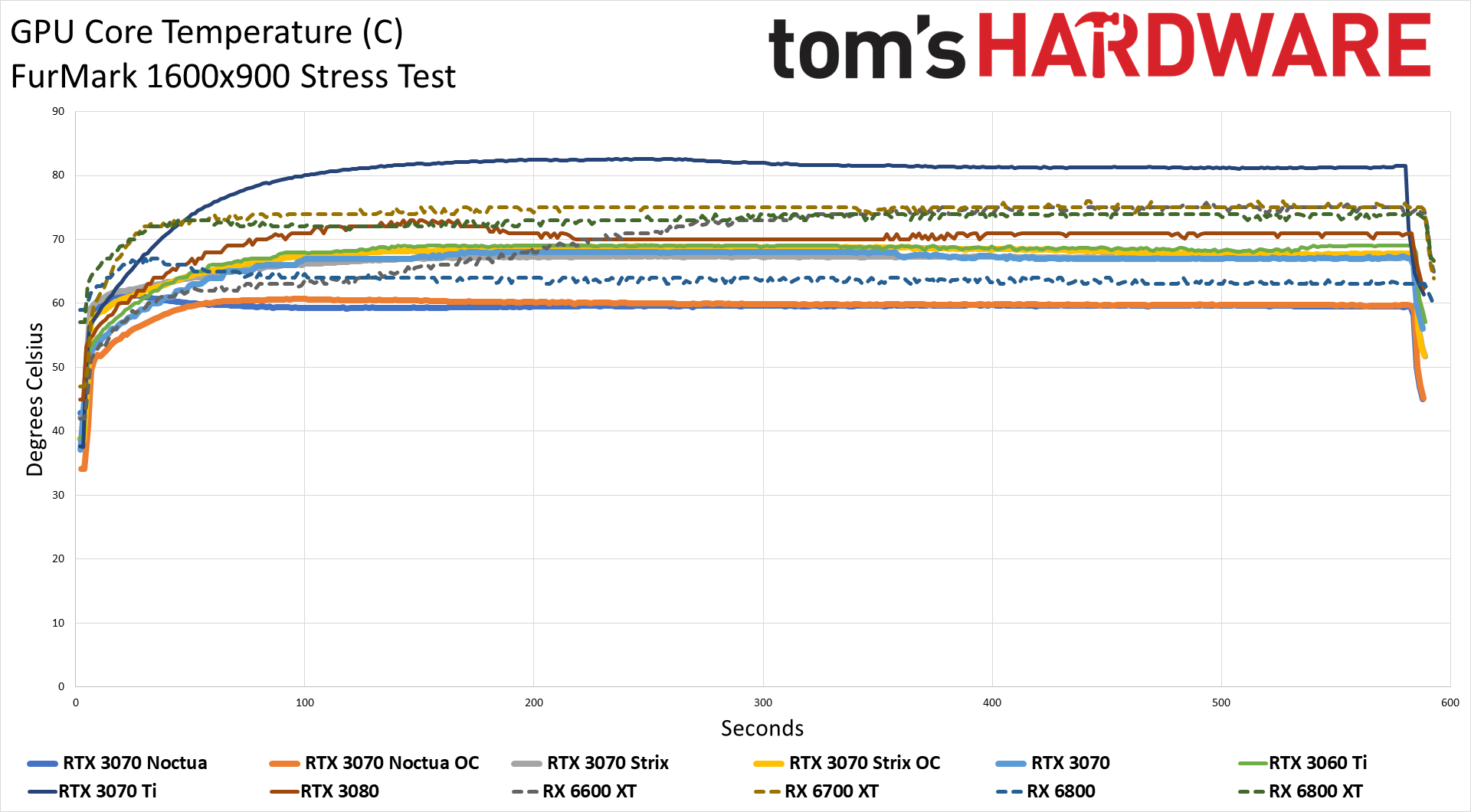
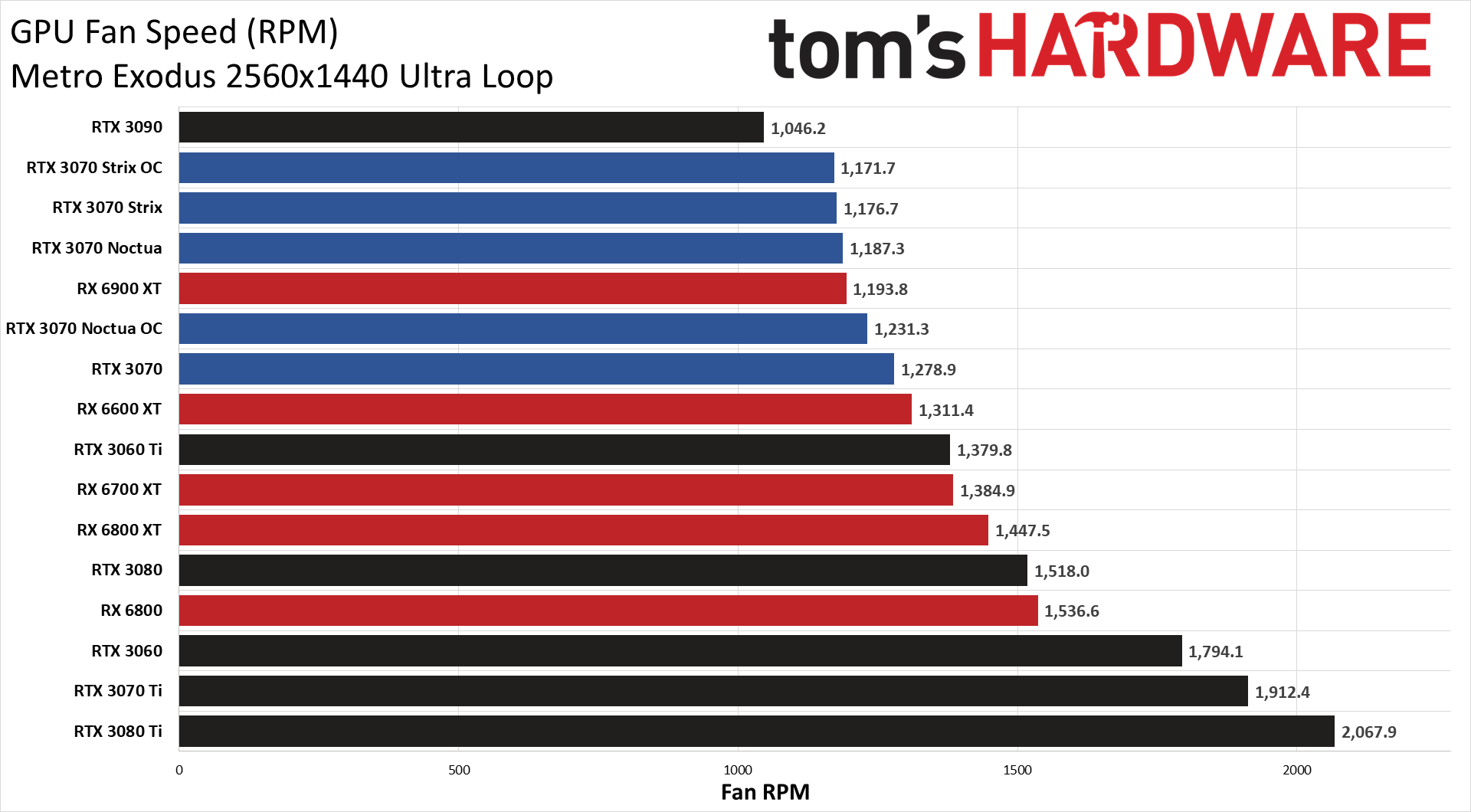
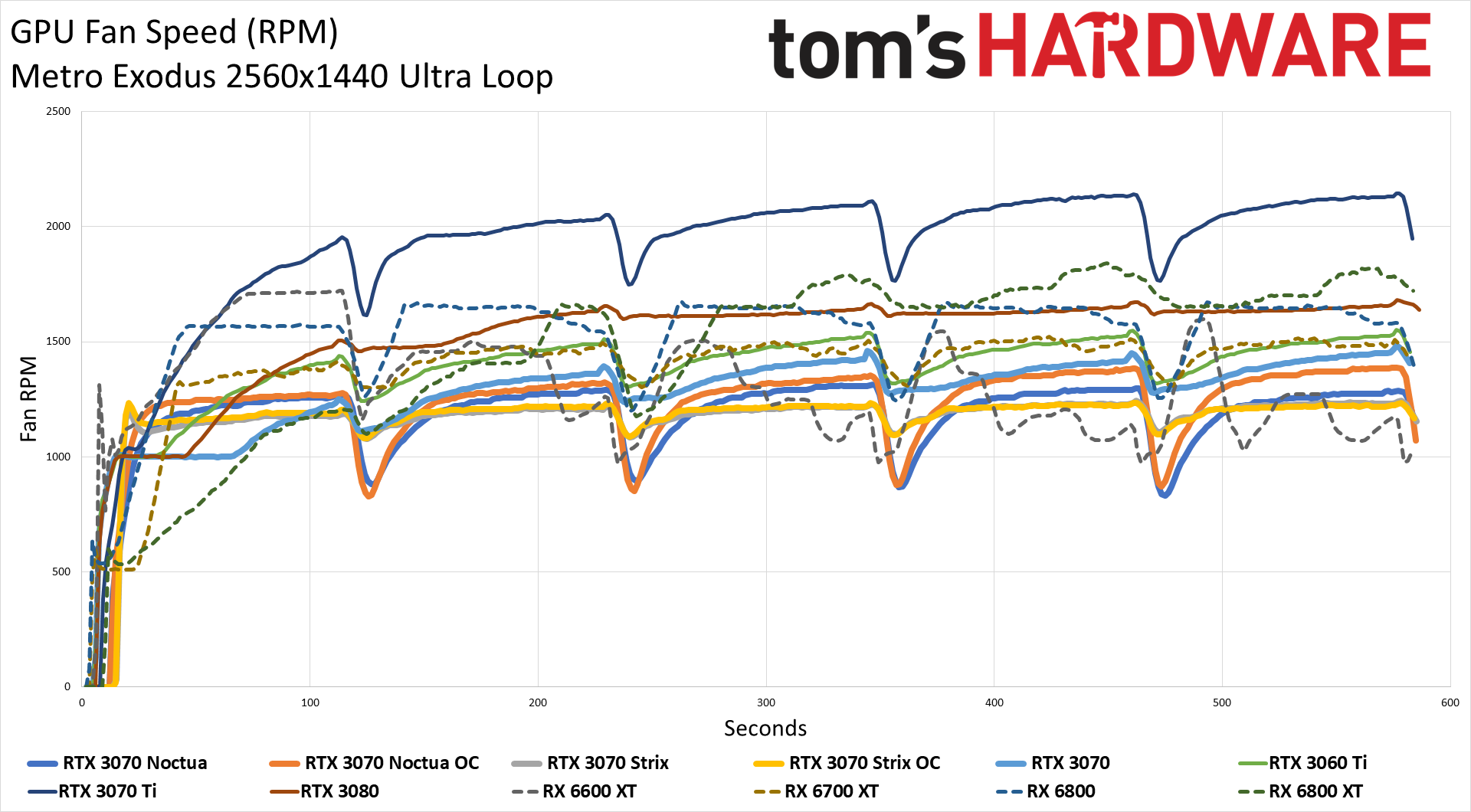
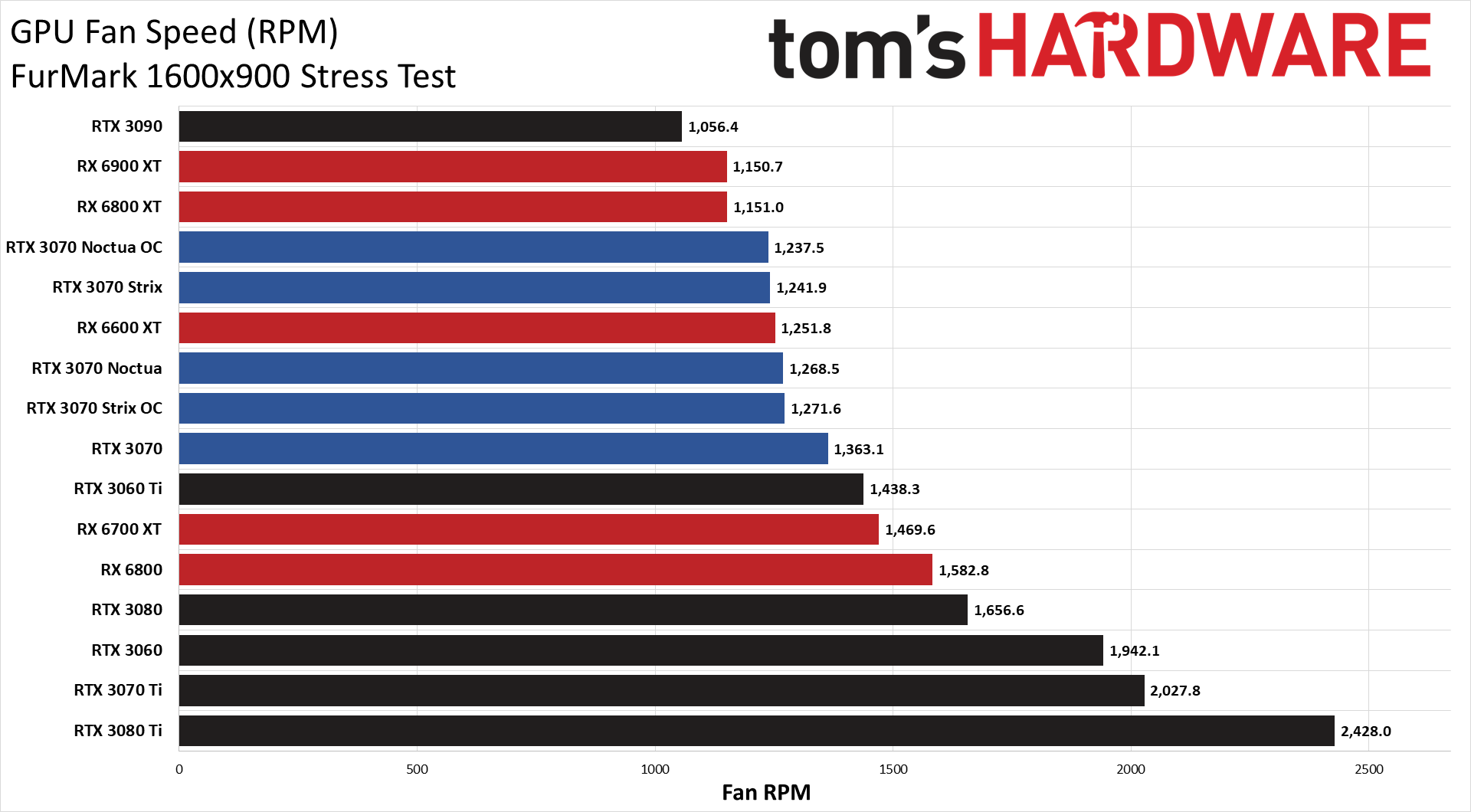
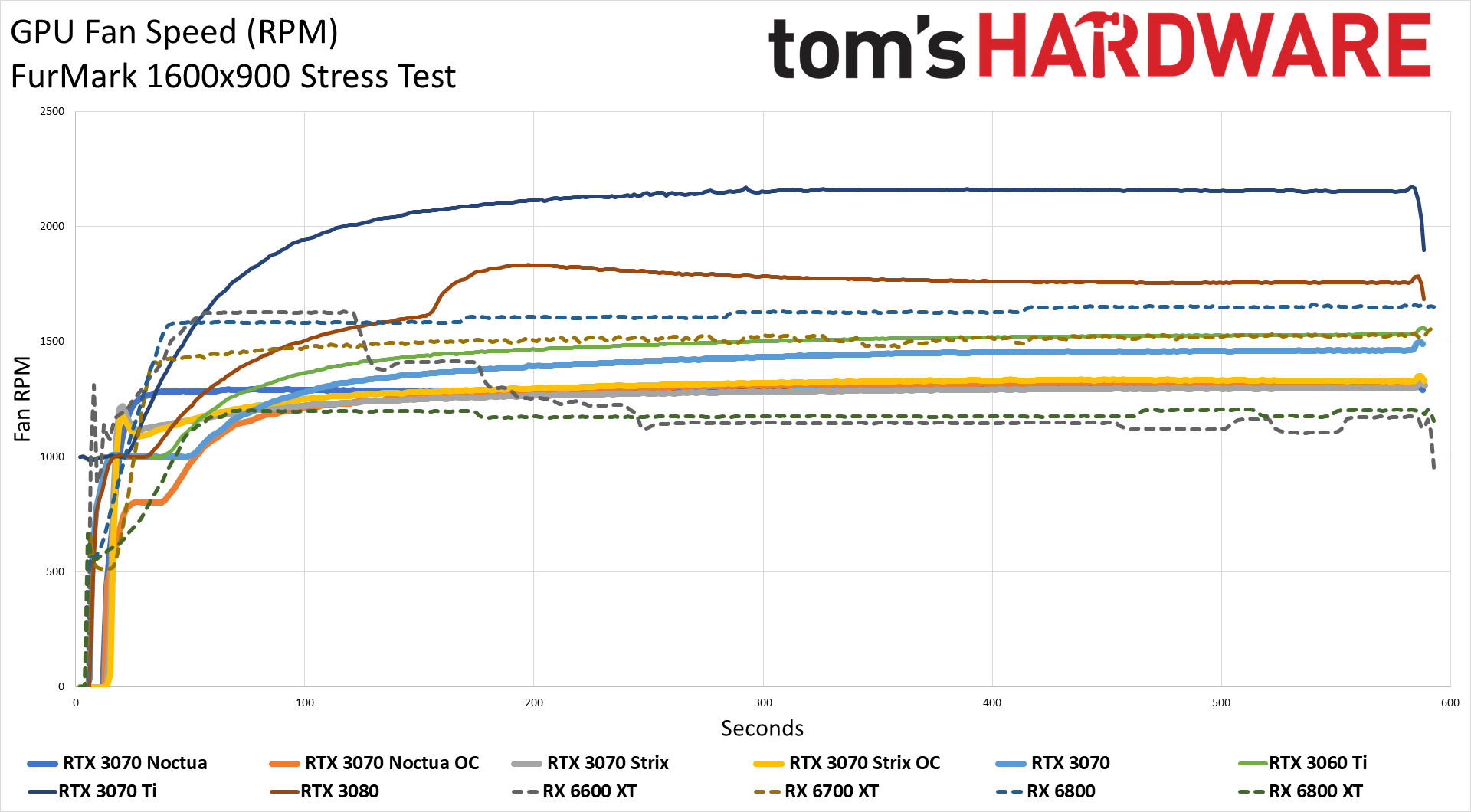
We've already discussed noise levels and touched on fan speeds, but here you can see the charts for fan speeds and temperatures. These are directly linked, so higher fan speeds at the same power use will drop temperatures, and vice versa. The Noctua has larger fans, meaning lower RPMs can still move more air. In the default mode looping Metro, it peaked at around 1200 RPM, while in OC mode it reached about 1250 RPM. The Strix by comparison ran its three fans at just 1200 RPM in either mode, while the reference 3070 hit about 1300 RPM. FurMark increased the fan speeds by 50–100 RPM for all of the 3070 cards.
More important than just the fan speeds are the temperatures. Here's where the Noctua card excelled. Even though fan speeds were about the same as the Strix model, temperatures were 5C–8C cooler — and didn't increase noticeably with the OC mode. The 3070 Founders Edition only ran slightly warmer, however, which is where the 3070 Noctua gets a bit confusing. Why use a 3070 instead of something higher, like a 3080 or even 3090?
Asus RTX 3070 Noctua: More Cooling Than Required
Asus and Noctua delivered the goods with the 3070 Noctua graphics card, at least in theory. The street price looks painfully high, almost to the point where you could buy a 3080 or 3080 Ti instead. Perhaps we'll see improved supply bring pricing down in the future, but we'd really only consider a $100 premium over a reference design as being appropriate for what you're getting — otherwise you're better off jumping up to the next higher GPU.
What's more, when looking at the thermals and fan speeds, the dual Noctua fans and large heatsink are overkill for a mere RTX 3070 GPU. The RTX 3070 Ti would benefit more, and we can't help but wonder what could have been done with an RTX 3080, 3080 Ti, or even 3090 GPU. Given the high price of the Asus 3070 Noctua, moving up to a higher tier GPU would make it easier to absorb the cost of the custom cooler, and we'd love to see such a design in the future — maybe Asus could even go for a triple 120mm fan model? That wouldn't even be that much larger than some of the other 3090 cards that are out there (looking at you, MSI RTX 3090 Suprim X).
As it stands, the Asus RTX 3070 Noctua ends up being positioned as something more for Noctua enthusiasts than typical gamers or even Asus fans. You can often find the Asus RTX 3070 Strix cards for a similar or even slightly lower price, and as we've shown in the benchmarks, those end up being a bit faster. If you like RGB bling, the Noctua is an even worse proposition. But if you want a brown and tan GPU that thumbs its nose at RGB? Yeah, this is a sweet-looking centerpiece for your gaming PC.
The current GPU price trends are still horrible, of course. The GeForce RTX 3070 was originally supposed to cost $500, and it would still be an awesome option at that price. $1,300 for a custom Asus design with an improved cooler and quiet fans? Sorry, but that's a hard pass, especially when there are rumors floating around of RTX 3070 Ti 16GB cards. At least those wouldn't run into VRAM bottlenecks, though we'll wait to see when and if those launch widely, and at what prices. More likely is that we'll see Nvidia's RTX 40-series Lovelace cards arrive before GPUs return to reasonable levels.
Overall, we like what Asus did with this Noctua card. Some people might think it looks boring, but to me it's beautiful — and very much out of my wallet's league. Hopefully later this year, Asus will bring us an RTX 4080 Noctua or similar that uses the same level of GPU as its Strix models, combining quiet fans with a higher performance GPU. Maybe it can even find a way to add some LEDs to the mix — which we'd naturally want to set to a color that would complement the brown color scheme.
MORE: Best Graphics Cards
MORE: GPU Benchmarks and Hierarchy
MORE: All Graphics Content

Jarred Walton is a senior editor at Tom's Hardware focusing on everything GPU. He has been working as a tech journalist since 2004, writing for AnandTech, Maximum PC, and PC Gamer. From the first S3 Virge '3D decelerators' to today's GPUs, Jarred keeps up with all the latest graphics trends and is the one to ask about game performance.
-
boju Chromax scheme would look good but then you wouldn't know its been Noctuarised at first glance since most fans are black.Reply -
thisisaname ReplyMore likely is that we'll see Nvidia's RTX 40-series Lovelace cards arrive before GPUs return to reasonable levels.
The sad statement that sums up the graphics card market right now.
Hopeful for the prices to come down but only a to "reasonable level" which while lower than todays prices they are still going to be quite a bit more than the RRP of todays cards! :mad: -
Third-Eye I don't really see why 3070 Noctua even exists when it's basically as fast the Asus Tuf. The extra cooling is wasted money when the Tuf runs at 55-65C when gaming, which is already vastly below thermal throttle limits unless your case has terrible airflow.Reply
Pure novelty that sells out before you even thought about buying it.